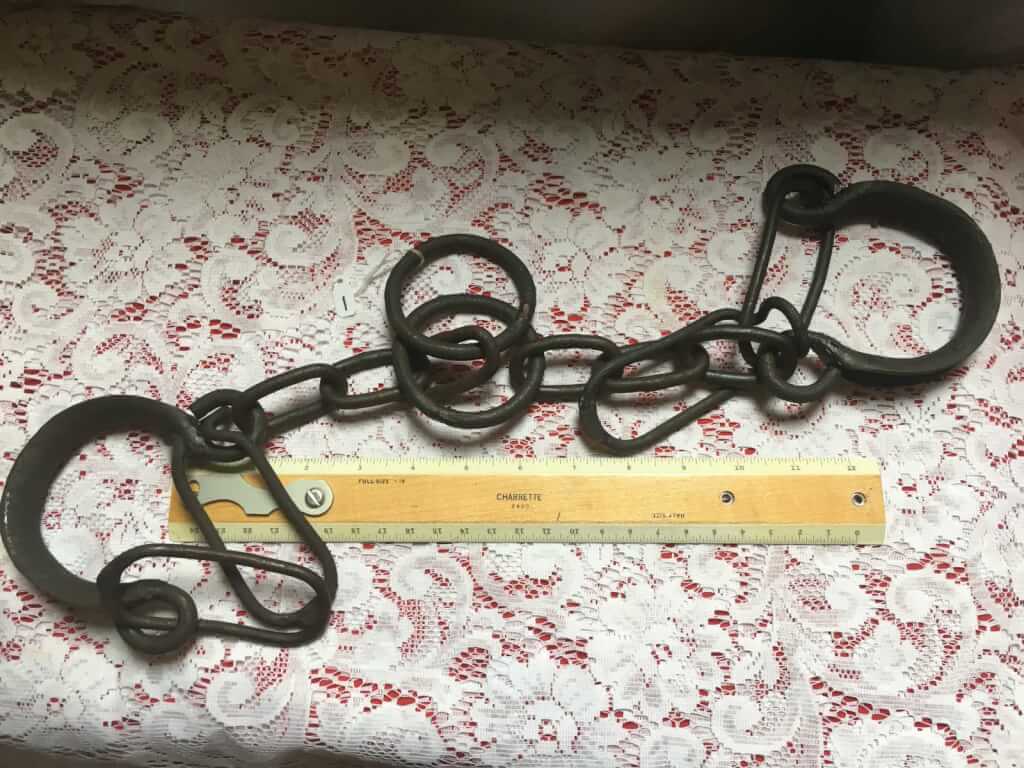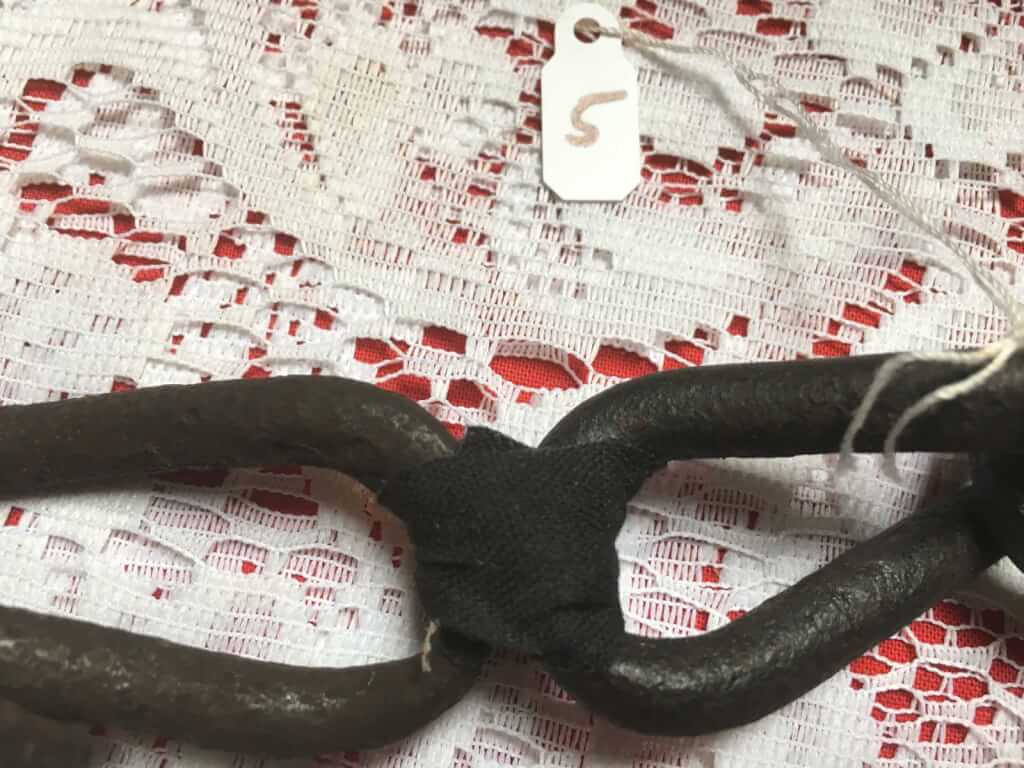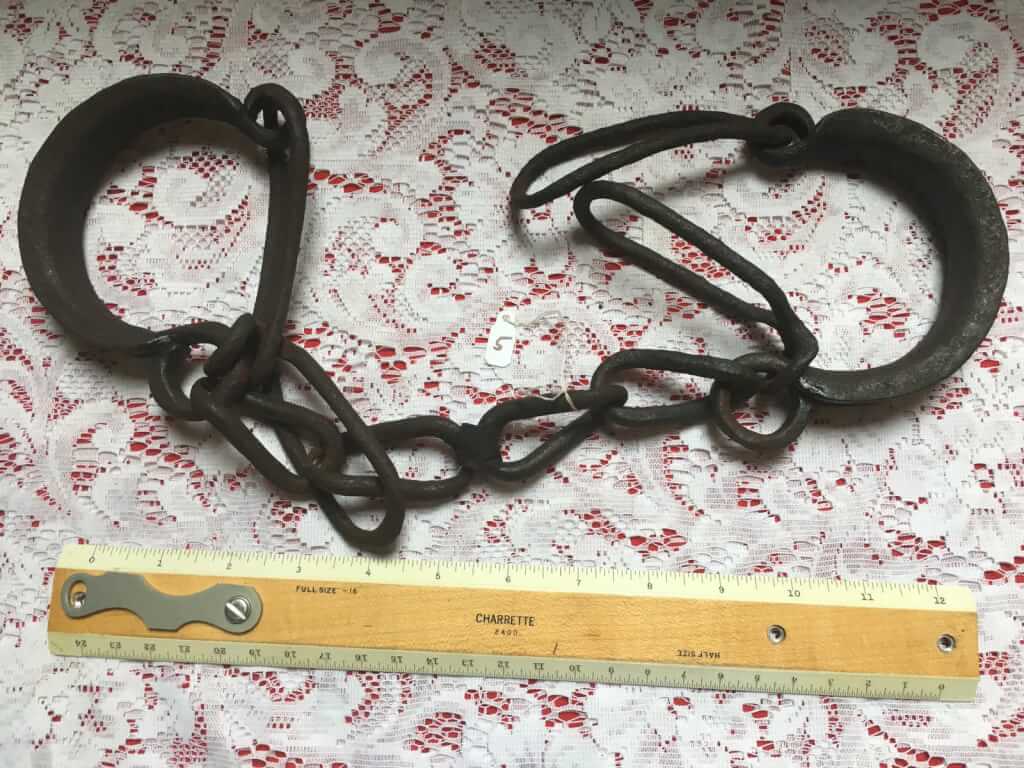-
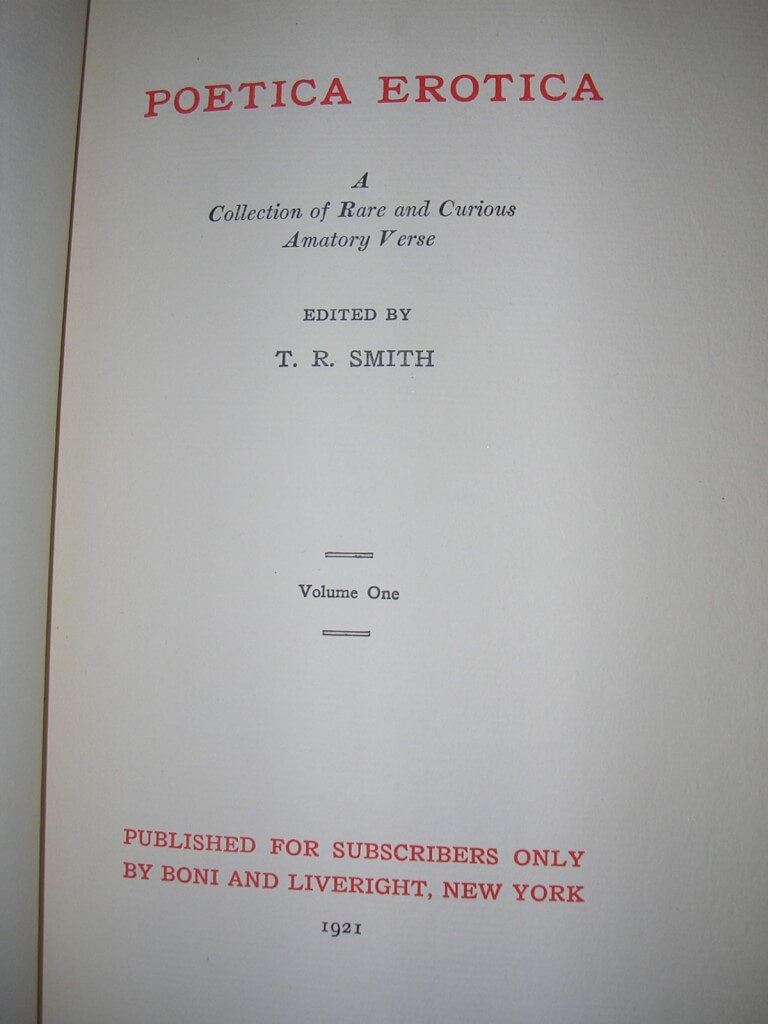
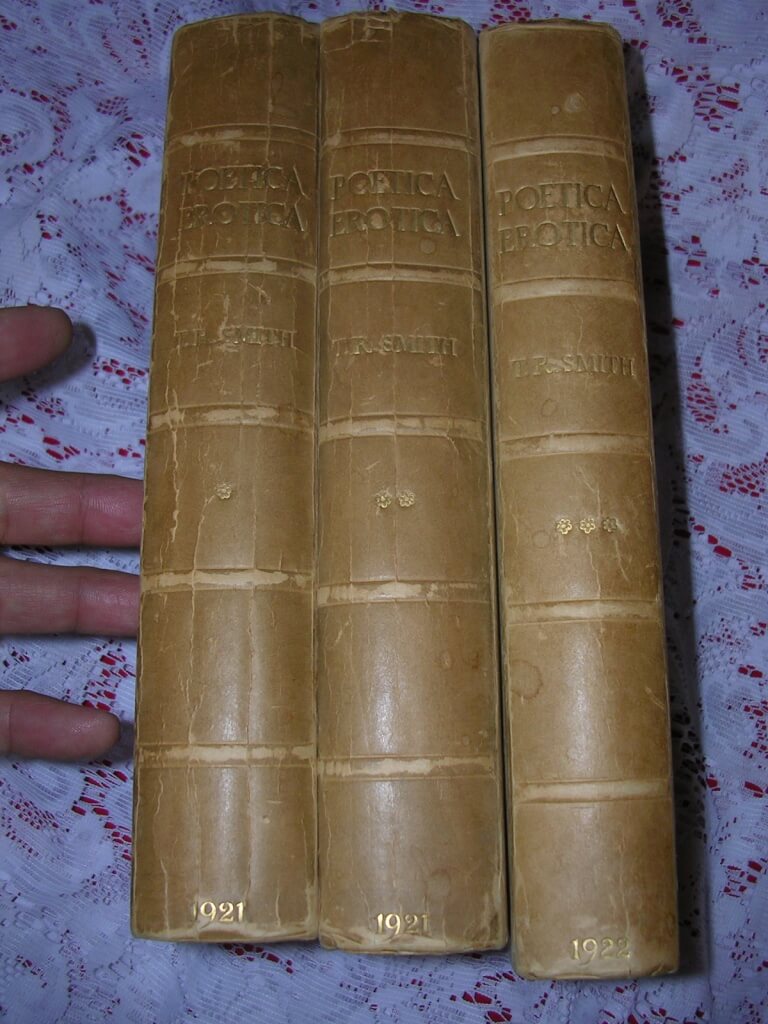 Poetica Erotica, T.R. Smith (editor) (Boni and Liveright, New York, 1921 (Vol. 3, 1922) [limited first edition, #523/1500]) 9 1/4" X 6 1/4", 3 vol. xxviii + 324, xvi + 328, xiv + 280, hardbound with green boards with cream vellum spines, deckle edges, corners bumped and worn, binding is tight, vol. 2 boards slightly loose. T. R. Smith writes "In these volumes Eros rules and Aphrodite guides the passionate motives....The poems contained in these volumes range from the earliest time to the present and the names of the most distinguished poets of yesterday and today will be found in the contents."
Poetica Erotica, T.R. Smith (editor) (Boni and Liveright, New York, 1921 (Vol. 3, 1922) [limited first edition, #523/1500]) 9 1/4" X 6 1/4", 3 vol. xxviii + 324, xvi + 328, xiv + 280, hardbound with green boards with cream vellum spines, deckle edges, corners bumped and worn, binding is tight, vol. 2 boards slightly loose. T. R. Smith writes "In these volumes Eros rules and Aphrodite guides the passionate motives....The poems contained in these volumes range from the earliest time to the present and the names of the most distinguished poets of yesterday and today will be found in the contents." -
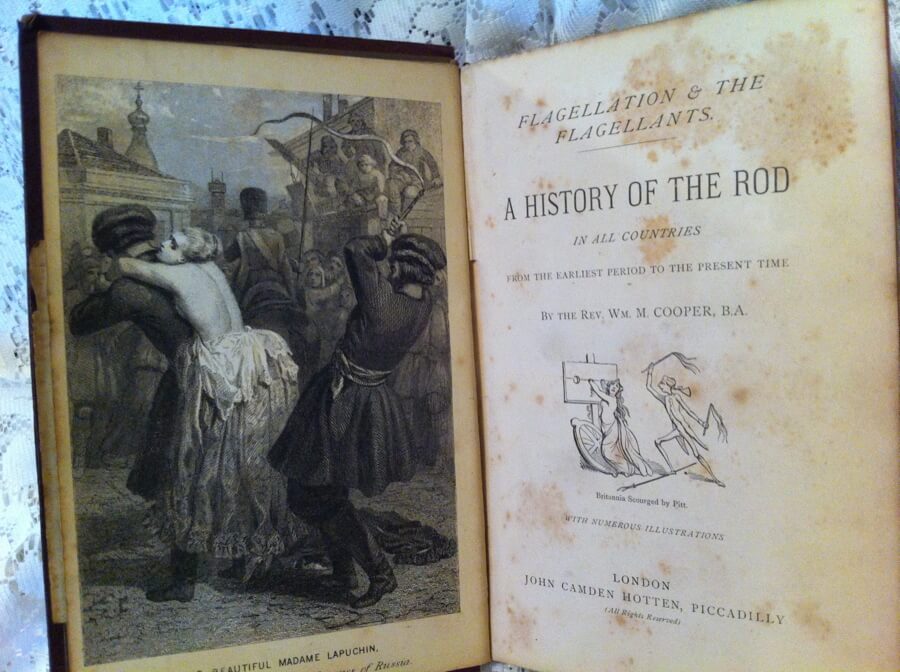
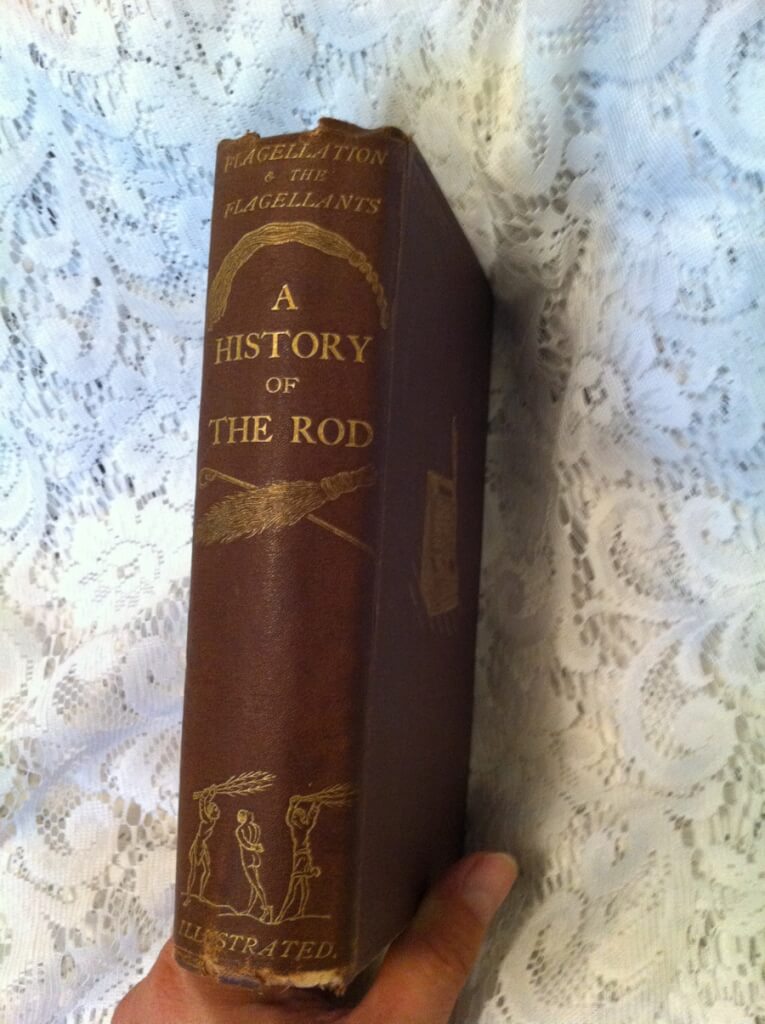 Flagellation & the Flagellants. a History of the Rod in All Countries, The Rev. Wm. M. Cooper, B.A. [James Glass Bertram] (John Camden Hotten, London, n.d. [1870, from ads at end of book]) 7 3/4" X 5 1/2", 544pp plus 32 pages of advertisements for "Very Important New Books", hardbound with red cloth, gilt lettering and decorations, spine worn at top and bottom and lower front, Binder's ticket on lower pastedown: "Bound by W. Bone and Son. 76 Fleet St. London E.C.", front pastdown has cute bookplate asking the book be returned to Robert Day, front end-paper has armorial bookplate of Robert Day. Good condition, corners bumped, top and bottom of spine worn, back boards loose but holding. Bertram was apprenticed to Tait's Edinburgh Magazine and became managing clerk, before joining a company of strolling players. He returned to Edinburgh and set up as a bookseller and newsagent. In 1855 he was appointed the editor of the North Briton and in 1872 of the Glasgow News, leaving to become a freelance journalist two years later. He published "flagellation" pornography under the names "Revd William Cooper" and "Margaret Anson". Illustrated throughout with a colored frontispiece. The bookplate is of Robert Day (1836_1914), an Irish antiquarian and photographer who collaborated with Franz Tieze in producing imitation Williamite, Jacobite and Irish Volunteer glassware. He was an important and well-travelled antiquarian collector. He was involved in his family's extensive saddlery business together with a sports shop well known to Cork anglers.
Flagellation & the Flagellants. a History of the Rod in All Countries, The Rev. Wm. M. Cooper, B.A. [James Glass Bertram] (John Camden Hotten, London, n.d. [1870, from ads at end of book]) 7 3/4" X 5 1/2", 544pp plus 32 pages of advertisements for "Very Important New Books", hardbound with red cloth, gilt lettering and decorations, spine worn at top and bottom and lower front, Binder's ticket on lower pastedown: "Bound by W. Bone and Son. 76 Fleet St. London E.C.", front pastdown has cute bookplate asking the book be returned to Robert Day, front end-paper has armorial bookplate of Robert Day. Good condition, corners bumped, top and bottom of spine worn, back boards loose but holding. Bertram was apprenticed to Tait's Edinburgh Magazine and became managing clerk, before joining a company of strolling players. He returned to Edinburgh and set up as a bookseller and newsagent. In 1855 he was appointed the editor of the North Briton and in 1872 of the Glasgow News, leaving to become a freelance journalist two years later. He published "flagellation" pornography under the names "Revd William Cooper" and "Margaret Anson". Illustrated throughout with a colored frontispiece. The bookplate is of Robert Day (1836_1914), an Irish antiquarian and photographer who collaborated with Franz Tieze in producing imitation Williamite, Jacobite and Irish Volunteer glassware. He was an important and well-travelled antiquarian collector. He was involved in his family's extensive saddlery business together with a sports shop well known to Cork anglers. -
Out of stock
 Emmanuelle, Bianca, and Venus in Furs, Emmanuelle Arsan, Leopold von Sacher-Masoch, Guido Crepax, introduction by Paolo Caneppelle and Günter Krenn [Evergreen/Benedikt Taschen Verlag GmbH, 2000, Germany, 1st edition thus] 8 x 10.5", 463pp, Hardcover w/DJ, red boards with white lettering, like-new condition. Published in 2000, and nolonger in print, designed by Lambert & Lambert, this edition has become rare and sought after. It was published with another volume “Justine and The Story of O”. This book has three of Crepax’s graphic novels. All three (like most of Crepax’s works) are very sexually graphic stories of sexual self-discovery under varying circumstances. Guido Crepas (1933-2003), better known by his nom de plume Guido Crepax, was an Italian comics artist. He is most famous for his character Valentina, created in 1965 and very representative of the spirit of the 1960s. The Valentina series of books and strips became noted for Crepax's sophisticated drawing, and for the psychedelic, dreamlike storylines, generally involving a strong dose of erotism. Marayat Rollet-Andriane formerly Marayat Krasaesin (1932-2005), known by the pen name Emmanuelle Arsan, was a French novelist of Thai origin, best known for the novel featuring the fictional character Emmanuelle, a woman who sets out on a voyage of sexual self-discovery under varying circumstances. It was later claimed that the real author of the book was her husband, Louis-Jacques Rollet-Andriane. The novel Emmanuelle was initially published and distributed clandestinely in France in 1959, without an author's name. Successive editions were ascribed to Emmanuelle Arsan, who was subsequently revealed to be Marayat Rollet-Andriane. Though the novel was sometimes hinted to be quasi-autobiographical, it was later revealed that the actual author was her husband Louis-Jacques Rollet-Andriane. Several more novels were published under the Emmanuelle Arsan pseudonym. Venus in Furs (German: Venus im Pelz) is a novella by Leopold Ritter von Sacher-Masoch (1836-1895), an Austrian writer and journalist. It is now his best known work and because of its themes the term masochism is derived from his name, coined by the Austrian psychiatrist, Krafft-Ebing. The novel was to be part of an epic series that Sacher-Masoch envisioned called Legacy of Cain. Venus in Furs was part of Love, the first volume of the series. It was published in 1870. The novel draws themes, like female dominance and sadomasochism, and character inspiration heavily from Sacher-Masoch's own life. Wanda von Dunajew, the novel's central female character, was modelled after his mistress Baroness Fanny Pistor. In December 1869 the two signed a contract making him her slave for a period of 6 months. In 1873, after the publication of Venus in Furs, Sacher-Masoch married Aurora von Rümelin who he pressured to continue the lifestyle he wrote about in his book. After 10 years they divorced. Rümelin, using the pseudonym of the books title character, "Wanda von Dunajew", wrote Meine Lebensbeichte (My Life Confession) published in 1906. It detailed Sacher-Masoch's private life and her relationship with him. During his lifetime, Sacher-Masoch was well known as a man of letters, a utopian thinker who espoused socialist and humanist ideals in his fiction and non-fiction. Most of his works remain untranslated into English. Until recently, his novel Venus in Furs was his only book commonly available in English.
Emmanuelle, Bianca, and Venus in Furs, Emmanuelle Arsan, Leopold von Sacher-Masoch, Guido Crepax, introduction by Paolo Caneppelle and Günter Krenn [Evergreen/Benedikt Taschen Verlag GmbH, 2000, Germany, 1st edition thus] 8 x 10.5", 463pp, Hardcover w/DJ, red boards with white lettering, like-new condition. Published in 2000, and nolonger in print, designed by Lambert & Lambert, this edition has become rare and sought after. It was published with another volume “Justine and The Story of O”. This book has three of Crepax’s graphic novels. All three (like most of Crepax’s works) are very sexually graphic stories of sexual self-discovery under varying circumstances. Guido Crepas (1933-2003), better known by his nom de plume Guido Crepax, was an Italian comics artist. He is most famous for his character Valentina, created in 1965 and very representative of the spirit of the 1960s. The Valentina series of books and strips became noted for Crepax's sophisticated drawing, and for the psychedelic, dreamlike storylines, generally involving a strong dose of erotism. Marayat Rollet-Andriane formerly Marayat Krasaesin (1932-2005), known by the pen name Emmanuelle Arsan, was a French novelist of Thai origin, best known for the novel featuring the fictional character Emmanuelle, a woman who sets out on a voyage of sexual self-discovery under varying circumstances. It was later claimed that the real author of the book was her husband, Louis-Jacques Rollet-Andriane. The novel Emmanuelle was initially published and distributed clandestinely in France in 1959, without an author's name. Successive editions were ascribed to Emmanuelle Arsan, who was subsequently revealed to be Marayat Rollet-Andriane. Though the novel was sometimes hinted to be quasi-autobiographical, it was later revealed that the actual author was her husband Louis-Jacques Rollet-Andriane. Several more novels were published under the Emmanuelle Arsan pseudonym. Venus in Furs (German: Venus im Pelz) is a novella by Leopold Ritter von Sacher-Masoch (1836-1895), an Austrian writer and journalist. It is now his best known work and because of its themes the term masochism is derived from his name, coined by the Austrian psychiatrist, Krafft-Ebing. The novel was to be part of an epic series that Sacher-Masoch envisioned called Legacy of Cain. Venus in Furs was part of Love, the first volume of the series. It was published in 1870. The novel draws themes, like female dominance and sadomasochism, and character inspiration heavily from Sacher-Masoch's own life. Wanda von Dunajew, the novel's central female character, was modelled after his mistress Baroness Fanny Pistor. In December 1869 the two signed a contract making him her slave for a period of 6 months. In 1873, after the publication of Venus in Furs, Sacher-Masoch married Aurora von Rümelin who he pressured to continue the lifestyle he wrote about in his book. After 10 years they divorced. Rümelin, using the pseudonym of the books title character, "Wanda von Dunajew", wrote Meine Lebensbeichte (My Life Confession) published in 1906. It detailed Sacher-Masoch's private life and her relationship with him. During his lifetime, Sacher-Masoch was well known as a man of letters, a utopian thinker who espoused socialist and humanist ideals in his fiction and non-fiction. Most of his works remain untranslated into English. Until recently, his novel Venus in Furs was his only book commonly available in English. -
 Musée Royal de Naples. Peintures, bronzes et statues érotiques du Cabinet Secret, avec leur explication par M. C. F., contenant soixante gravures. (Au cercle du livre précieux, Paris, 1959, #209/2500) 12.25" X 9.25", xxx-152pp, loosely contained by paper wraps in a blue slipcase, good condition, some fading, bumping and peeling to slipcase, interior pages are mint condition. This is a republishing of the 1836 portfolio of the "secret cabinet" erotic works of the Museum of Naples. It was published privately for circulation among member of "Au cercle du livre précieux" [circle of the precious book] to avoid prosecution for indecency. There are full-page descriptions of the works and then 60 illustrations on coral colored paper. The pages are unbound and contained in a slipcase.
Musée Royal de Naples. Peintures, bronzes et statues érotiques du Cabinet Secret, avec leur explication par M. C. F., contenant soixante gravures. (Au cercle du livre précieux, Paris, 1959, #209/2500) 12.25" X 9.25", xxx-152pp, loosely contained by paper wraps in a blue slipcase, good condition, some fading, bumping and peeling to slipcase, interior pages are mint condition. This is a republishing of the 1836 portfolio of the "secret cabinet" erotic works of the Museum of Naples. It was published privately for circulation among member of "Au cercle du livre précieux" [circle of the precious book] to avoid prosecution for indecency. There are full-page descriptions of the works and then 60 illustrations on coral colored paper. The pages are unbound and contained in a slipcase. -
 Mademoiselle De Maupin – Double Love, Theophile Gautier, illus. Clara Tice (Privately Printed for The Pierre Loüys Society, 1927 #67/1250) 6.5″x10″, 407pp., black spine over decorated boards, gilt titles and decorations on spine, binding loose but holding. In September 1833, Gautier was solicited to write a historical romance based on the life of French opera star Mlle. Maupin, who was a first-rate swordswoman and often went about disguised as a man. Originally, the story was to be about the historical La Maupin, who set fire to a convent for the love of another woman, but later retired to a convent herself, shortly before dying in her thirties. Gautier instead turned the plot into a simple love triangle between a man, d'Albert, and his mistress, Rosette, who both fall in love with Madelaine de Maupin, who is disguised as a man named Théodore. The message behind Gautier's version of the infamous legend is the fundamental pessimism about the human identity, and perhaps the entire Romantic age. The novel consists of seventeen chapters, most in the form of letters written by d'Albert or Madelaine. Most critics focus on the preface of the novel, which preached about art for art's sake through its dictum that "everything useful is ugly". Pierre Jules Théophile Gautier (1811 – 1872) was a French poet, dramatist, novelist, journalist, and art and literary critic. While an ardent defender of Romanticism, Gautier's work is difficult to classify and remains a point of reference for many subsequent literary traditions such as Parnassianism, Symbolism, Decadence and Modernism. He was widely esteemed by writers as disparate as Balzac, Baudelaire, the Goncourt brothers, Flaubert, Pound, Eliot, James, Proust and Wilde.
Mademoiselle De Maupin – Double Love, Theophile Gautier, illus. Clara Tice (Privately Printed for The Pierre Loüys Society, 1927 #67/1250) 6.5″x10″, 407pp., black spine over decorated boards, gilt titles and decorations on spine, binding loose but holding. In September 1833, Gautier was solicited to write a historical romance based on the life of French opera star Mlle. Maupin, who was a first-rate swordswoman and often went about disguised as a man. Originally, the story was to be about the historical La Maupin, who set fire to a convent for the love of another woman, but later retired to a convent herself, shortly before dying in her thirties. Gautier instead turned the plot into a simple love triangle between a man, d'Albert, and his mistress, Rosette, who both fall in love with Madelaine de Maupin, who is disguised as a man named Théodore. The message behind Gautier's version of the infamous legend is the fundamental pessimism about the human identity, and perhaps the entire Romantic age. The novel consists of seventeen chapters, most in the form of letters written by d'Albert or Madelaine. Most critics focus on the preface of the novel, which preached about art for art's sake through its dictum that "everything useful is ugly". Pierre Jules Théophile Gautier (1811 – 1872) was a French poet, dramatist, novelist, journalist, and art and literary critic. While an ardent defender of Romanticism, Gautier's work is difficult to classify and remains a point of reference for many subsequent literary traditions such as Parnassianism, Symbolism, Decadence and Modernism. He was widely esteemed by writers as disparate as Balzac, Baudelaire, the Goncourt brothers, Flaubert, Pound, Eliot, James, Proust and Wilde. -
 The Ragionamenti or dialogues of the devine Pietro Aretino, Pietro Aretino, trans. Isidore Liseux (Isidore Liseux, Paris, 1889) 8.25" X 6", 6 volumes, xxxv+83pp, 89pp, 100pp, 134pp, 129pp, 138pp, original publishers paper wraps in just good condition with chipping at the top and bottom of the spine on some volumes, internal pages in mint condition, protective cover with green boards in fair condition, some joints loose and cloth peeling away, edges deckled, ex-libris of E. M. Schnadig Pietro Aretino (1492-1556) was one of the most important figures in Italian Renaissance literature, and certainly the most controversial. Condemned by some as a pornographer, his infamy was due largely to his use of explicit sexuality and the vulgar tongue of ordinary speech in much of his work. Dialogues center around a conversation between two rather frank, experienced, and sharp-tongued women on the topic of women’s occupations. We learn that at the time there were only three: wife, whore, or nun. Their discussion is a rollicking account of the advantages, perils, and pleasures each profession offers. Not only was Dialogues the first erotic book in the Christian world to be written in the common vernacular, it was but one of the few to describe the obscenity of commercial love, and is thus a cornerstone of both Italian literature and Counter-Renaissance vigour. First dialog: The Life of Nuns Second dialog: The Life of Married Women Third dialog: The Life of Courtesans Fourth dialog: The Education of Pippa Fifth dialog: The Wiles of Men Sixth dialog: The Bawd’s Trade Isidore Liseux (1835-1894) was a French bibliophile and publisher of erotica and curiosa. His publications were mostly rare texts of 16th to 18th century authors, hard to find and little known books which were usually translated and annotated by his friend and associate Alcide Bonneau or by Liseux himself. Liseux and Bonneau, both ex-priests, knew each other since seminary. His books were published in small numbers, on high quality paper, and with excellent typography. His usual printers were Claude Motteroz, Antoine Bécus, and later Charles Unsinger. Liseux’s books were published openly as the climate was more permissive in Paris at the time. His books were so well regarded that pirates of his books and even unrelated books bearing his imprint with a false date were published clandestinely into the 20th century. French poet, Guillaume Apollinaire wrote: “The publications of Liseux are more and more sought after because they are correct, beautiful and rare.” (Le flaneur des deux rives, 1918).
The Ragionamenti or dialogues of the devine Pietro Aretino, Pietro Aretino, trans. Isidore Liseux (Isidore Liseux, Paris, 1889) 8.25" X 6", 6 volumes, xxxv+83pp, 89pp, 100pp, 134pp, 129pp, 138pp, original publishers paper wraps in just good condition with chipping at the top and bottom of the spine on some volumes, internal pages in mint condition, protective cover with green boards in fair condition, some joints loose and cloth peeling away, edges deckled, ex-libris of E. M. Schnadig Pietro Aretino (1492-1556) was one of the most important figures in Italian Renaissance literature, and certainly the most controversial. Condemned by some as a pornographer, his infamy was due largely to his use of explicit sexuality and the vulgar tongue of ordinary speech in much of his work. Dialogues center around a conversation between two rather frank, experienced, and sharp-tongued women on the topic of women’s occupations. We learn that at the time there were only three: wife, whore, or nun. Their discussion is a rollicking account of the advantages, perils, and pleasures each profession offers. Not only was Dialogues the first erotic book in the Christian world to be written in the common vernacular, it was but one of the few to describe the obscenity of commercial love, and is thus a cornerstone of both Italian literature and Counter-Renaissance vigour. First dialog: The Life of Nuns Second dialog: The Life of Married Women Third dialog: The Life of Courtesans Fourth dialog: The Education of Pippa Fifth dialog: The Wiles of Men Sixth dialog: The Bawd’s Trade Isidore Liseux (1835-1894) was a French bibliophile and publisher of erotica and curiosa. His publications were mostly rare texts of 16th to 18th century authors, hard to find and little known books which were usually translated and annotated by his friend and associate Alcide Bonneau or by Liseux himself. Liseux and Bonneau, both ex-priests, knew each other since seminary. His books were published in small numbers, on high quality paper, and with excellent typography. His usual printers were Claude Motteroz, Antoine Bécus, and later Charles Unsinger. Liseux’s books were published openly as the climate was more permissive in Paris at the time. His books were so well regarded that pirates of his books and even unrelated books bearing his imprint with a false date were published clandestinely into the 20th century. French poet, Guillaume Apollinaire wrote: “The publications of Liseux are more and more sought after because they are correct, beautiful and rare.” (Le flaneur des deux rives, 1918). -
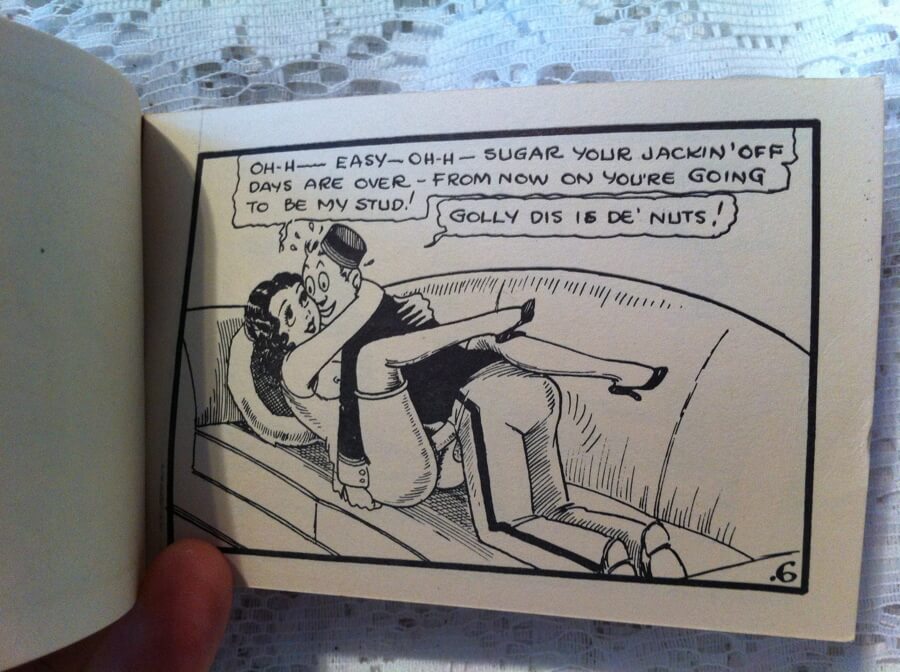
 Ginger Rogers in "Hot Panties", (n.p. n.d.) 4.5" x 3", 8pp. pamphlet, stapled Tijuana bibles (also known as eight-pagers, bluesies, gray-backs, Jiggs-and-Maggie books, jo-jo books, Tillie-and-Mac books, and two-by-fours) were little pornographic comic books produced in the United States from the 1920s to the early 1960s.
Ginger Rogers in "Hot Panties", (n.p. n.d.) 4.5" x 3", 8pp. pamphlet, stapled Tijuana bibles (also known as eight-pagers, bluesies, gray-backs, Jiggs-and-Maggie books, jo-jo books, Tillie-and-Mac books, and two-by-fours) were little pornographic comic books produced in the United States from the 1920s to the early 1960s. -
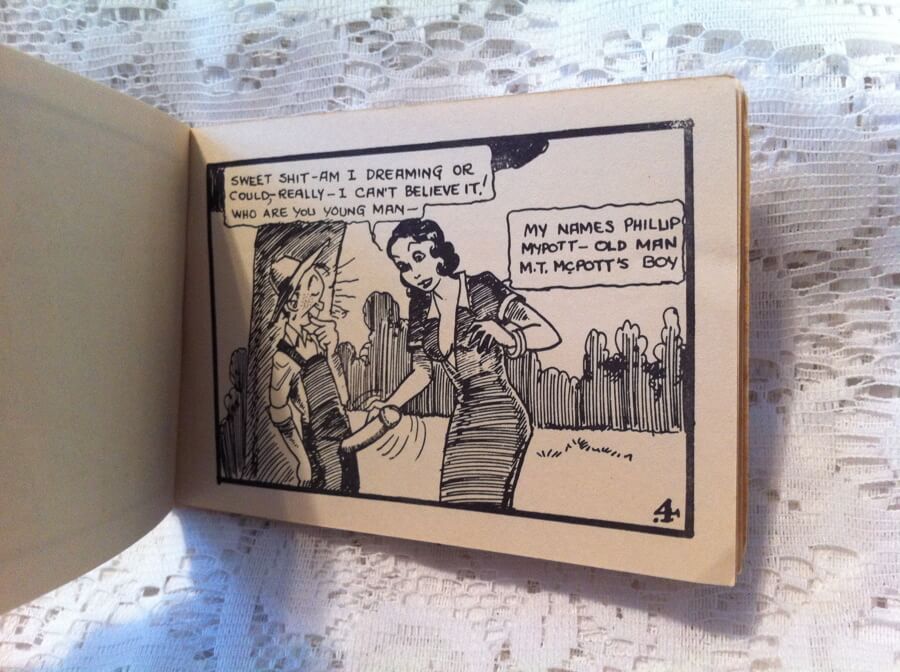
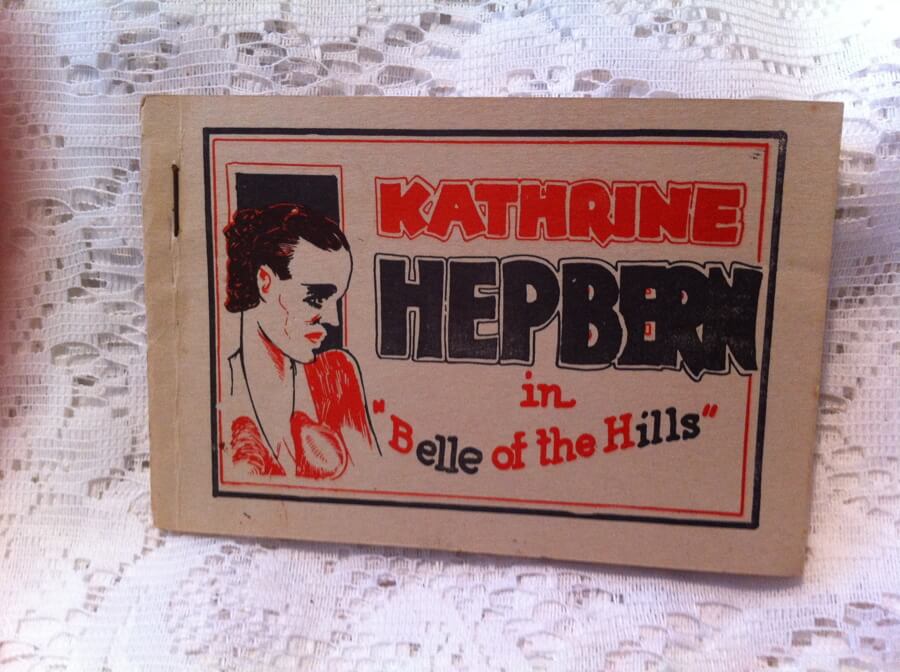 Katherine Hepbern in "Belle of the Hills", (n.p. n.d.) 4.5" x 3", 8pp. pamphlet, stapled Tijuana bibles (also known as eight-pagers, bluesies, gray-backs, Jiggs-and-Maggie books, jo-jo books, Tillie-and-Mac books, and two-by-fours) were little pornographic comic books produced in the United States from the 1920s to the early 1960s.
Katherine Hepbern in "Belle of the Hills", (n.p. n.d.) 4.5" x 3", 8pp. pamphlet, stapled Tijuana bibles (also known as eight-pagers, bluesies, gray-backs, Jiggs-and-Maggie books, jo-jo books, Tillie-and-Mac books, and two-by-fours) were little pornographic comic books produced in the United States from the 1920s to the early 1960s. -
Out of stock
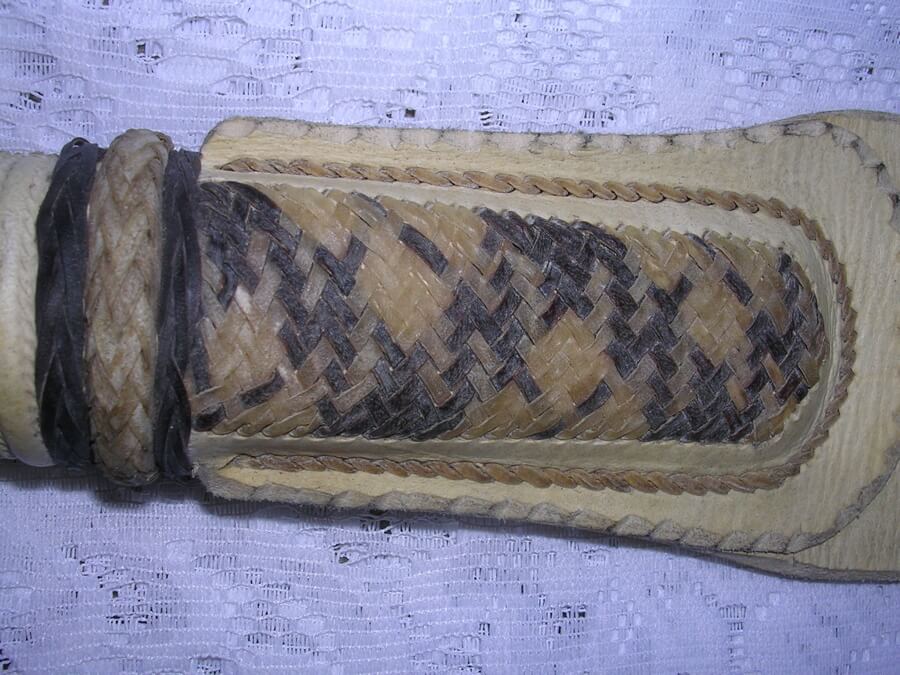
 White Rebenque 23" long, flap is 12", white leather with rawhide/sinew stitching and decorations, slight yellowing from age. Beautiful hand-made white leather rebenque 50+ years old. It has decorative rawhide work on the handle and on the strap, using two colors of rawhide. The handle is textured by wrapping a wet cord around it, leaving an imprint on the leather. Rebenque is the name in Brazilian Portuguese for a type of whip used by gauchos in South America. Especially in Argentina, it is the traditional riding, fighting, and punishing whip of the gaucho. It consists of a rawhide wrapped wooden handle with a thong made of a leather strap a little longer than the handle. The wide strap made the rebenque an instrument less severe on the horse than the European riding crop. As the gaucho was never far from the horse, the rebenque was always on him. When not in use, he made a knot with the strap and held the rebenque lazily by the wrist strap with the middle fingers of his hand, or hung it from the handle of his facón knife (as he used the large knife almost horizontally at his back, held by the belt or waistband, the handle protruded from his right side). The rebenque was used also for fighting, as a weapon by itself, when the fight did not merit a knife, or with the strap rolled on his left hand and the handle hanging, as a secondary weapon to the knife in his right hand. Of course, it was also used for domestic punishments, and for quasi-judicial chastisement. A couple of lashes with the rebenque on the bare legs were widely used as a punishment for children, even in the urban areas.
White Rebenque 23" long, flap is 12", white leather with rawhide/sinew stitching and decorations, slight yellowing from age. Beautiful hand-made white leather rebenque 50+ years old. It has decorative rawhide work on the handle and on the strap, using two colors of rawhide. The handle is textured by wrapping a wet cord around it, leaving an imprint on the leather. Rebenque is the name in Brazilian Portuguese for a type of whip used by gauchos in South America. Especially in Argentina, it is the traditional riding, fighting, and punishing whip of the gaucho. It consists of a rawhide wrapped wooden handle with a thong made of a leather strap a little longer than the handle. The wide strap made the rebenque an instrument less severe on the horse than the European riding crop. As the gaucho was never far from the horse, the rebenque was always on him. When not in use, he made a knot with the strap and held the rebenque lazily by the wrist strap with the middle fingers of his hand, or hung it from the handle of his facón knife (as he used the large knife almost horizontally at his back, held by the belt or waistband, the handle protruded from his right side). The rebenque was used also for fighting, as a weapon by itself, when the fight did not merit a knife, or with the strap rolled on his left hand and the handle hanging, as a secondary weapon to the knife in his right hand. Of course, it was also used for domestic punishments, and for quasi-judicial chastisement. A couple of lashes with the rebenque on the bare legs were widely used as a punishment for children, even in the urban areas. -

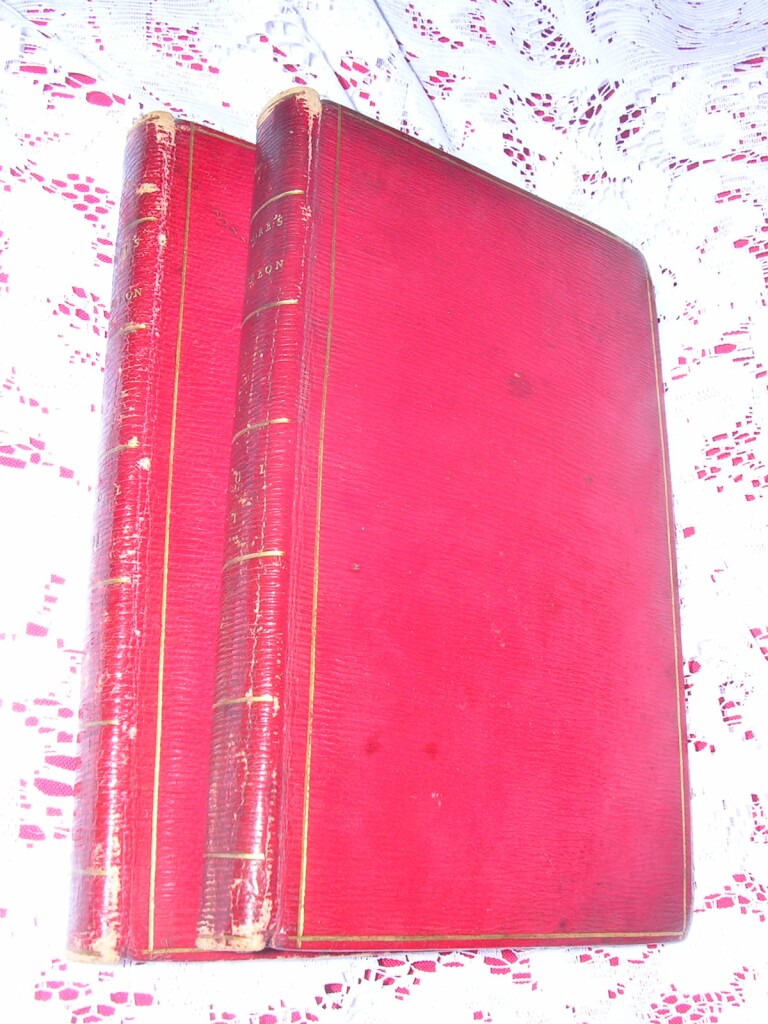 Odes of Anacreon, Anacreon, trans. Thomas Moore (J. and T. Carpenter, London, 1802) 6 1/2" X 4 1/4", 2 vol. 163pp 148pp, hardbound in red morocco with gilt lettering and decorations, gilted edges, marbled boards, worn edges and corners befitting it's age, binding tight, ribbon markers intact. Armorial bookplate of british judge, Geoffrey Lord Cross of Chelsea on front pastedowns Anacreon (582 BC _ 485 BC) was a Greek lyric poet, notable for his drinking songs and hymns. Later Greeks included him in the canonical list of nine lyric poets. Thomas Moore (1779 _ 1852) is considered Ireland's "National Bard". He was a poet, singer, songwriter, and entertainer. He was responsible, with John Murray, for burning Lord Byron's memoirs after his death. These books are the second edition (original edition published in 1800) of his first work, a translation that he did at Middle Temple where he studied law. In his lifetime he was often referred to as Anacreon Moore.
Odes of Anacreon, Anacreon, trans. Thomas Moore (J. and T. Carpenter, London, 1802) 6 1/2" X 4 1/4", 2 vol. 163pp 148pp, hardbound in red morocco with gilt lettering and decorations, gilted edges, marbled boards, worn edges and corners befitting it's age, binding tight, ribbon markers intact. Armorial bookplate of british judge, Geoffrey Lord Cross of Chelsea on front pastedowns Anacreon (582 BC _ 485 BC) was a Greek lyric poet, notable for his drinking songs and hymns. Later Greeks included him in the canonical list of nine lyric poets. Thomas Moore (1779 _ 1852) is considered Ireland's "National Bard". He was a poet, singer, songwriter, and entertainer. He was responsible, with John Murray, for burning Lord Byron's memoirs after his death. These books are the second edition (original edition published in 1800) of his first work, a translation that he did at Middle Temple where he studied law. In his lifetime he was often referred to as Anacreon Moore. -

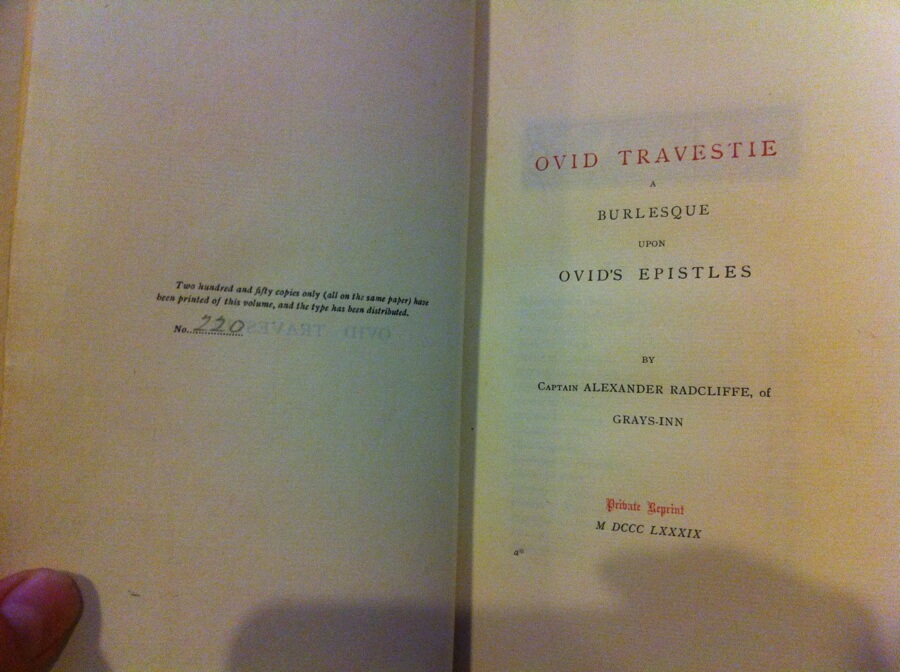 Ovid Travestie: A Burlesque upon Ovid's Epistles, Captain Alexander Radcliffe, of Grays-Inn (Private Reprint, 1889 [Smithers/Nichols Erotica Biblion Society?] #220/250) 8.75" X 5.5", 102pp, hardbound with plain black boards, pages untrimmed. Very good condition. Reprint of an obscene parody of Ovid, first published in 1680, with 17th-century English characters substituted for Ovid's Romans. 'That it merits a place in every collector's library is undisputed, its singularly easy strain of wit and ludicrous parody of Ovid's famed Heroides, shewing Capt. Radcliffe to possess not only an intimate knowledge of Ovid's manner, but a graphic power of turning to ridicule his author's most poetic flights.' So says the introduction, adding that nonetheless it 'is not a volume fitted for the ordinary bookshelf'. "The present reprint is made verbatim from the fourth and complete edition (A.D. 1705)." Alfred Rose (Registrum Librorum Eroticorum, entry no. 3380), lists an edition with the same date and limitation as the present edition, but with the impress of the Smithers/Nichols Erotica Biblion Society."
Ovid Travestie: A Burlesque upon Ovid's Epistles, Captain Alexander Radcliffe, of Grays-Inn (Private Reprint, 1889 [Smithers/Nichols Erotica Biblion Society?] #220/250) 8.75" X 5.5", 102pp, hardbound with plain black boards, pages untrimmed. Very good condition. Reprint of an obscene parody of Ovid, first published in 1680, with 17th-century English characters substituted for Ovid's Romans. 'That it merits a place in every collector's library is undisputed, its singularly easy strain of wit and ludicrous parody of Ovid's famed Heroides, shewing Capt. Radcliffe to possess not only an intimate knowledge of Ovid's manner, but a graphic power of turning to ridicule his author's most poetic flights.' So says the introduction, adding that nonetheless it 'is not a volume fitted for the ordinary bookshelf'. "The present reprint is made verbatim from the fourth and complete edition (A.D. 1705)." Alfred Rose (Registrum Librorum Eroticorum, entry no. 3380), lists an edition with the same date and limitation as the present edition, but with the impress of the Smithers/Nichols Erotica Biblion Society." -
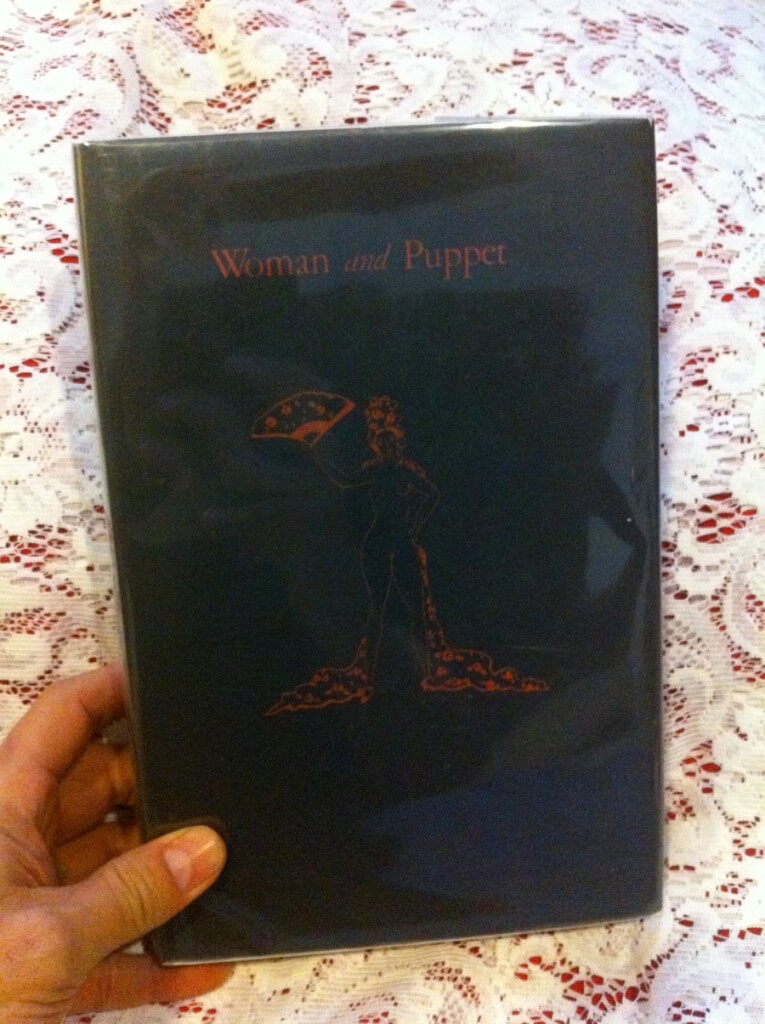
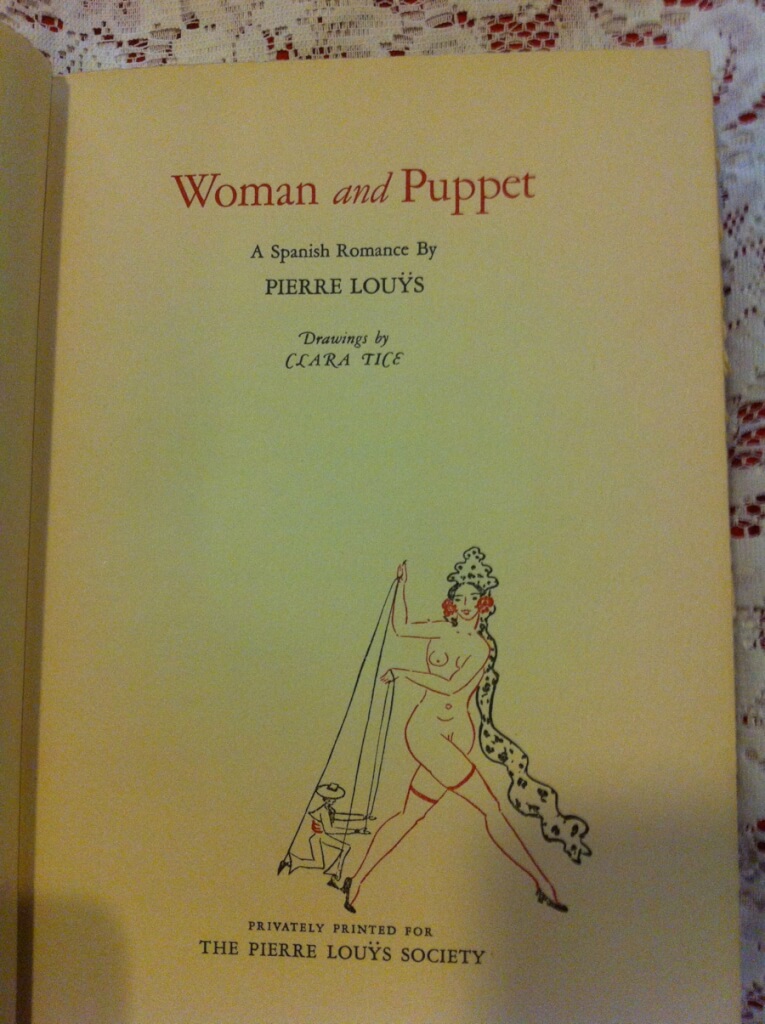 Woman and Puppet, Pierre Louys, illustrated by Clara Tice, "designed and supervised by Harry Cunningham" (The Pierre Louys Society, US, 1927, #617/990) 9 7/8" X 6 1/2", 270pp, hardbound with , black boards with red titles and decorations, MINT condition, with dust jacket wrapped in mylar. Bookstore stamp on front paste-down "C. J. Schnieder Books" During the carnival in Seville, the Frenchman André Stévenol meets and falls under the spell of Conception 'Concita' Perez, a young Andalusian woman. His friend, don Mateo Diaz warns him off by describing his own history with the woman – a history of being repeatedly attracted and then rebuffed by her. Conchita continually flirted with other men to torture don Mateo. On each occasion he was made to feel guilty for his jealous thoughts and actions towards her, until he realised finally that he had been her puppet for fourteen months and in an explosion of passion he beat her. She then astonished him by declaring the violence a sign of the strength of his love and came to his bed. She was a virgin. Although the two then started living together, she continued her flirtatious behaviour towards other men and simultaneously became very possessive. Don Mateo left the country and travelled for a year to escape her. The novel has a short epilogue, described as the moral of the piece. The Frenchman accidentally meets Conchita again, and they spend the night together. The next morning, as Conchita packs her bags for Paris, a note is received from don Mateo asking to be taken back into Conchita's good graces. Pierre Louys (1870 - 1925) was a French poet and writer, most renowned for lesbian and classical themes in some of his writings. He is known as a writer who "expressed pagan sensuality with stylistic perfection." Woman and Puppet is described as "Spanish romance". The "puppet" in the story refers to men she is able or unable to bend to her will.
Woman and Puppet, Pierre Louys, illustrated by Clara Tice, "designed and supervised by Harry Cunningham" (The Pierre Louys Society, US, 1927, #617/990) 9 7/8" X 6 1/2", 270pp, hardbound with , black boards with red titles and decorations, MINT condition, with dust jacket wrapped in mylar. Bookstore stamp on front paste-down "C. J. Schnieder Books" During the carnival in Seville, the Frenchman André Stévenol meets and falls under the spell of Conception 'Concita' Perez, a young Andalusian woman. His friend, don Mateo Diaz warns him off by describing his own history with the woman – a history of being repeatedly attracted and then rebuffed by her. Conchita continually flirted with other men to torture don Mateo. On each occasion he was made to feel guilty for his jealous thoughts and actions towards her, until he realised finally that he had been her puppet for fourteen months and in an explosion of passion he beat her. She then astonished him by declaring the violence a sign of the strength of his love and came to his bed. She was a virgin. Although the two then started living together, she continued her flirtatious behaviour towards other men and simultaneously became very possessive. Don Mateo left the country and travelled for a year to escape her. The novel has a short epilogue, described as the moral of the piece. The Frenchman accidentally meets Conchita again, and they spend the night together. The next morning, as Conchita packs her bags for Paris, a note is received from don Mateo asking to be taken back into Conchita's good graces. Pierre Louys (1870 - 1925) was a French poet and writer, most renowned for lesbian and classical themes in some of his writings. He is known as a writer who "expressed pagan sensuality with stylistic perfection." Woman and Puppet is described as "Spanish romance". The "puppet" in the story refers to men she is able or unable to bend to her will. -
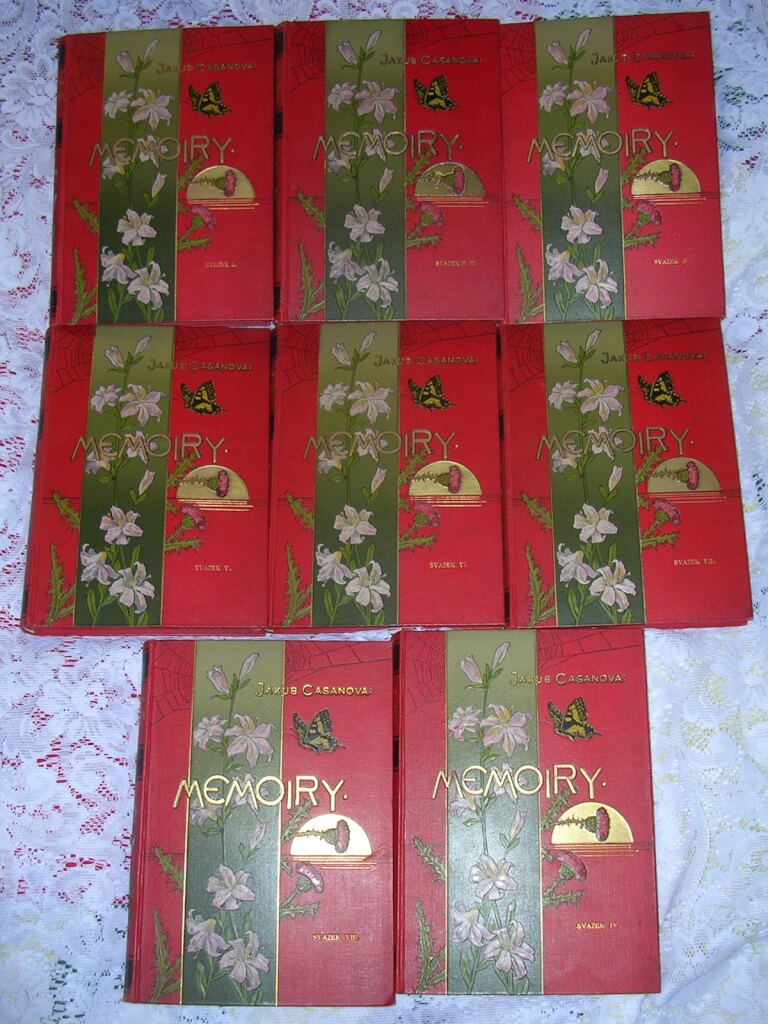
 Jakub Casanova: Memoiry (Czech: Cassanova's Memoirs), Giacomo Casanova (Alois Hynek, J. Rokyta, Praze, n.d. [c. 1890-1900]) 8.75" X 6.25" 9 vol. in 8 books 275pp. [220pp 144pp in one vol.] 283pp. 358pp. 304pp. 356pp. 326pp. 345 i-v. Hardcover with beautifully decorated red cloth boards. Very good condition. Rare complete set with full color boards. Even more rare copy translated into Czech. Giovanni Giacomo Casanova (1725-1798) was an ecclesiastic, writer, soldier, spy, and diplomatist, chiefly remembered as the prince of Italian adventurers and as the man who made the name Casanova synonymous with "libertine." His autobiography, which perhaps exaggerates some of his escapades, is a splendid description of 18th-century society in the capitals of Europe. This is a beautiful Czech edition, 9 volumes in 8 books in publisher's original decorative cloth-binding. A beautifully bound edition. I am unable to find another complete set. The only other place I can find mention these books is in the Czech National Library.
Jakub Casanova: Memoiry (Czech: Cassanova's Memoirs), Giacomo Casanova (Alois Hynek, J. Rokyta, Praze, n.d. [c. 1890-1900]) 8.75" X 6.25" 9 vol. in 8 books 275pp. [220pp 144pp in one vol.] 283pp. 358pp. 304pp. 356pp. 326pp. 345 i-v. Hardcover with beautifully decorated red cloth boards. Very good condition. Rare complete set with full color boards. Even more rare copy translated into Czech. Giovanni Giacomo Casanova (1725-1798) was an ecclesiastic, writer, soldier, spy, and diplomatist, chiefly remembered as the prince of Italian adventurers and as the man who made the name Casanova synonymous with "libertine." His autobiography, which perhaps exaggerates some of his escapades, is a splendid description of 18th-century society in the capitals of Europe. This is a beautiful Czech edition, 9 volumes in 8 books in publisher's original decorative cloth-binding. A beautifully bound edition. I am unable to find another complete set. The only other place I can find mention these books is in the Czech National Library. -
 La Génération de l' Homme ou Tableau de l' Amour Conjugal, considéré dans l'état du mariage, Nicolas Venette (np London, 1768, "Nouvelle Édition") 6.25″x3.75″, 408pp, vol. 1 only (of 2), full mottled calf, 5 raised bands worn), gilt title and decorations on spine (worn), marbled boards, fair condition for age, beautiful illustrations including a beautifully engraved frontispiece and title page. Nicolas Venette (1633–1698) was a physician, sexologist and French writer. Born in La Rochelle, he studied medicine at Bordeaux where he received his doctorate in 1656. He then went to Paris where he studied under Guy Patin and Pierre Petit, before travelling to Spain, Portugal and Italy. He then returned to La Rochelle, where he became Regius Professor of Anatomy and Surgery in 1668. First published in Amsterdam in 1686 as Tableau de l’amour humain considéré dans l’état du mariage (Table of human love considered in the state of marriage) under the pseudonym Salocini Venetian (anagram of Nicolas Venette), this book, more properly titled Table of conjugal love, or the complete history of the generation of man, is considered to be the first treatise on sexology in West. It proved to be a bestseller and was translated into English, Spanish, German and Dutch. There were 33 editions published sporadically until 1903. This edition was published in 1768 in two-volume. This book is volume 1. The author discusses four sub-topics with respect to sex: anatomy, reproduction, desire, and impotence/infertility. For each topic, he reviews ancient and medieval authors, adding his own observations or those of later authors, and comments where common sense prevails. The resulting composition has an ambiguous mixture of seriousness and light-heartedness bordering upon erotic literature.
La Génération de l' Homme ou Tableau de l' Amour Conjugal, considéré dans l'état du mariage, Nicolas Venette (np London, 1768, "Nouvelle Édition") 6.25″x3.75″, 408pp, vol. 1 only (of 2), full mottled calf, 5 raised bands worn), gilt title and decorations on spine (worn), marbled boards, fair condition for age, beautiful illustrations including a beautifully engraved frontispiece and title page. Nicolas Venette (1633–1698) was a physician, sexologist and French writer. Born in La Rochelle, he studied medicine at Bordeaux where he received his doctorate in 1656. He then went to Paris where he studied under Guy Patin and Pierre Petit, before travelling to Spain, Portugal and Italy. He then returned to La Rochelle, where he became Regius Professor of Anatomy and Surgery in 1668. First published in Amsterdam in 1686 as Tableau de l’amour humain considéré dans l’état du mariage (Table of human love considered in the state of marriage) under the pseudonym Salocini Venetian (anagram of Nicolas Venette), this book, more properly titled Table of conjugal love, or the complete history of the generation of man, is considered to be the first treatise on sexology in West. It proved to be a bestseller and was translated into English, Spanish, German and Dutch. There were 33 editions published sporadically until 1903. This edition was published in 1768 in two-volume. This book is volume 1. The author discusses four sub-topics with respect to sex: anatomy, reproduction, desire, and impotence/infertility. For each topic, he reviews ancient and medieval authors, adding his own observations or those of later authors, and comments where common sense prevails. The resulting composition has an ambiguous mixture of seriousness and light-heartedness bordering upon erotic literature. -
 La Génération de l' Homme ou Tableau de l' Amour Conjugal, considéré dans l'état du mariage, tome premier, Nicolas Venette (np 1776) 4″x6.75″, 365pp, vol. 1 only (of 2), full mottled calf, 5 raised bands, titles on spine are worn off, marbled boards loose but holding, fair condition for age. Illustrated throughout including a beautifully engraved frontispiece and title page, some illustrations are fold-outs. Nicolas Venette (1633–1698) was a physician, sexologist and French writer. Born in La Rochelle, he studied medicine at Bordeaux where he received his doctorate in 1656. He then went to Paris where he studied under Guy Patin and Pierre Petit, before travelling to Spain, Portugal and Italy. He then returned to La Rochelle, where he became Regius Professor of Anatomy and Surgery in 1668. First published in Amsterdam in 1686 as Tableau de l’amour humain considéré dans l’état du mariage (Table of human love considered in the state of marriage) under the pseudonym Salocini Venetian (anagram of Nicolas Venette), this book, more properly titled Table of conjugal love, or the complete history of the generation of man, is considered to be the first treatise on sexology in West. It proved to be a bestseller and was translated into English, Spanish, German and Dutch. There were 33 editions published sporadically until 1903. This edition was published in 1776 in two-volume. This book is volume 1. Many images are upgraded from previous editions to be fold-outs. The author discusses four sub-topics with respect to sex: anatomy, reproduction, desire, and impotence/infertility. For each topic, he reviews ancient and medieval authors, adding his own observations or those of later authors, and comments where common sense prevails. The resulting composition has an ambiguous mixture of seriousness and light-heartedness bordering upon erotic literature.
La Génération de l' Homme ou Tableau de l' Amour Conjugal, considéré dans l'état du mariage, tome premier, Nicolas Venette (np 1776) 4″x6.75″, 365pp, vol. 1 only (of 2), full mottled calf, 5 raised bands, titles on spine are worn off, marbled boards loose but holding, fair condition for age. Illustrated throughout including a beautifully engraved frontispiece and title page, some illustrations are fold-outs. Nicolas Venette (1633–1698) was a physician, sexologist and French writer. Born in La Rochelle, he studied medicine at Bordeaux where he received his doctorate in 1656. He then went to Paris where he studied under Guy Patin and Pierre Petit, before travelling to Spain, Portugal and Italy. He then returned to La Rochelle, where he became Regius Professor of Anatomy and Surgery in 1668. First published in Amsterdam in 1686 as Tableau de l’amour humain considéré dans l’état du mariage (Table of human love considered in the state of marriage) under the pseudonym Salocini Venetian (anagram of Nicolas Venette), this book, more properly titled Table of conjugal love, or the complete history of the generation of man, is considered to be the first treatise on sexology in West. It proved to be a bestseller and was translated into English, Spanish, German and Dutch. There were 33 editions published sporadically until 1903. This edition was published in 1776 in two-volume. This book is volume 1. Many images are upgraded from previous editions to be fold-outs. The author discusses four sub-topics with respect to sex: anatomy, reproduction, desire, and impotence/infertility. For each topic, he reviews ancient and medieval authors, adding his own observations or those of later authors, and comments where common sense prevails. The resulting composition has an ambiguous mixture of seriousness and light-heartedness bordering upon erotic literature. -

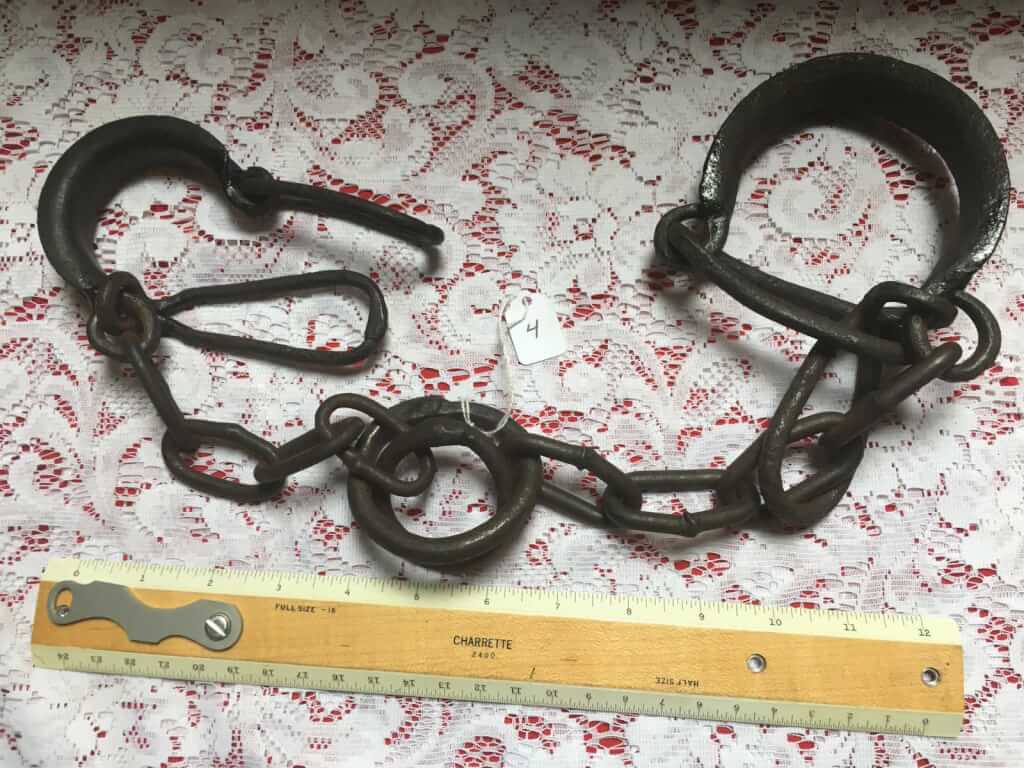 (2 x 2") + (2 3/4 x 3 1/4") Shackles (matched pair ankle/wrist) Antique hand-forged iron shackles from a farm in Bulgaria. They have been cleaned up and seasoned much like you'd season your cast iron skillet (repeatedly coated with oil and baked). No key is needed as they lock using a puzzle design.
(2 x 2") + (2 3/4 x 3 1/4") Shackles (matched pair ankle/wrist) Antique hand-forged iron shackles from a farm in Bulgaria. They have been cleaned up and seasoned much like you'd season your cast iron skillet (repeatedly coated with oil and baked). No key is needed as they lock using a puzzle design. -
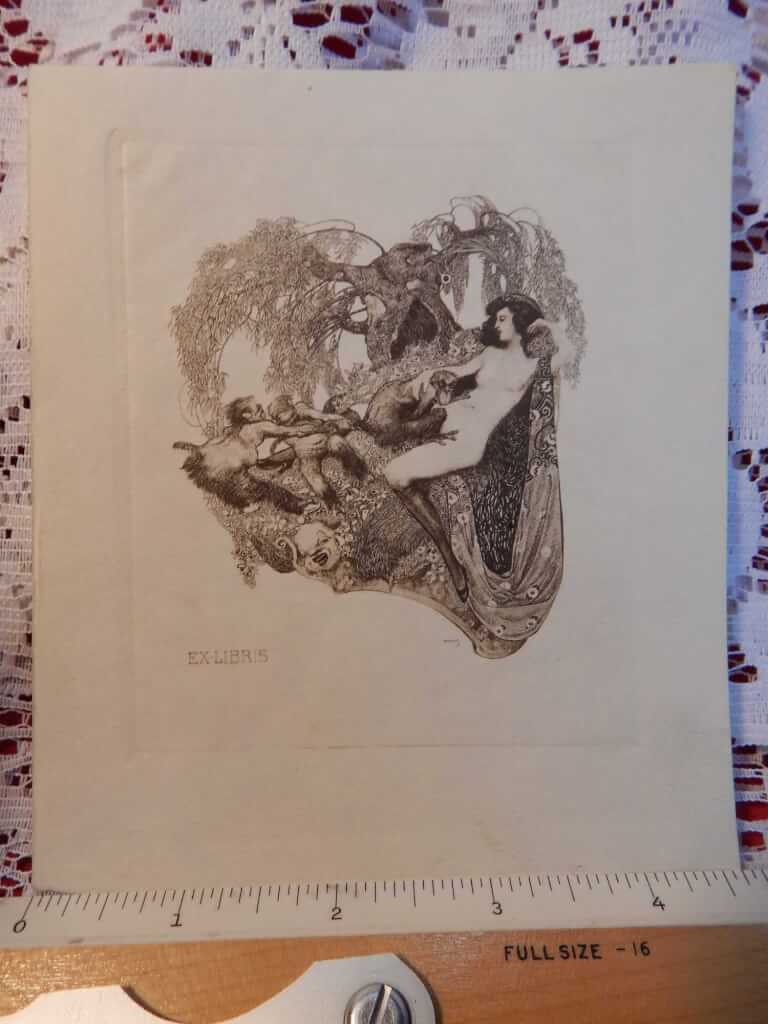 Ex Libris, by Franz von Bayros paper size 4.75 x 5.5", print size 3.5 x 4" naked woman sitting in a tree being "intimate" with monkey, other monkeys trying to pull him away from her. Very detailed and ornate. Franz von Bayros (1866 – 1924) was an Austrian commercial artist, illustrator, and painter, now he is best known for his erotic work. He belonged to the Decadent movement in art, often utilizing erotic themes and phantasmagoric imagery. At the age 17, Bayros passed the entrance exam for the Vienna Academy with Eduard von Engerth. Bayros mixed in elegant society and soon belonged to the circle of friends of Johann Straub, whose step daughter Alice he married on 1896. The next year, Bayros moved to Munich. In 1904, Bayros gave his first exhibition in Munich, which was a great success. From 1904 until 1908, Bayros traveled to Paris and Italy for his studies. Typically, for an artist dealing with such imagery, von Bayros produced work under several pseudonyms, most notably Choisy Le Conin, and was hounded by authorities for much of his life for his “indecent” art often very imaginative, and including such taboo subjects as sadomasochism and bestiality. He became equally well-known for his masterly drawn figures of elegant modestly nude and non-nude women.
Ex Libris, by Franz von Bayros paper size 4.75 x 5.5", print size 3.5 x 4" naked woman sitting in a tree being "intimate" with monkey, other monkeys trying to pull him away from her. Very detailed and ornate. Franz von Bayros (1866 – 1924) was an Austrian commercial artist, illustrator, and painter, now he is best known for his erotic work. He belonged to the Decadent movement in art, often utilizing erotic themes and phantasmagoric imagery. At the age 17, Bayros passed the entrance exam for the Vienna Academy with Eduard von Engerth. Bayros mixed in elegant society and soon belonged to the circle of friends of Johann Straub, whose step daughter Alice he married on 1896. The next year, Bayros moved to Munich. In 1904, Bayros gave his first exhibition in Munich, which was a great success. From 1904 until 1908, Bayros traveled to Paris and Italy for his studies. Typically, for an artist dealing with such imagery, von Bayros produced work under several pseudonyms, most notably Choisy Le Conin, and was hounded by authorities for much of his life for his “indecent” art often very imaginative, and including such taboo subjects as sadomasochism and bestiality. He became equally well-known for his masterly drawn figures of elegant modestly nude and non-nude women. -
 Memoirs of Cardinal Dubois | translated from the French by Ernest Dowson | with photogravure portraits of Cardinal Dubois and the Duc d'Orleans (Leonard Smithers and Co, London, 1899, First Edition thus, first English translation) 9.75"x6.5", 2 volumes, xvi-282pp, viii-268pp, blue boards with gilt decoration and titles on spine, deckled edges, good condition, bumping to corners, bookplates for Reginald Dalton Pontifex in both volumes. According to the publisher, the original manuscript which was written entirely in Dubois hand was stolen by his secretary Lavergne after his death in 1723. It was later discovered of its literary value that Lavergne attempted to sell the manuscript. He was found and arrested. They later fell into the hands of Comte de Maurepas, then upon his death they were passed on to an anonymous writer named Mercier (possibly M. Paul Laroix) whose family had it published in 1829. The manuscript then became lost. In 1899 and English version of the book translated by Ernest Christopher Dowson, was published by the notorious pornographer, Leonard Smithers & Co. This is, presumably a reprinting of that translation. Guillaume Dubois (1656-1723), a son of a country doctor, rose from humble beginnings to positions of power and high honor in government and in the Catholic Church. He is best known for negotiating the Triple Alliance of 1717 between France, the Dutch Republic and Great Britain against their mutual enemy, Spain. Considered one of the four great French Cardinal-Ministers (Richelieu, Mazarin, Dubois, and Fleury). His ecclesiastical career left a great deal to be desired. Although there is no proof of the prevalent assertion that he got secretly married, his licentiousness, and notorious impiety, even at the time of his death, make it evident that he pursued and used ecclesiastical dignities principally to enhance his political position and prestige. Eventually in 1721, Du Bois was created cardinal. He had the reputation of a libertine and adventurer and made plenty of enemies. One of his rivals was charged at creating his portrait, the Duc de Saint-Simon, who was said to have placed a painting of Dubois in his lavatory. Saint-Simon had this to say about the Cardinal: "He was a little, pitiful, wizened, herring-gutted man, in a flaxen wig, with a weasel's face, brightened by some intellect. All the vices - perfidy, avarice, debauchery, ambition, flattery - fought within him for the mastery. He was so consummate a liar that, when taken in the fact, he could brazenly deny it. Even his wit and knowledge of the world were spoiled, and his affected gaiety was touched with sadness, by the odour of falsehood which escaped through every pore of his body." This famous picture is certainly biased. Dubois was unscrupulous, but so were his contemporaries, and whatever vices he had, he forged a European peace that, with the exception of small, restrained military expeditions against the Austrian Habsburgs, would last for a quarter of a century. Leonard Smithers (1861-1907), a solicitor born in Sheffield, was one of the most notable publishers of erotica of his day. He was said to be a brilliant but shady character who operated on the fringes of the rare book trade, issuing small, clandestine editions of risqué books with the boast: 'I will publish the things the others are afraid to touch'. He was notorious for posting a slogan at his bookshop in Bond Street reading "Smut is cheap today". He developed a friendship with Sir Richard Francis Burton and published Burton's famous translation of the Book of One Thousand and One Nights in 1885. He also worked with, among others, Aubrey Beardsley, Aleister Crowley, and Oscar Wilde. With Beardsley and Arthur Symons, he founded The Savoy, a periodical which ran for eight issues in 1896. Smithers famously partnered with Harry Nichols to publish a series of pornographic books under the Erotika Biblion Society imprint. When Beardsley, on his death bed, converted to Catholicism and asked Smithers to “destroy all copies of Lysistrata and bad drawings...by all that is holy all obscene drawings.", Smithers, famously and thankfully ignored him and continued to publish his works until his death in 1907. It was Smithers who published Oscar Wilde's The Ballad of Reading Gaol, a long poem commemorating the harsh rhythms of prison life in 1898. Smithers went bankrupt in 1900 and died impoverished in 1907 from cirrhosis of the liver. Up until his death he continued to sell reproductions (and forgeries) of Beardsley's work as well as reproductions of the Beardsley's letter asking him to destroy his drawings. Reginald Dalton Pontifex (1857–1951) was born in France, attended Magdalen College at Oxford from 1876–80, getting a Fourth in Law in 1880 and a Third in his BCL in 1882. He later practiced as a barrister. At the time of his death it was said he had quite the book collection containing, several of antiquarian interest. He bequethed his book collection to his alma mater. Most of his books were printed in the early nineteenth century and many of them extensively illustrated. He died in Bournemouth, Hampshire, England in 1951.
Memoirs of Cardinal Dubois | translated from the French by Ernest Dowson | with photogravure portraits of Cardinal Dubois and the Duc d'Orleans (Leonard Smithers and Co, London, 1899, First Edition thus, first English translation) 9.75"x6.5", 2 volumes, xvi-282pp, viii-268pp, blue boards with gilt decoration and titles on spine, deckled edges, good condition, bumping to corners, bookplates for Reginald Dalton Pontifex in both volumes. According to the publisher, the original manuscript which was written entirely in Dubois hand was stolen by his secretary Lavergne after his death in 1723. It was later discovered of its literary value that Lavergne attempted to sell the manuscript. He was found and arrested. They later fell into the hands of Comte de Maurepas, then upon his death they were passed on to an anonymous writer named Mercier (possibly M. Paul Laroix) whose family had it published in 1829. The manuscript then became lost. In 1899 and English version of the book translated by Ernest Christopher Dowson, was published by the notorious pornographer, Leonard Smithers & Co. This is, presumably a reprinting of that translation. Guillaume Dubois (1656-1723), a son of a country doctor, rose from humble beginnings to positions of power and high honor in government and in the Catholic Church. He is best known for negotiating the Triple Alliance of 1717 between France, the Dutch Republic and Great Britain against their mutual enemy, Spain. Considered one of the four great French Cardinal-Ministers (Richelieu, Mazarin, Dubois, and Fleury). His ecclesiastical career left a great deal to be desired. Although there is no proof of the prevalent assertion that he got secretly married, his licentiousness, and notorious impiety, even at the time of his death, make it evident that he pursued and used ecclesiastical dignities principally to enhance his political position and prestige. Eventually in 1721, Du Bois was created cardinal. He had the reputation of a libertine and adventurer and made plenty of enemies. One of his rivals was charged at creating his portrait, the Duc de Saint-Simon, who was said to have placed a painting of Dubois in his lavatory. Saint-Simon had this to say about the Cardinal: "He was a little, pitiful, wizened, herring-gutted man, in a flaxen wig, with a weasel's face, brightened by some intellect. All the vices - perfidy, avarice, debauchery, ambition, flattery - fought within him for the mastery. He was so consummate a liar that, when taken in the fact, he could brazenly deny it. Even his wit and knowledge of the world were spoiled, and his affected gaiety was touched with sadness, by the odour of falsehood which escaped through every pore of his body." This famous picture is certainly biased. Dubois was unscrupulous, but so were his contemporaries, and whatever vices he had, he forged a European peace that, with the exception of small, restrained military expeditions against the Austrian Habsburgs, would last for a quarter of a century. Leonard Smithers (1861-1907), a solicitor born in Sheffield, was one of the most notable publishers of erotica of his day. He was said to be a brilliant but shady character who operated on the fringes of the rare book trade, issuing small, clandestine editions of risqué books with the boast: 'I will publish the things the others are afraid to touch'. He was notorious for posting a slogan at his bookshop in Bond Street reading "Smut is cheap today". He developed a friendship with Sir Richard Francis Burton and published Burton's famous translation of the Book of One Thousand and One Nights in 1885. He also worked with, among others, Aubrey Beardsley, Aleister Crowley, and Oscar Wilde. With Beardsley and Arthur Symons, he founded The Savoy, a periodical which ran for eight issues in 1896. Smithers famously partnered with Harry Nichols to publish a series of pornographic books under the Erotika Biblion Society imprint. When Beardsley, on his death bed, converted to Catholicism and asked Smithers to “destroy all copies of Lysistrata and bad drawings...by all that is holy all obscene drawings.", Smithers, famously and thankfully ignored him and continued to publish his works until his death in 1907. It was Smithers who published Oscar Wilde's The Ballad of Reading Gaol, a long poem commemorating the harsh rhythms of prison life in 1898. Smithers went bankrupt in 1900 and died impoverished in 1907 from cirrhosis of the liver. Up until his death he continued to sell reproductions (and forgeries) of Beardsley's work as well as reproductions of the Beardsley's letter asking him to destroy his drawings. Reginald Dalton Pontifex (1857–1951) was born in France, attended Magdalen College at Oxford from 1876–80, getting a Fourth in Law in 1880 and a Third in his BCL in 1882. He later practiced as a barrister. At the time of his death it was said he had quite the book collection containing, several of antiquarian interest. He bequethed his book collection to his alma mater. Most of his books were printed in the early nineteenth century and many of them extensively illustrated. He died in Bournemouth, Hampshire, England in 1951. -

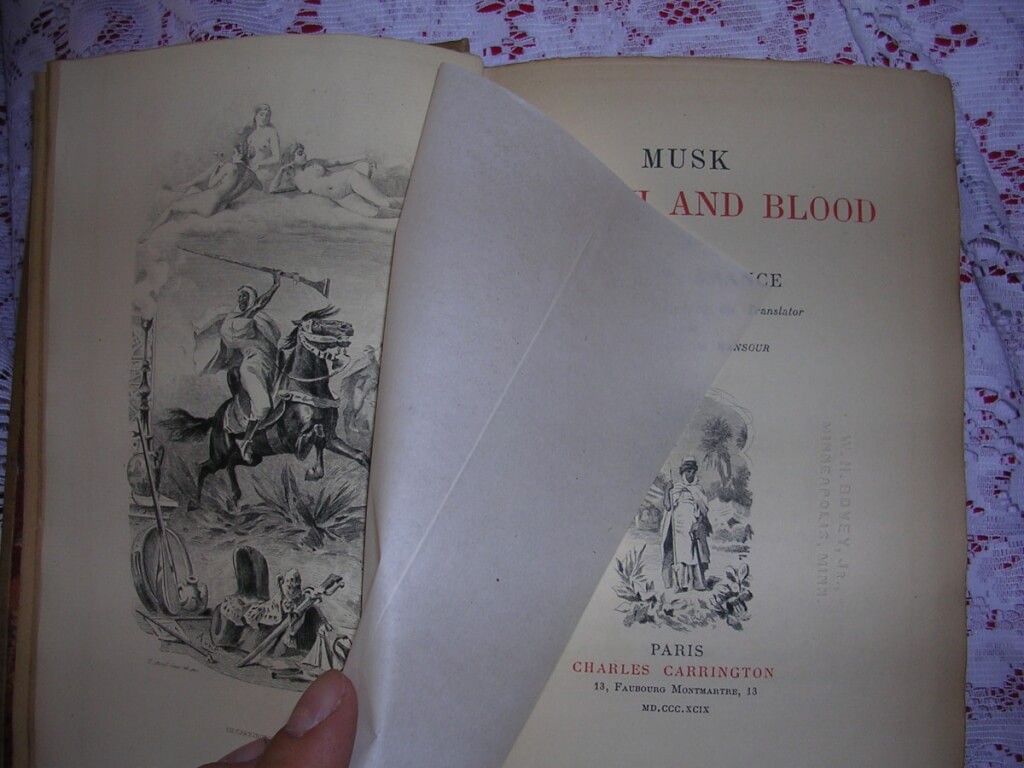 Musk, Hashish and Blood, Hector France, illust. Paul Avril, [trans. most likely Alfred Richard Allinson] (Charles Carrington, Paris, 1899) 8.5" X 5.5", xiii 447pp., hardbound, cloth boards with gilt tittles and decorations. Marbled end papers, deckled edges, frontispiece with tissue guard and numerous illustrations throughout. Good condition, binding is cocked but intact. Owner's signature in front, ink stamp in back, and imprint on title page reads "W.H. Bovey, Minneapolis, MN." Hector France (1837 - 1908) was a French author best known for his "orientalist" and flagellation tales. This graphic and exciting picture of the Algerian desert, its tribes and their astounding customs is a sensational recounting of France's experiences in North Africa. France tells the stories of his adventures in the nineteenth century Arab world from an eyewitness view. "The adventures of a modern man among the cruel men and passionate women of Algiers." Édouard-Henri Avril (1849-1928) used the pseudonym "Paul Avril" for his erotic work. He was a French painter and commercial artist. His career saw collaboration with influential people like Octave Uzanne, Henry Spencer Ashbee and Friedrich Karl Forberg. He is one of the most celebrated erotic artists of his age. Avril was a soldier before starting his career in art. He was awarded with the Legion of Honour for his actions in the Franco-Prussian War.
Musk, Hashish and Blood, Hector France, illust. Paul Avril, [trans. most likely Alfred Richard Allinson] (Charles Carrington, Paris, 1899) 8.5" X 5.5", xiii 447pp., hardbound, cloth boards with gilt tittles and decorations. Marbled end papers, deckled edges, frontispiece with tissue guard and numerous illustrations throughout. Good condition, binding is cocked but intact. Owner's signature in front, ink stamp in back, and imprint on title page reads "W.H. Bovey, Minneapolis, MN." Hector France (1837 - 1908) was a French author best known for his "orientalist" and flagellation tales. This graphic and exciting picture of the Algerian desert, its tribes and their astounding customs is a sensational recounting of France's experiences in North Africa. France tells the stories of his adventures in the nineteenth century Arab world from an eyewitness view. "The adventures of a modern man among the cruel men and passionate women of Algiers." Édouard-Henri Avril (1849-1928) used the pseudonym "Paul Avril" for his erotic work. He was a French painter and commercial artist. His career saw collaboration with influential people like Octave Uzanne, Henry Spencer Ashbee and Friedrich Karl Forberg. He is one of the most celebrated erotic artists of his age. Avril was a soldier before starting his career in art. He was awarded with the Legion of Honour for his actions in the Franco-Prussian War. -
 The Bedroom Philosophers | Being and English Rendering of La Philosophie dans le Boudoir, done by Pieralessandro Casavini, D.A.F. de Sade, trans. Pieralessandro Casavini [Austryn Wainhouse] (Olympia Press, Paris, 1953, First Edition, First English Translation) "Printed May 1953 by Imprimerie mazarine, Paris" 7.25" X 5", hardbound quarter leather over maroon boards, marbled endpapers, near mint condition, inscription inside reads, "To Leo on Christmas 1953 Lloyd" Philosophy in the Bedroom (French: La philosophie dans le boudoir) is a 1795 book by the Marquis de Sade written in the form of a dramatic dialogue. Set in a bedroom, the two lead characters make the argument that the only moral system that reinforces the recent political revolution is libertinism, and that if the people of France fail to adopt the libertine philosophy, France will be destined to return to a monarchic state. Continually throughout the work, Sade makes the argument that one must embrace atheism, reject society's beliefs about pleasure and pain, and further makes his argument that if any crime is committed while seeking pleasure, it cannot be condemned. Characters Eugénie, a 15-year-old girl who at the beginning of the dialogue is a virgin, naïve of all things sexual, who has been brought up by her mother to be well-mannered, modest, decent and obedient. Madame de Saint-Ange, a 26-year-old libertine woman who is the owner of the house and bedroom in which the dialogue is set. She invites Eugénie for a two-day course on being libertine. Le Chevalier de Mirval, Madame de Saint-Ange's 20-year-old brother. He aids his sister and Dolmancé in the ordeal of "educating" Eugénie. Dolmancé, a 36-year-old atheist and bisexual (though with a strong preference for men), and friend of Le Chevalier's. He is Eugénie's foremost teacher and "educator". Madame de Mistival, Eugénie's provincial, self-righteous mother. Augustin, Madame de Saint-Ange's eighteen or twenty year-old gardener. Summoned to assist in the sexual activities in the fifth dialogue. Olympia Press was a Paris-based publisher, launched in 1953 by Maurice Girodias as a rebranded version of the Obelisk Press he inherited from his father Jack Kahane. It published a mix of erotic fiction and avant-garde literary fiction, and is best known for issuing the first printed edition of Vladimir Nabokov's Lolita. In its heyday during the mid-fifties Olympia Press specialized in books which could not be published (without legal action) in the English-speaking world. Early on, Girodias relied on the permissive attitudes of the French to publish sexually explicit books in both French and English. The French began to ban and seize the press's book in the late fifties. Precisely 94 Olympia Press publications were promoted and packaged as "Traveller's Companion" books, usually with simple text-only covers, and each book in the series was numbered. The "Ophelia Press" line of erotica was far larger, using the same design, but pink covers instead of green. This edition is one of the first four titles issued by Olympia Press. It is beautifully bound, rare for these books which usually appear in their original soft covers.
The Bedroom Philosophers | Being and English Rendering of La Philosophie dans le Boudoir, done by Pieralessandro Casavini, D.A.F. de Sade, trans. Pieralessandro Casavini [Austryn Wainhouse] (Olympia Press, Paris, 1953, First Edition, First English Translation) "Printed May 1953 by Imprimerie mazarine, Paris" 7.25" X 5", hardbound quarter leather over maroon boards, marbled endpapers, near mint condition, inscription inside reads, "To Leo on Christmas 1953 Lloyd" Philosophy in the Bedroom (French: La philosophie dans le boudoir) is a 1795 book by the Marquis de Sade written in the form of a dramatic dialogue. Set in a bedroom, the two lead characters make the argument that the only moral system that reinforces the recent political revolution is libertinism, and that if the people of France fail to adopt the libertine philosophy, France will be destined to return to a monarchic state. Continually throughout the work, Sade makes the argument that one must embrace atheism, reject society's beliefs about pleasure and pain, and further makes his argument that if any crime is committed while seeking pleasure, it cannot be condemned. Characters Eugénie, a 15-year-old girl who at the beginning of the dialogue is a virgin, naïve of all things sexual, who has been brought up by her mother to be well-mannered, modest, decent and obedient. Madame de Saint-Ange, a 26-year-old libertine woman who is the owner of the house and bedroom in which the dialogue is set. She invites Eugénie for a two-day course on being libertine. Le Chevalier de Mirval, Madame de Saint-Ange's 20-year-old brother. He aids his sister and Dolmancé in the ordeal of "educating" Eugénie. Dolmancé, a 36-year-old atheist and bisexual (though with a strong preference for men), and friend of Le Chevalier's. He is Eugénie's foremost teacher and "educator". Madame de Mistival, Eugénie's provincial, self-righteous mother. Augustin, Madame de Saint-Ange's eighteen or twenty year-old gardener. Summoned to assist in the sexual activities in the fifth dialogue. Olympia Press was a Paris-based publisher, launched in 1953 by Maurice Girodias as a rebranded version of the Obelisk Press he inherited from his father Jack Kahane. It published a mix of erotic fiction and avant-garde literary fiction, and is best known for issuing the first printed edition of Vladimir Nabokov's Lolita. In its heyday during the mid-fifties Olympia Press specialized in books which could not be published (without legal action) in the English-speaking world. Early on, Girodias relied on the permissive attitudes of the French to publish sexually explicit books in both French and English. The French began to ban and seize the press's book in the late fifties. Precisely 94 Olympia Press publications were promoted and packaged as "Traveller's Companion" books, usually with simple text-only covers, and each book in the series was numbered. The "Ophelia Press" line of erotica was far larger, using the same design, but pink covers instead of green. This edition is one of the first four titles issued by Olympia Press. It is beautifully bound, rare for these books which usually appear in their original soft covers. -
 Sappho: memoir, text, selected renderings, and a literal translation by Henry Thorton Wharton, Sappho, trans. Henry Thornton Wharton, M.A. Oxon. (John Lane [Bodley Head], London, A.C. McClurg & Co, Chicago, 1895 (third edition)) 7.25″ X 4.75″, xx 217pp + 16pp publisher’s list, hardbound, the third edition (this being the first to have its boards decorated by Aubrey Beardsley) green cloth boards with gilt decorations and titles on spine, bottom of the spine states “The Bodley Head and Chicago” reflecting the two publishing houses, top edge gilt, others deckled. Good condition for age, short tear on spine, binding and hinges good, newspaper article attached to back page “A Newly-Found Poem by Sappho” Sappho was a Greek lyric poet, born on the island of Lesbos. The Alexandrians included her in the list of nine lyric poets. Her birth was sometime between 630 and 612 BC, and it is said that she died around 570 BC, but little is known for certain about her life. The bulk of her poetry, which was well-known and greatly admired through much of antiquity, has been lost. But, her immense reputation has endured through surviving fragments. Sappho's poetry centers on passion and love for various people and both sexes. The word lesbian derives from the name of the island of her birth, Lesbos, while her name is also the origin of the word sapphic; neither word was applied to female homosexuality until the 19th century, after this translation by Wharton, the first English translation to acknowledge it. Originally John Lane and Elkin Mathews — The Bodley Head was a partnership set up in 1887 by John Lane (1854–1925) and Elkin Mathews (1851–1921), to trade in antiquarian books in London. It took its name from a bust of Sir Thomas Bodley, the eponymist of the Bodleian Library in Oxford, above the shop door. Lane and Mathews began in 1894 to publish works of ‘stylish decadence’, including the notorious literary periodical The Yellow Book. A. C. McClurg was a Chicago, Illinois based publisher made famous by their original publishing of the Tarzan of the Apes novels and other stories of Edgar Rice Burroughs.
Sappho: memoir, text, selected renderings, and a literal translation by Henry Thorton Wharton, Sappho, trans. Henry Thornton Wharton, M.A. Oxon. (John Lane [Bodley Head], London, A.C. McClurg & Co, Chicago, 1895 (third edition)) 7.25″ X 4.75″, xx 217pp + 16pp publisher’s list, hardbound, the third edition (this being the first to have its boards decorated by Aubrey Beardsley) green cloth boards with gilt decorations and titles on spine, bottom of the spine states “The Bodley Head and Chicago” reflecting the two publishing houses, top edge gilt, others deckled. Good condition for age, short tear on spine, binding and hinges good, newspaper article attached to back page “A Newly-Found Poem by Sappho” Sappho was a Greek lyric poet, born on the island of Lesbos. The Alexandrians included her in the list of nine lyric poets. Her birth was sometime between 630 and 612 BC, and it is said that she died around 570 BC, but little is known for certain about her life. The bulk of her poetry, which was well-known and greatly admired through much of antiquity, has been lost. But, her immense reputation has endured through surviving fragments. Sappho's poetry centers on passion and love for various people and both sexes. The word lesbian derives from the name of the island of her birth, Lesbos, while her name is also the origin of the word sapphic; neither word was applied to female homosexuality until the 19th century, after this translation by Wharton, the first English translation to acknowledge it. Originally John Lane and Elkin Mathews — The Bodley Head was a partnership set up in 1887 by John Lane (1854–1925) and Elkin Mathews (1851–1921), to trade in antiquarian books in London. It took its name from a bust of Sir Thomas Bodley, the eponymist of the Bodleian Library in Oxford, above the shop door. Lane and Mathews began in 1894 to publish works of ‘stylish decadence’, including the notorious literary periodical The Yellow Book. A. C. McClurg was a Chicago, Illinois based publisher made famous by their original publishing of the Tarzan of the Apes novels and other stories of Edgar Rice Burroughs. -
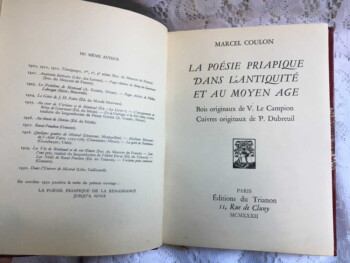
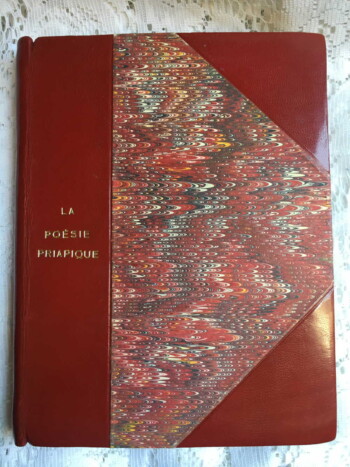 La poésie priapique dans l'antiquité et au moyen age [Priapic poetry in antiquity and the middle ages], ed. Marcel Coulon, 1 original wood engraving by V. Le Campion, 2 original brass engravings by P. Dubreuil (Éditions du Trianon, Paris, 1932, printed by Les Presses de Massoul, #119 of 750) 7.75"x6.25", 166pp+index, 3/4 bound red calf over marbled boards, gilt title on cover and spine, original french wraps bound in, marbled end papers, near fine condition, ribbon intact, pages clean. A history of priapic literature covering folklore, poetry, Priapus, mythology, homosexuality in the ancient world.
La poésie priapique dans l'antiquité et au moyen age [Priapic poetry in antiquity and the middle ages], ed. Marcel Coulon, 1 original wood engraving by V. Le Campion, 2 original brass engravings by P. Dubreuil (Éditions du Trianon, Paris, 1932, printed by Les Presses de Massoul, #119 of 750) 7.75"x6.25", 166pp+index, 3/4 bound red calf over marbled boards, gilt title on cover and spine, original french wraps bound in, marbled end papers, near fine condition, ribbon intact, pages clean. A history of priapic literature covering folklore, poetry, Priapus, mythology, homosexuality in the ancient world. -
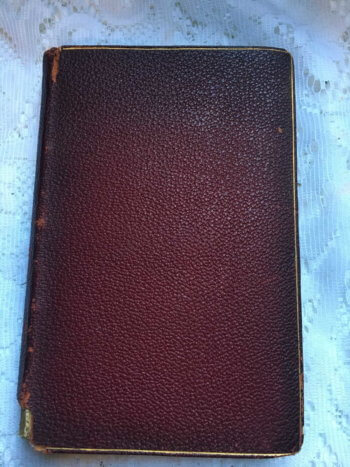
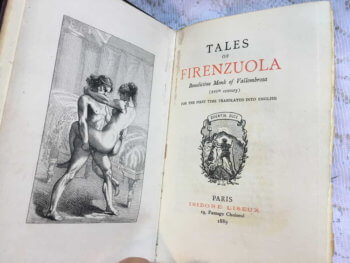 Tales of Firenzuola | Benedictine Monk of Vallombrosa | (XVIth century) | first time translated into English, Agnolo Firenzuola (Isidore Liseux, Paris, 1889) 4.25" x 6.5", xix+180pp., full soft red morroco binding with gilt borders, decorated end papers, deckled edges, hand laid paper, unique frontispiece illustration tipped in, not seen in any other copies online, title page in red and black, good minus condition, corners bumped top of spine is torn, .5" inch of bottom of spine is missing This copy is a rare all-leather first-edition. I have not seen any other copies with this frontispiece and know nothing about it's origin. Originally written in Italian titled Ragionamenti Amorosi (Amorous Reasons), the Tales were written in 1523-24 on the Boccaccian premise of a group of young ladies and gentlemen gathered in a Tuscan villa to tell each other, in turn, stories dealing with love, fortune, fate, virtue, etc. The stories themselves, in their variety and immediacy, offer an insight into sixteenth-century Italian society and its concerns. Agnolo Firenzuola (1493–1545), an Italian poet and littérateur, was born in Florence, September 28th, 1493. He received his name from the town of Firenzaola among the Apennines, where his family originated. Agnolo spent his youth in Siena and Perugia, studying law and living a "life of pleasure". For a short time he practiced law in Rome, but abandoned it to become a monk at Vallombrosa. After the death of Clement VII. he went to Florence, and finally settled at Prato as abbot of San Salvatore. Some authorities have disputed that he ever became an abbot, for the records of his dissolute career do not accord with a monastic life. But whether abbot or gentleman of leisure, a severe illness took him to Prato, where he spent many happy years. He died there or at Rome, about 1545. Firenzuola wrote satirical and burlesque poems; two comedies, ‘I Lucidi’ and ‘La Trinuzia’; ‘Discorsi degli Animali,’ imitations of Oriental fables of animals; ‘Ragionamenti Amorosi,’ novelettes or tales after the fashion of Boccaccio; ‘Dialogo della Bellezza delle Donne,’ and other works. He also wrote a few love poems and ballads, one of the most admired of which is ‘Orozza Pastorella.’ Isidore Liseux (1835-1894) was a French bibliophile and publisher of erotica and curiosa. His publications were mostly rare texts of 16th to 18th century authors, hard to find and little known books which were usually translated and annotated by his friend and associate Alcide Bonneau or by Liseux himself. Liseux and Bonneau, both ex-priests, knew each other since seminary. His books were published in small numbers, on high quality paper, and with excellent typography. His usual printers were Claude Motteroz, Antoine Bécus, and later Charles Unsinger. Liseux's books were published openly as the climate was more permissive in Paris at the time. His books were so well regarded that pirates of his books and even unrelated books bearing his imprint with a false date were published clandestinely into the 20th century. French poet, Guillaume Apollinaire wrote: "The publications of Liseux are more and more sought after because they are correct, beautiful and rare." (Le flaneur des deux rives, 1918).
Tales of Firenzuola | Benedictine Monk of Vallombrosa | (XVIth century) | first time translated into English, Agnolo Firenzuola (Isidore Liseux, Paris, 1889) 4.25" x 6.5", xix+180pp., full soft red morroco binding with gilt borders, decorated end papers, deckled edges, hand laid paper, unique frontispiece illustration tipped in, not seen in any other copies online, title page in red and black, good minus condition, corners bumped top of spine is torn, .5" inch of bottom of spine is missing This copy is a rare all-leather first-edition. I have not seen any other copies with this frontispiece and know nothing about it's origin. Originally written in Italian titled Ragionamenti Amorosi (Amorous Reasons), the Tales were written in 1523-24 on the Boccaccian premise of a group of young ladies and gentlemen gathered in a Tuscan villa to tell each other, in turn, stories dealing with love, fortune, fate, virtue, etc. The stories themselves, in their variety and immediacy, offer an insight into sixteenth-century Italian society and its concerns. Agnolo Firenzuola (1493–1545), an Italian poet and littérateur, was born in Florence, September 28th, 1493. He received his name from the town of Firenzaola among the Apennines, where his family originated. Agnolo spent his youth in Siena and Perugia, studying law and living a "life of pleasure". For a short time he practiced law in Rome, but abandoned it to become a monk at Vallombrosa. After the death of Clement VII. he went to Florence, and finally settled at Prato as abbot of San Salvatore. Some authorities have disputed that he ever became an abbot, for the records of his dissolute career do not accord with a monastic life. But whether abbot or gentleman of leisure, a severe illness took him to Prato, where he spent many happy years. He died there or at Rome, about 1545. Firenzuola wrote satirical and burlesque poems; two comedies, ‘I Lucidi’ and ‘La Trinuzia’; ‘Discorsi degli Animali,’ imitations of Oriental fables of animals; ‘Ragionamenti Amorosi,’ novelettes or tales after the fashion of Boccaccio; ‘Dialogo della Bellezza delle Donne,’ and other works. He also wrote a few love poems and ballads, one of the most admired of which is ‘Orozza Pastorella.’ Isidore Liseux (1835-1894) was a French bibliophile and publisher of erotica and curiosa. His publications were mostly rare texts of 16th to 18th century authors, hard to find and little known books which were usually translated and annotated by his friend and associate Alcide Bonneau or by Liseux himself. Liseux and Bonneau, both ex-priests, knew each other since seminary. His books were published in small numbers, on high quality paper, and with excellent typography. His usual printers were Claude Motteroz, Antoine Bécus, and later Charles Unsinger. Liseux's books were published openly as the climate was more permissive in Paris at the time. His books were so well regarded that pirates of his books and even unrelated books bearing his imprint with a false date were published clandestinely into the 20th century. French poet, Guillaume Apollinaire wrote: "The publications of Liseux are more and more sought after because they are correct, beautiful and rare." (Le flaneur des deux rives, 1918). -
Out of stock
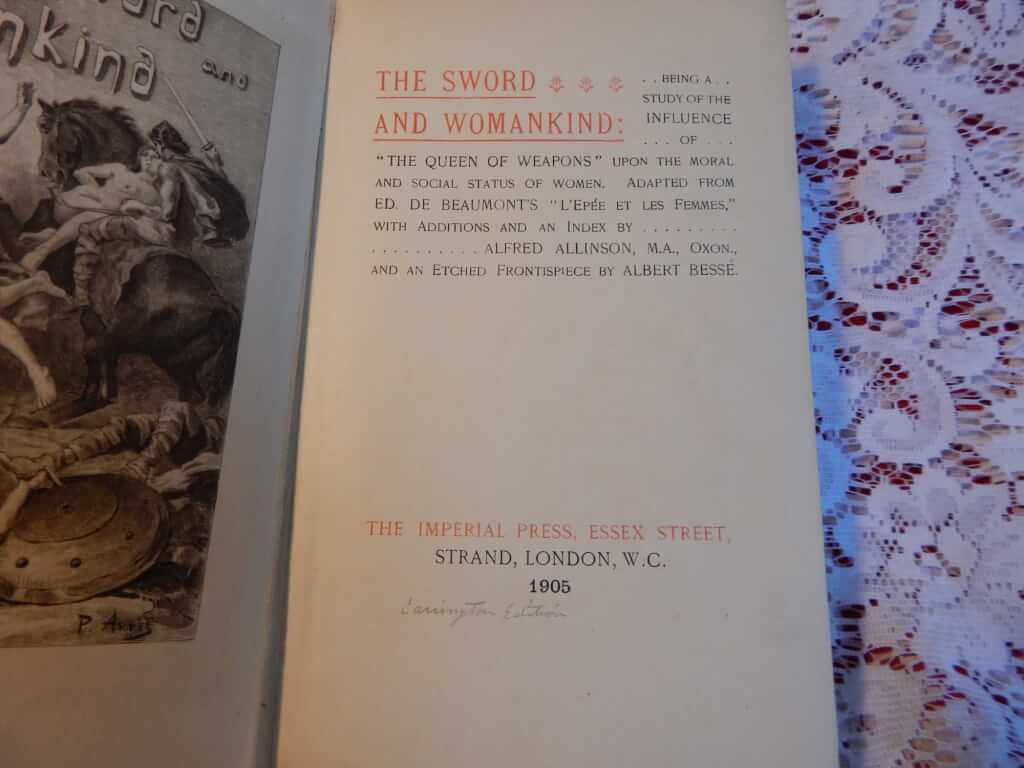
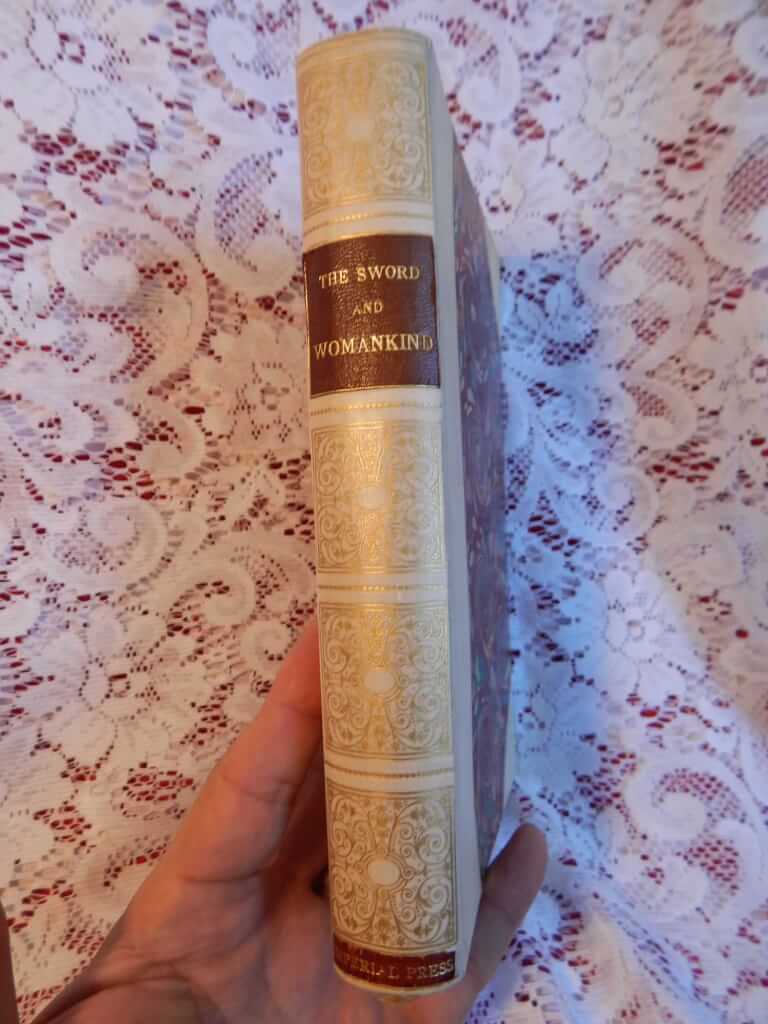 The Sword and Womankind: being a study of the influence of "The Queen of Wepons" upon the moral and social status of women. Adapted from Ed. de Beauont's "L'Epée et les Femmes," with addtions and an index by Alfred Allinson, M.A. Oxon., and an etched frontispiece by Albert Bessé, [frontispiece actually by Paul Avril, engraved by E. Leon] (The Imperial Press [Charles Carrington], Essex Street, Strand, London, W.C., 1905, #487/1000) 5.75"x8.75", xx+410pp, 1/2 while vellum over marbled boards, gilt title and decorations on spine, marbled endpapers, top edge gilt others deckled, frontispiece features a rare Paul Avril print and NOT Albert Bessé, numerous notes written lightly in margins in pencil, ribbon present, near fine copy, owner's ex libris stamp is evident on a few pages Beaumont, with a characteristic French point of view, believes in a feminine interpretation of history - which is, that all important historic events are caused by women. But unlike most Frenchmen he believed that all such events are caused by naughty women. This is a history of those women, adapted from the original French. Sample chapters: In barbarous ages woman is a divinity - Frea, the Scandinavian Venus; Swordsmen become the agents of women's sexual excesses - public defiances concerning harlots; Debauchery during the crusades - chivalry modified by oriental passions; New ways of love and dalliance - interest in salacious art. History of consequences of gender and sex including degradation of women, concubines, chastity belts, prostitutes, debauchery during crusades, erotic literature, duelists, cavaliers, orgies, etc. The book repeatedly advises that it is privately printed for subscribers only which was a legal fiction designed to get around obscenity laws prohibiting the public sale of such books. Édouard-Henri Avril (1849-1928) used the pseudonym “Paul Avril” for his erotic work. He was a French painter and commercial artist. His career saw collaboration with influential people like Octave Uzanne, Henry Spencer Ashbee and Friedrich Karl Forberg. He is one of the most celebrated erotic artists of his age. Avril was a soldier before starting his career in art. He was awarded with the Legion of Honour for his actions in the Franco-Prussian War.
The Sword and Womankind: being a study of the influence of "The Queen of Wepons" upon the moral and social status of women. Adapted from Ed. de Beauont's "L'Epée et les Femmes," with addtions and an index by Alfred Allinson, M.A. Oxon., and an etched frontispiece by Albert Bessé, [frontispiece actually by Paul Avril, engraved by E. Leon] (The Imperial Press [Charles Carrington], Essex Street, Strand, London, W.C., 1905, #487/1000) 5.75"x8.75", xx+410pp, 1/2 while vellum over marbled boards, gilt title and decorations on spine, marbled endpapers, top edge gilt others deckled, frontispiece features a rare Paul Avril print and NOT Albert Bessé, numerous notes written lightly in margins in pencil, ribbon present, near fine copy, owner's ex libris stamp is evident on a few pages Beaumont, with a characteristic French point of view, believes in a feminine interpretation of history - which is, that all important historic events are caused by women. But unlike most Frenchmen he believed that all such events are caused by naughty women. This is a history of those women, adapted from the original French. Sample chapters: In barbarous ages woman is a divinity - Frea, the Scandinavian Venus; Swordsmen become the agents of women's sexual excesses - public defiances concerning harlots; Debauchery during the crusades - chivalry modified by oriental passions; New ways of love and dalliance - interest in salacious art. History of consequences of gender and sex including degradation of women, concubines, chastity belts, prostitutes, debauchery during crusades, erotic literature, duelists, cavaliers, orgies, etc. The book repeatedly advises that it is privately printed for subscribers only which was a legal fiction designed to get around obscenity laws prohibiting the public sale of such books. Édouard-Henri Avril (1849-1928) used the pseudonym “Paul Avril” for his erotic work. He was a French painter and commercial artist. His career saw collaboration with influential people like Octave Uzanne, Henry Spencer Ashbee and Friedrich Karl Forberg. He is one of the most celebrated erotic artists of his age. Avril was a soldier before starting his career in art. He was awarded with the Legion of Honour for his actions in the Franco-Prussian War. -
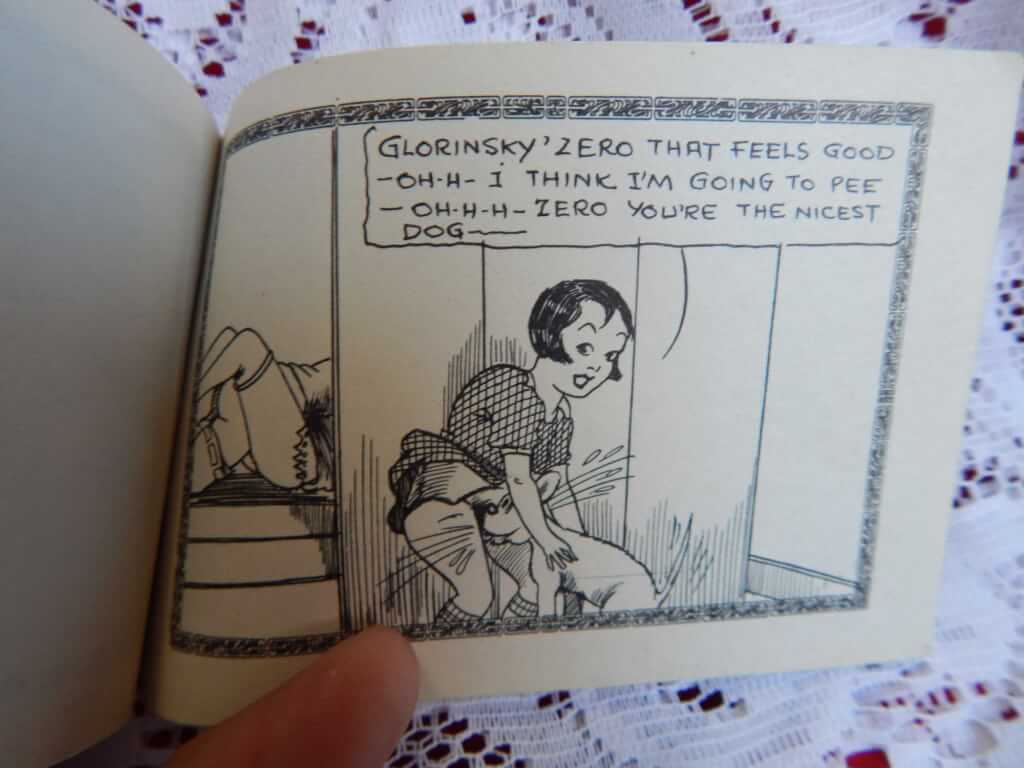
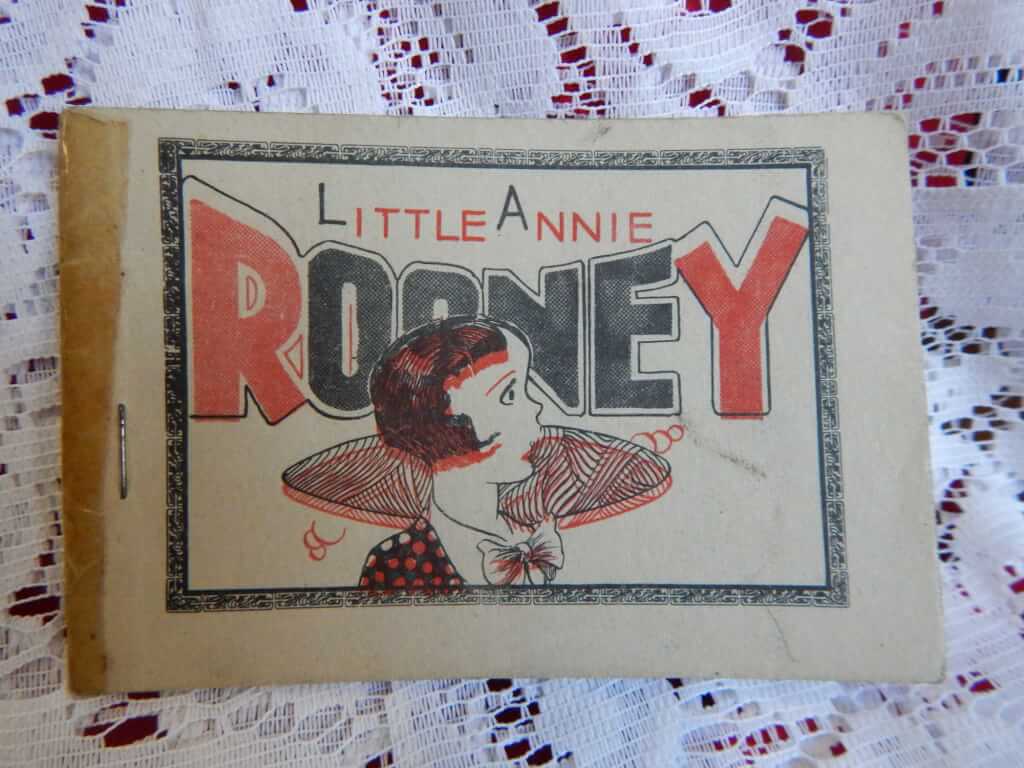 Little Annie Rooney, (np. nd.) 4.5" x 3", 8pp., pamphlet, stapled and taped Tijuana bibles (also known as eight-pagers, bluesies, gray-backs, Jiggs-and-Maggie books, jo-jo books, Tillie-and-Mac books, and two-by-fours) were little pornographic comic books produced in the United States from the 1920s to the early 1960s.
Little Annie Rooney, (np. nd.) 4.5" x 3", 8pp., pamphlet, stapled and taped Tijuana bibles (also known as eight-pagers, bluesies, gray-backs, Jiggs-and-Maggie books, jo-jo books, Tillie-and-Mac books, and two-by-fours) were little pornographic comic books produced in the United States from the 1920s to the early 1960s. -

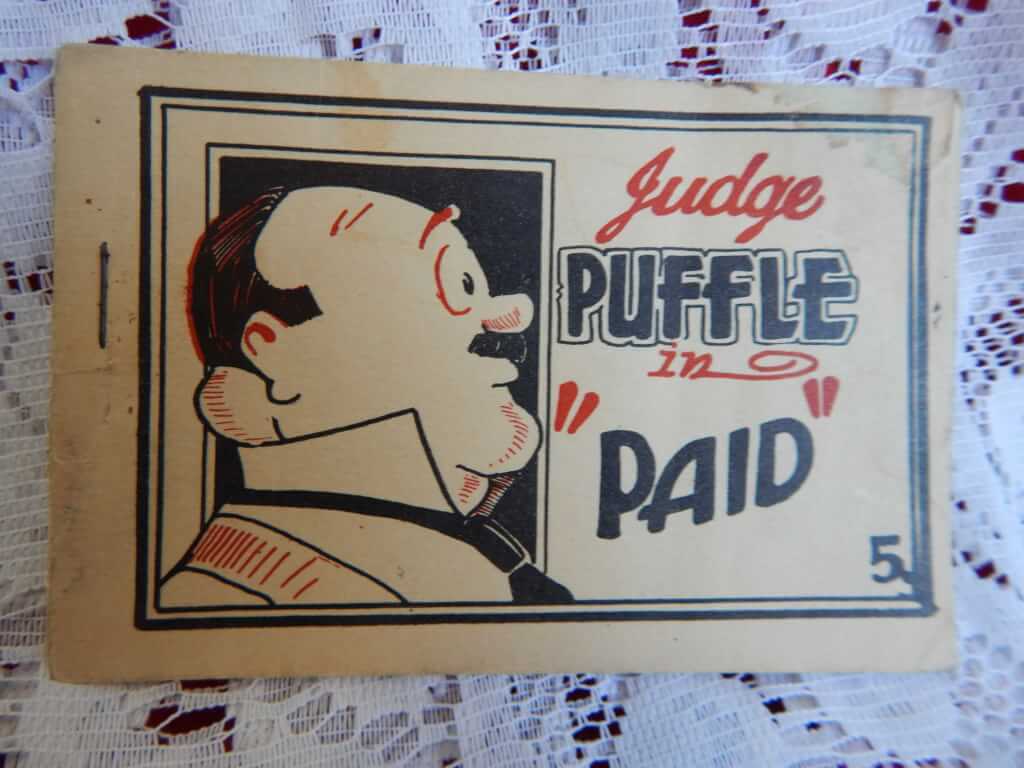 Judge Puffle in "Paid", (np. nd.) 4.5" x 3", 8pp. pamphlet, stapled Tijuana bibles (also known as eight-pagers, bluesies, gray-backs, Jiggs-and-Maggie books, jo-jo books, Tillie-and-Mac books, and two-by-fours) were little pornographic comic books produced in the United States from the 1920s to the early 1960s.
Judge Puffle in "Paid", (np. nd.) 4.5" x 3", 8pp. pamphlet, stapled Tijuana bibles (also known as eight-pagers, bluesies, gray-backs, Jiggs-and-Maggie books, jo-jo books, Tillie-and-Mac books, and two-by-fours) were little pornographic comic books produced in the United States from the 1920s to the early 1960s. -

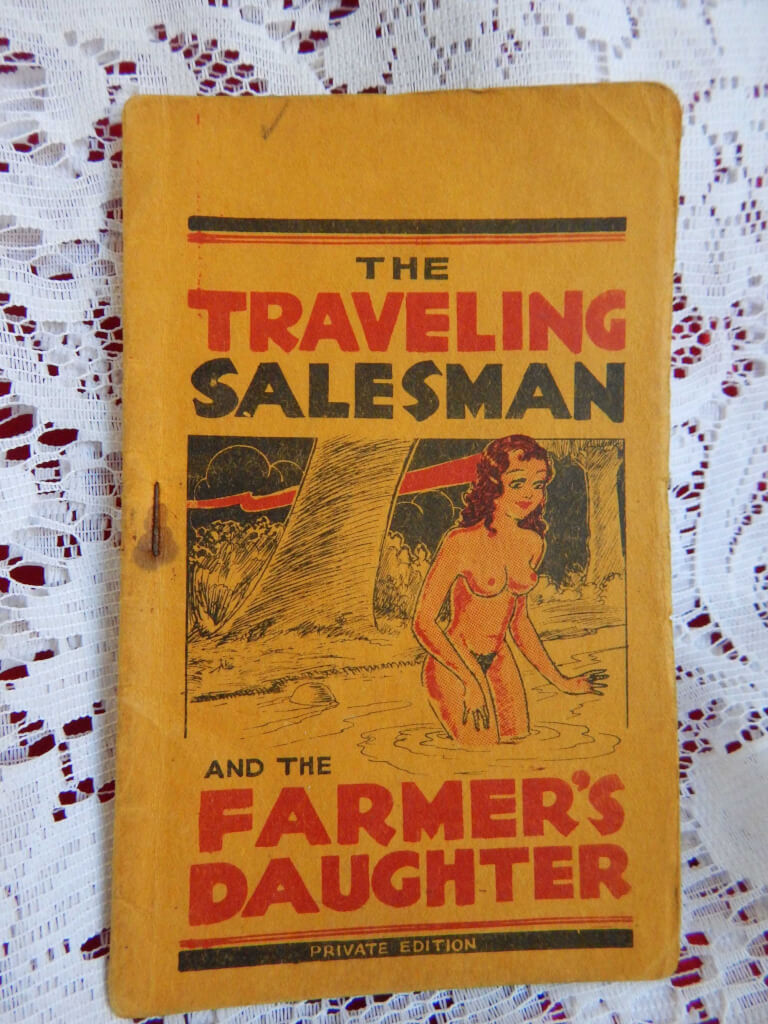 The Traveling Salesman and the Farmer's Daughter, (stated "Published by Fartgold Bros., Pokemyass, NY, 1935") 3.25" x 6", 16pp. pamphlet, stapled In the style of a "Tijuana bible" but larger and with 16 pages (instead of the traditional 8). Cover art and back cover in black and red. Tijuana bibles (also known as eight-pagers, bluesies, gray-backs, Jiggs-and-Maggie books, jo-jo books, Tillie-and-Mac books, and two-by-fours) were little pornographic comic books produced in the United States from the 1920s to the early 1960s.
The Traveling Salesman and the Farmer's Daughter, (stated "Published by Fartgold Bros., Pokemyass, NY, 1935") 3.25" x 6", 16pp. pamphlet, stapled In the style of a "Tijuana bible" but larger and with 16 pages (instead of the traditional 8). Cover art and back cover in black and red. Tijuana bibles (also known as eight-pagers, bluesies, gray-backs, Jiggs-and-Maggie books, jo-jo books, Tillie-and-Mac books, and two-by-fours) were little pornographic comic books produced in the United States from the 1920s to the early 1960s. -
Out of stock

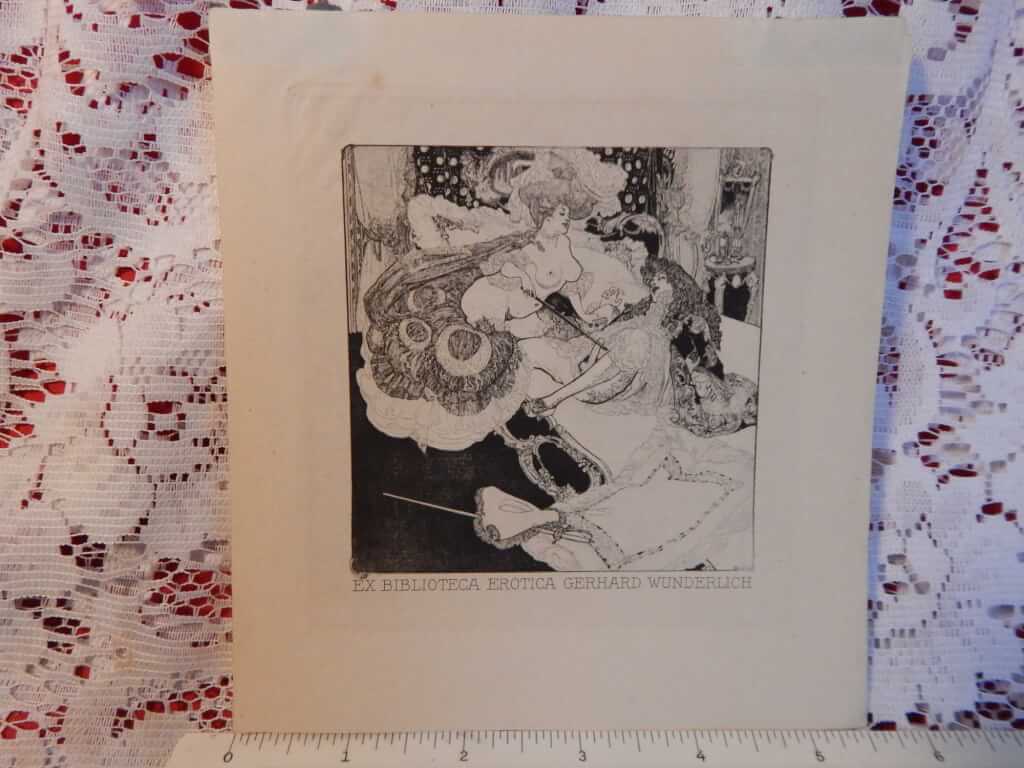 Ex Biblioteca Erotica Gerhard Wunderlich, by Franz von Bayros naked woman with cane, holding it against erect penis, remnants of pastedown at top of back Franz von Bayros (1866 – 1924) was an Austrian commercial artist, illustrator, and painter, now he is best known for his erotic work. He belonged to the Decadent movement in art, often utilizing erotic themes and phantasmagoric imagery. At the age 17, Bayros passed the entrance exam for the Vienna Academy with Eduard von Engerth. Bayros mixed in elegant society and soon belonged to the circle of friends of Johann Straub, whose step daughter Alice he married on 1896. The next year, Bayros moved to Munich. In 1904, Bayros gave his first exhibition in Munich, which was a great success. From 1904 until 1908, Bayros traveled to Paris and Italy for his studies. Typically, for an artist dealing with such imagery, von Bayros produced work under several pseudonyms, most notably Choisy Le Conin, and was hounded by authorities for much of his life for his “indecent” art often very imaginative, and including such taboo subjects as sadomasochism and bestiality. He became equally well-known for his masterly drawn figures of elegant modestly nude and non-nude women.
Ex Biblioteca Erotica Gerhard Wunderlich, by Franz von Bayros naked woman with cane, holding it against erect penis, remnants of pastedown at top of back Franz von Bayros (1866 – 1924) was an Austrian commercial artist, illustrator, and painter, now he is best known for his erotic work. He belonged to the Decadent movement in art, often utilizing erotic themes and phantasmagoric imagery. At the age 17, Bayros passed the entrance exam for the Vienna Academy with Eduard von Engerth. Bayros mixed in elegant society and soon belonged to the circle of friends of Johann Straub, whose step daughter Alice he married on 1896. The next year, Bayros moved to Munich. In 1904, Bayros gave his first exhibition in Munich, which was a great success. From 1904 until 1908, Bayros traveled to Paris and Italy for his studies. Typically, for an artist dealing with such imagery, von Bayros produced work under several pseudonyms, most notably Choisy Le Conin, and was hounded by authorities for much of his life for his “indecent” art often very imaginative, and including such taboo subjects as sadomasochism and bestiality. He became equally well-known for his masterly drawn figures of elegant modestly nude and non-nude women. -
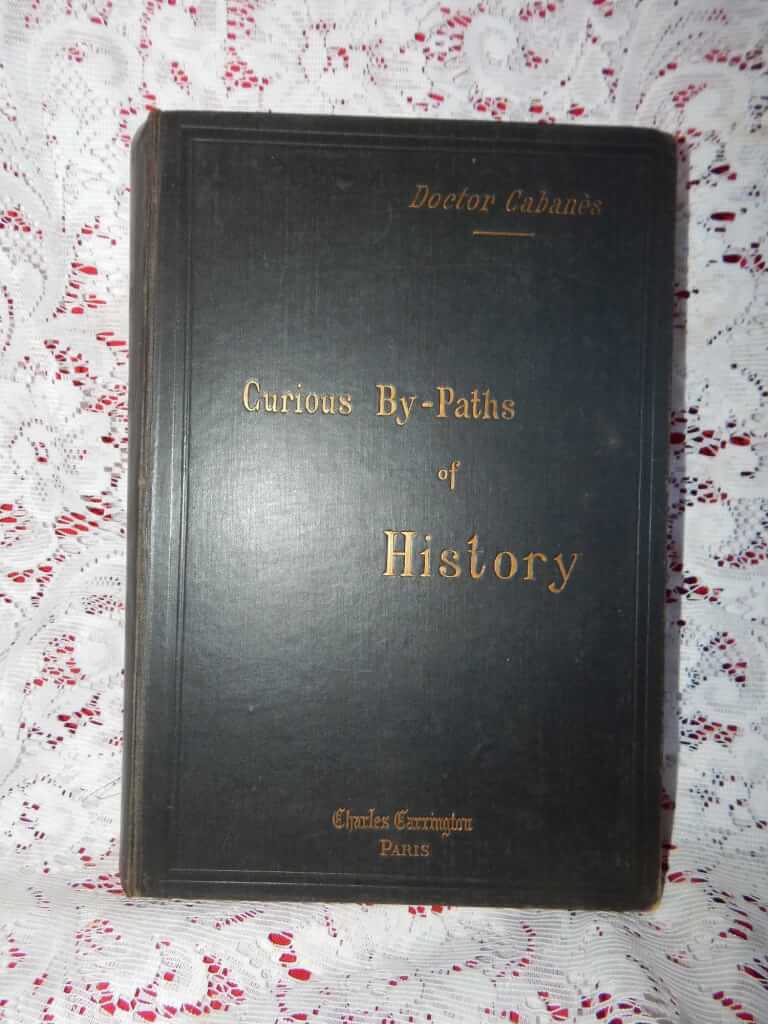
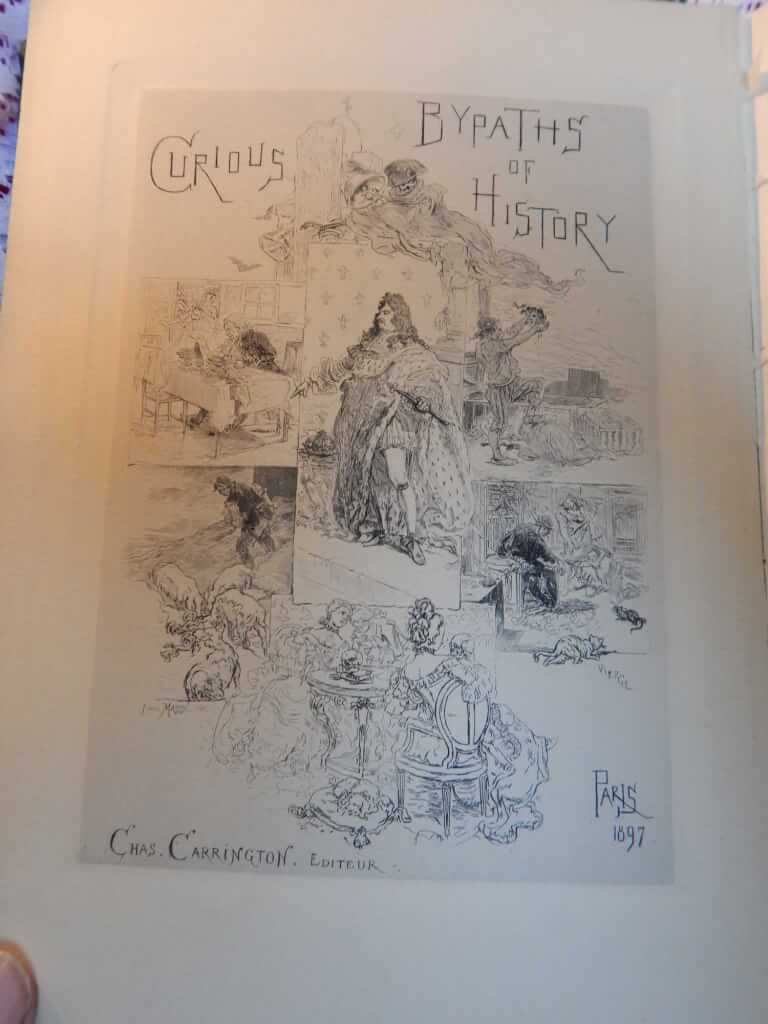 Curious Bypaths of History: Being Medico-Historical Studies and Observations, by Dr. [Augustin] Cabanès, frontispiece by Daniel Vierge engraved on copper by F. Massé (Librairie Des Bibliophiles, Charles Carrington, Éditeur, Paris 1898, #238/500) 7"x10", xx+367pp, black cloth with gilt titles on cover and spine (spine titles faded), front boards loose but holding, marbled endpapers, printed on "Van Gelder's vellum paper", gilt top edge, other edges deckled. Charles Carrington published a series of 3 books looking into the private lives of the French aristocracy titled, "Pathological studies of the past". The books are Secret Cabinet of History Peeped into By a Doctor (1897), Curious Bypaths of History: Being Medico-Historical Studies and Observations (1898), Flagellation in France from a medical and historical standpoint (1898). The first two and possibly the third were written by Dr. Augustin Cabanès (1862-1928), a French doctor, historian and author. Contents of this book, Curious Bypaths of History, include: The Teeth of Louis Xi, The Clandestine Accouchements of Mdlle De La Valliere (Louise de La Vallière was a mistress of Louis XIV of France from 1661 to 1667.), Illustrious Remains And Anatomical Relics. — the Skeleton of Mme De Maintenon And the Skull of Mme De Sevigne, The Infirmities of Sophie Arnould (a very popular French operatic soprano), Was Dr. Guillotin the Inventor Or the God-Father, of the Guillotine?, the Real Charlotte Corday. — Her Personal Appearance (Marie-Anne Charlotte de Corday d'Armont was a figure of the French Revolution. In 1793, she was executed by guillotine for the assassination of Jacobin leader Jean-Paul Marat, who was in part responsible for the more radical course the Revolution had taken through his role as a politician and journalist.), The Superstitions of Napoleon I, A Romance With Three Actors: Alfred De Musset, George Sand, And Doctor Pagello.
Curious Bypaths of History: Being Medico-Historical Studies and Observations, by Dr. [Augustin] Cabanès, frontispiece by Daniel Vierge engraved on copper by F. Massé (Librairie Des Bibliophiles, Charles Carrington, Éditeur, Paris 1898, #238/500) 7"x10", xx+367pp, black cloth with gilt titles on cover and spine (spine titles faded), front boards loose but holding, marbled endpapers, printed on "Van Gelder's vellum paper", gilt top edge, other edges deckled. Charles Carrington published a series of 3 books looking into the private lives of the French aristocracy titled, "Pathological studies of the past". The books are Secret Cabinet of History Peeped into By a Doctor (1897), Curious Bypaths of History: Being Medico-Historical Studies and Observations (1898), Flagellation in France from a medical and historical standpoint (1898). The first two and possibly the third were written by Dr. Augustin Cabanès (1862-1928), a French doctor, historian and author. Contents of this book, Curious Bypaths of History, include: The Teeth of Louis Xi, The Clandestine Accouchements of Mdlle De La Valliere (Louise de La Vallière was a mistress of Louis XIV of France from 1661 to 1667.), Illustrious Remains And Anatomical Relics. — the Skeleton of Mme De Maintenon And the Skull of Mme De Sevigne, The Infirmities of Sophie Arnould (a very popular French operatic soprano), Was Dr. Guillotin the Inventor Or the God-Father, of the Guillotine?, the Real Charlotte Corday. — Her Personal Appearance (Marie-Anne Charlotte de Corday d'Armont was a figure of the French Revolution. In 1793, she was executed by guillotine for the assassination of Jacobin leader Jean-Paul Marat, who was in part responsible for the more radical course the Revolution had taken through his role as a politician and journalist.), The Superstitions of Napoleon I, A Romance With Three Actors: Alfred De Musset, George Sand, And Doctor Pagello. -
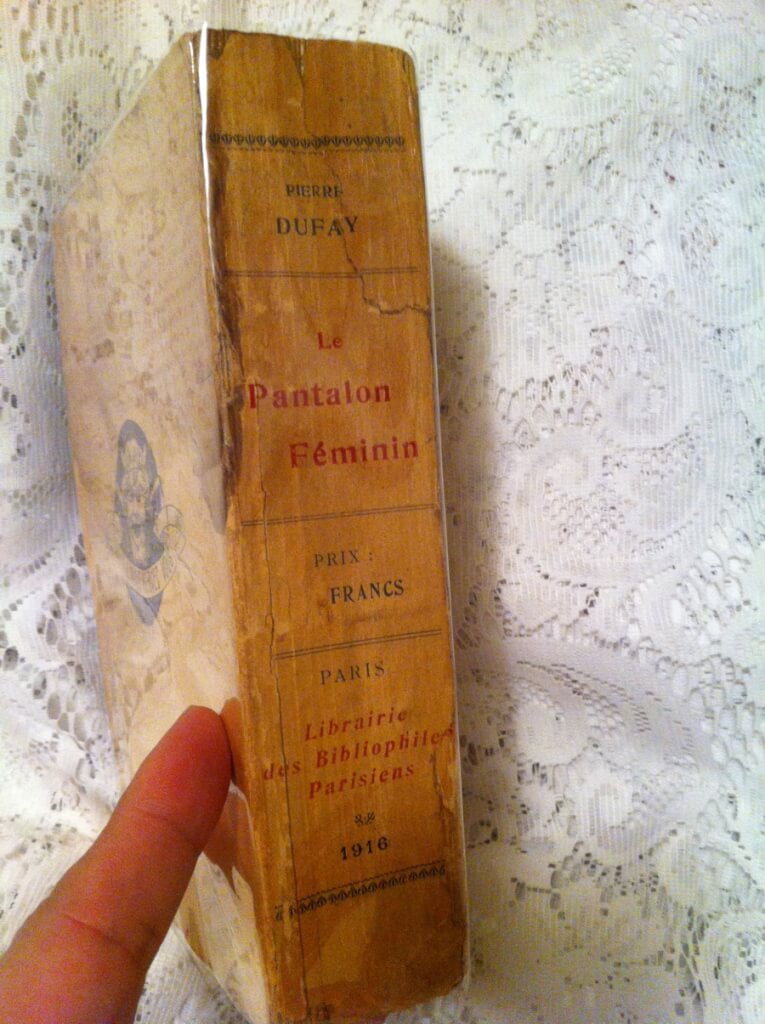
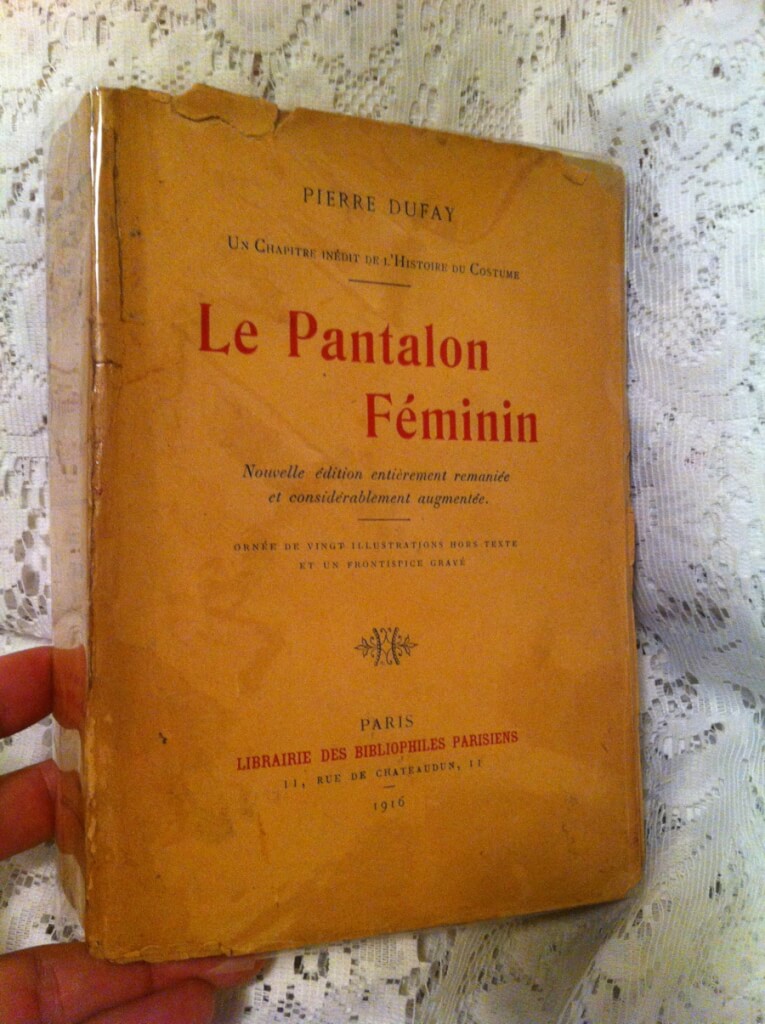 Le Pantalon Féminin (Un chapitre inédit de l'Histoire du Costume) by Pierre Dufay, preface by d'Armand Silvestre (Charles Carrington, Librairie Des Bibliophiles Parisiens, 1916, Paris) 7.75" X 5.75", xv 584pp., original soft wraps protected by a clear archival dust cover. Deckled edges. Some pages remain uncut. Index, table of contents, errata, and 5 pages of ads in the back. Good condition for age, some tears to the edges of cover, stain on the back. A rare find with it's illustrations intact.
Le Pantalon Féminin (Un chapitre inédit de l'Histoire du Costume) by Pierre Dufay, preface by d'Armand Silvestre (Charles Carrington, Librairie Des Bibliophiles Parisiens, 1916, Paris) 7.75" X 5.75", xv 584pp., original soft wraps protected by a clear archival dust cover. Deckled edges. Some pages remain uncut. Index, table of contents, errata, and 5 pages of ads in the back. Good condition for age, some tears to the edges of cover, stain on the back. A rare find with it's illustrations intact. -
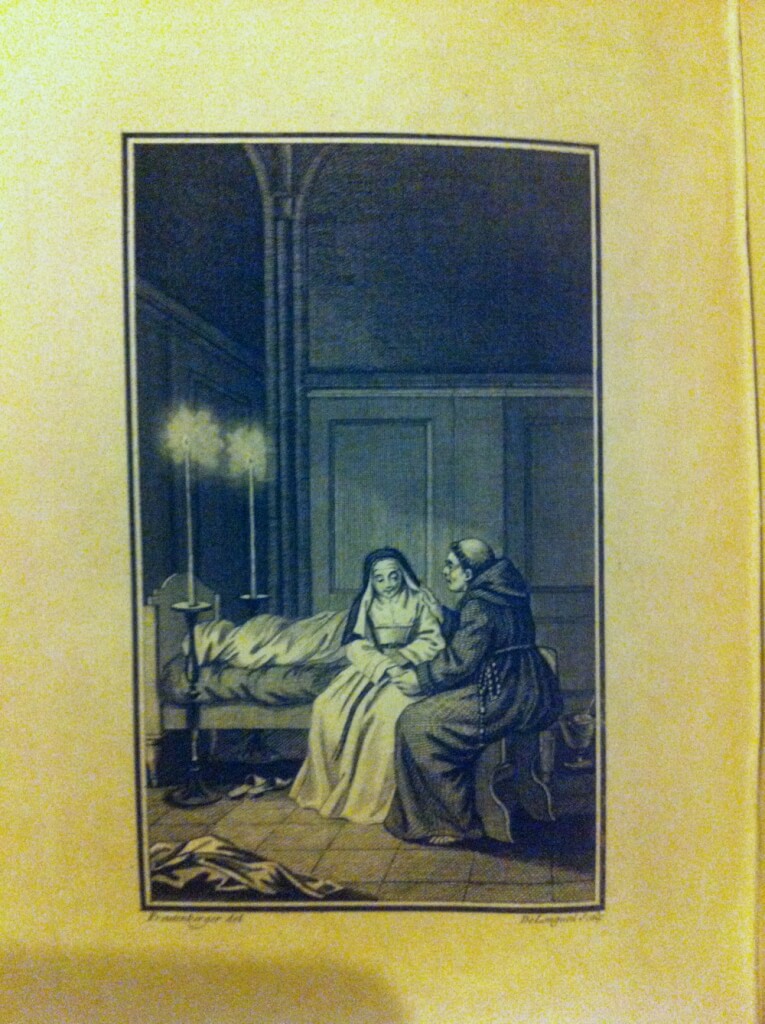
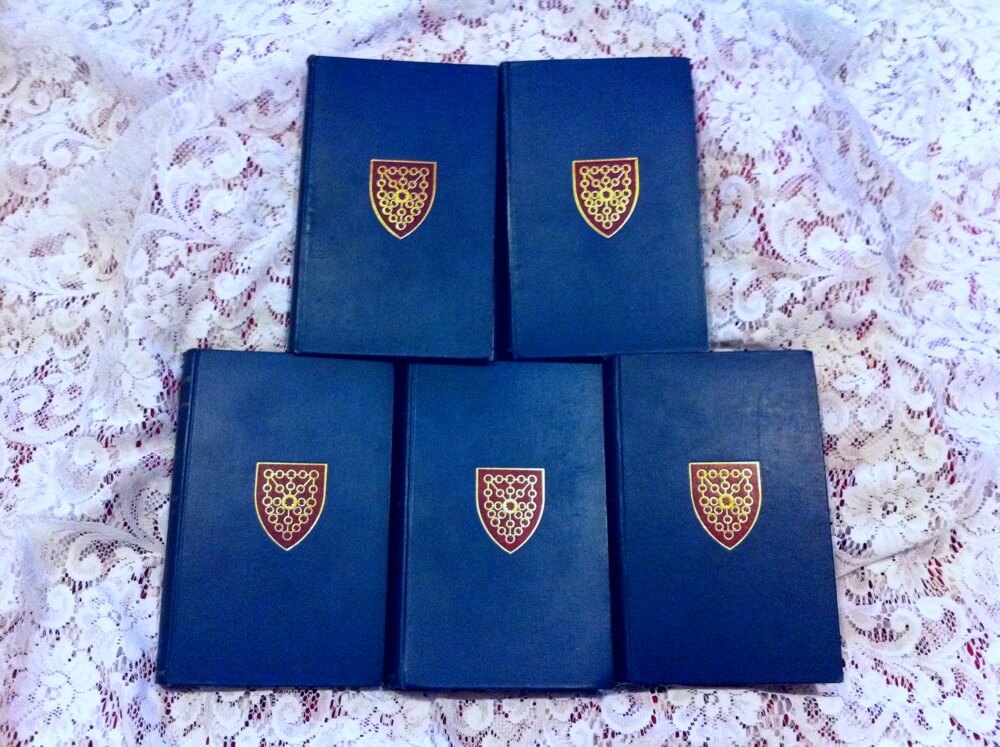 The Heptameron, of the Tales of Margaret, Queen of Navarre, Margaret of Navarre, illustrated by S Freudenberg & Dunker, "translated into English from the Authentic Text of M. Le Roux De Lincy", essay by George Saintsbury, M.A. (The Society of English Bibliophilists, London, 1894) 8.5" X 5.25", 5 volumes 262pp, 226pp, 216pp, 244p, 264pp, blue linen covered boards with gilt titles, red and gilt decorations on covers, edges deckled. Good condition, minor bumps and scuffs. The Heptameron is a collection of 72 short stories written in French by Marguerite of Navarre (1492-1549), published posthumously in 1558. It has the form of a frame narrative and was inspired by The Decameron of Giovanni Boccaccio. It was originally intended to contain one hundred stories covering ten days just as The Decameron does, but at Marguerite's death it was only completed as far as the second story of the eighth day. Many of the stories deal with love, lust, infidelity and other romantic and sexual matters. This 5 volume set is very nice edition containing "the Original Seventy-three Full Page Engravings Designed by S. FREUDENBERG And One Hundred and Fifty Head and Tail Pieces By DUNKER"
The Heptameron, of the Tales of Margaret, Queen of Navarre, Margaret of Navarre, illustrated by S Freudenberg & Dunker, "translated into English from the Authentic Text of M. Le Roux De Lincy", essay by George Saintsbury, M.A. (The Society of English Bibliophilists, London, 1894) 8.5" X 5.25", 5 volumes 262pp, 226pp, 216pp, 244p, 264pp, blue linen covered boards with gilt titles, red and gilt decorations on covers, edges deckled. Good condition, minor bumps and scuffs. The Heptameron is a collection of 72 short stories written in French by Marguerite of Navarre (1492-1549), published posthumously in 1558. It has the form of a frame narrative and was inspired by The Decameron of Giovanni Boccaccio. It was originally intended to contain one hundred stories covering ten days just as The Decameron does, but at Marguerite's death it was only completed as far as the second story of the eighth day. Many of the stories deal with love, lust, infidelity and other romantic and sexual matters. This 5 volume set is very nice edition containing "the Original Seventy-three Full Page Engravings Designed by S. FREUDENBERG And One Hundred and Fifty Head and Tail Pieces By DUNKER" -
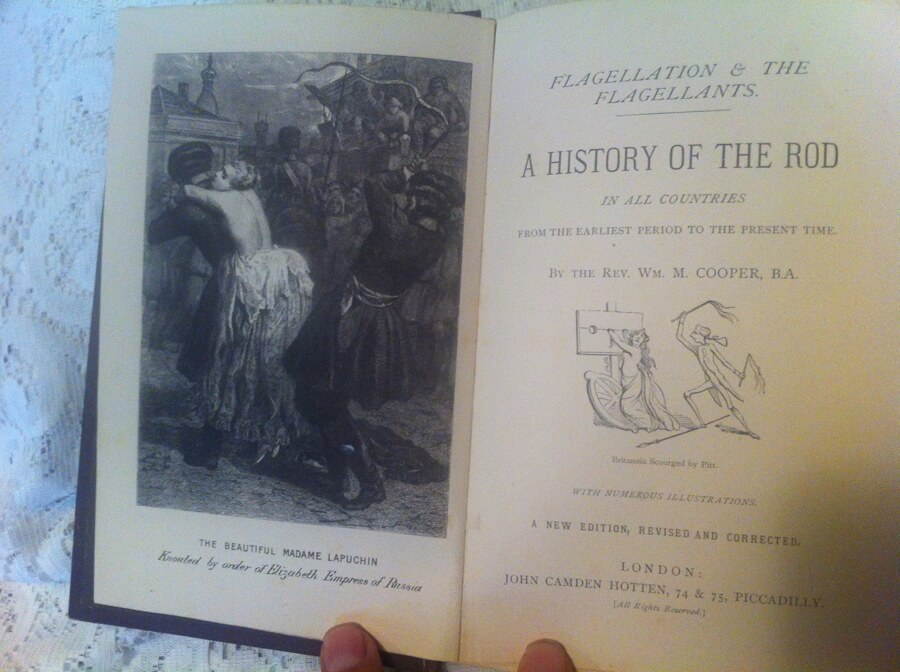
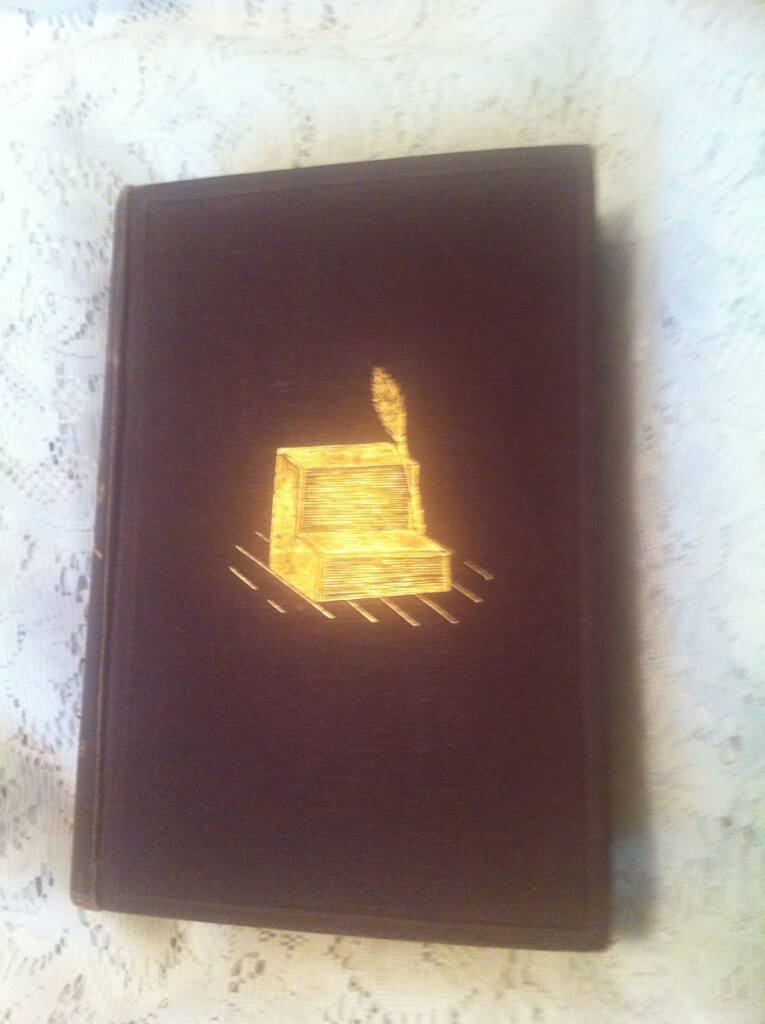 Flagellation & the Flagellants. a History of the Rod in All Countries, The Rev. Wm. M. Cooper, B.A. [James Glass Bertram] (John Camden Hotten, London, n.d. [1873, from ads at end of book] "a new edition revised and corrected") 7 3/4" X 5 1/2", 544pp plus 32 pages of advertisements for "Very Important New Books", hardbound with red cloth, gilt lettering and decorations, spine worn at top and bottom and lower front, Very Good condition, corners bumped, top and bottom of spine worn, boards slightly loose. Ex libris: "From the library of Walter Wentworth Allerton" Bertram was apprenticed to Tait's Edinburgh Magazine and became managing clerk, before joining a company of strolling players. He returned to Edinburgh and set up as a bookseller and newsagent. In 1855 he was appointed the editor of the North Briton and in 1872 of the Glasgow News, leaving to become a freelance journalist two years later. He published "flagellation" pornography under the names "Revd William Cooper" and "Margaret Anson". Illustrated throughout. This is a later "newly revised edition" from Hotten and the version used for the Reeves edition.
Flagellation & the Flagellants. a History of the Rod in All Countries, The Rev. Wm. M. Cooper, B.A. [James Glass Bertram] (John Camden Hotten, London, n.d. [1873, from ads at end of book] "a new edition revised and corrected") 7 3/4" X 5 1/2", 544pp plus 32 pages of advertisements for "Very Important New Books", hardbound with red cloth, gilt lettering and decorations, spine worn at top and bottom and lower front, Very Good condition, corners bumped, top and bottom of spine worn, boards slightly loose. Ex libris: "From the library of Walter Wentworth Allerton" Bertram was apprenticed to Tait's Edinburgh Magazine and became managing clerk, before joining a company of strolling players. He returned to Edinburgh and set up as a bookseller and newsagent. In 1855 he was appointed the editor of the North Briton and in 1872 of the Glasgow News, leaving to become a freelance journalist two years later. He published "flagellation" pornography under the names "Revd William Cooper" and "Margaret Anson". Illustrated throughout. This is a later "newly revised edition" from Hotten and the version used for the Reeves edition. -
 Les Idylles, Théocrite, J. A. Gullet trans., Méaulle illus. (A. Quantin, Imprimeur-Éditeur, Paris 1884) 5.75″ X 4", 192pp, three-quarter leather over marbled boards, gilt titles and decorations on spine, boards rubbed quite a bit, binding good, top-edge gilt, others deckled, ex-libris of Dr. phil. Rudolf Ludwig designed by Franz von Bayros (voluptuous naked woman surrounded by books with men in shackles enthusiastically bringing her more. A child with a magnifying glass astride a penis decorated with a world globe/map.) Theocritus (c 300 BC- c 260 BC) was a Greek poet from Sicily and the creator of Ancient Greek pastoral poetry. Unlike Homer, Theocritus did not engage in heroes and warfare. His idylls are limited to a small intimate world and describe scenes from everyday life.
Les Idylles, Théocrite, J. A. Gullet trans., Méaulle illus. (A. Quantin, Imprimeur-Éditeur, Paris 1884) 5.75″ X 4", 192pp, three-quarter leather over marbled boards, gilt titles and decorations on spine, boards rubbed quite a bit, binding good, top-edge gilt, others deckled, ex-libris of Dr. phil. Rudolf Ludwig designed by Franz von Bayros (voluptuous naked woman surrounded by books with men in shackles enthusiastically bringing her more. A child with a magnifying glass astride a penis decorated with a world globe/map.) Theocritus (c 300 BC- c 260 BC) was a Greek poet from Sicily and the creator of Ancient Greek pastoral poetry. Unlike Homer, Theocritus did not engage in heroes and warfare. His idylls are limited to a small intimate world and describe scenes from everyday life. -

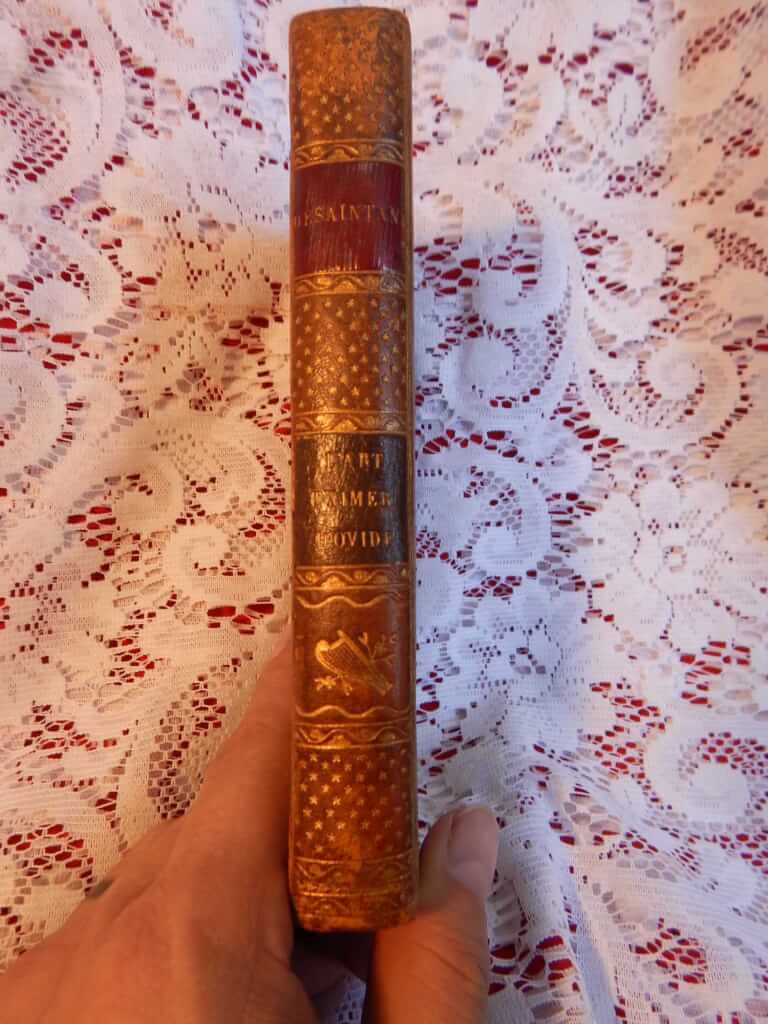 L'art d'aimer d'Ovide, traduction en vers, avec des remarques par M. Desaintange (Chez Giguet et Michaud, Paris, 1807, first edition of translation) 5"x8", 320pp, full calf, gilt titles and decorations to spine, marbled boards, some rubbing and bumping, good+ condition for age, finely engraved frontispiece, unknown artist French language translation by Saint-Ange of Ovid's The Art of Love. Publius Ovidius Naso (43 BC – AD 17/18), known as Ovid in the English-speaking world, was a Roman poet who lived during the reign of Augustus. He was a contemporary of the older Virgil and Horace, with whom he is often ranked as one of the three canonical poets of Latin literature. The Imperial scholar Quintilian considered him the last of the Latin love elegists. He enjoyed enormous popularity, but, in one of the mysteries of literary history, was sent by Augustus into exile in a remote province on the Black Sea, where he remained until his death. Ovid himself attributes his exile to carmen et error, "a poem and a mistake", but his discretion in discussing the causes has resulted in much speculation among scholars. The first major Roman poet to begin his career during the reign of Augustus, Ovid is today best known for the Metamorphoses, a 15-book continuous mythological narrative written in the meter of epic, and for works in elegiac couplets such as Ars Amatoria ("The Art of Love") and Fasti. His poetry was much imitated during Late Antiquity and the Middle Ages, and greatly influenced Western art and literature. The Metamorphoses remains one of the most important sources of classical mythology. Ange-François Fariau de Saint-Ange (1747-1810), known as Saint-Ange was a French poet and translator. Born of a father adviser of the king, he studied at the collège des jésuites de Blois, then at the college Sainte-Barbe de Paris. He acquired from a young age a reputation for his his unparalleled wit. Protected by Turgot, he gained a place in general control, but found himself without resources in the Revolution. At the fall of Robespierre, he found a job in the clothing agency of the troops, then became then professor of belles-lettres, then of general and reasoned grammar, with the central school of the street Saint-Antoine. He was elected member of the French Academy in 1810. In his reception speech, sensing that his shaky health would not allow him to sit there for a long time, he declared: "I am doing violence, at this moment, to the continual suffering and intolerable who warn me that the shadow of the academician whom I replace is waiting for mine. Three months later, he suffered a fall and died while visiting the institute.
L'art d'aimer d'Ovide, traduction en vers, avec des remarques par M. Desaintange (Chez Giguet et Michaud, Paris, 1807, first edition of translation) 5"x8", 320pp, full calf, gilt titles and decorations to spine, marbled boards, some rubbing and bumping, good+ condition for age, finely engraved frontispiece, unknown artist French language translation by Saint-Ange of Ovid's The Art of Love. Publius Ovidius Naso (43 BC – AD 17/18), known as Ovid in the English-speaking world, was a Roman poet who lived during the reign of Augustus. He was a contemporary of the older Virgil and Horace, with whom he is often ranked as one of the three canonical poets of Latin literature. The Imperial scholar Quintilian considered him the last of the Latin love elegists. He enjoyed enormous popularity, but, in one of the mysteries of literary history, was sent by Augustus into exile in a remote province on the Black Sea, where he remained until his death. Ovid himself attributes his exile to carmen et error, "a poem and a mistake", but his discretion in discussing the causes has resulted in much speculation among scholars. The first major Roman poet to begin his career during the reign of Augustus, Ovid is today best known for the Metamorphoses, a 15-book continuous mythological narrative written in the meter of epic, and for works in elegiac couplets such as Ars Amatoria ("The Art of Love") and Fasti. His poetry was much imitated during Late Antiquity and the Middle Ages, and greatly influenced Western art and literature. The Metamorphoses remains one of the most important sources of classical mythology. Ange-François Fariau de Saint-Ange (1747-1810), known as Saint-Ange was a French poet and translator. Born of a father adviser of the king, he studied at the collège des jésuites de Blois, then at the college Sainte-Barbe de Paris. He acquired from a young age a reputation for his his unparalleled wit. Protected by Turgot, he gained a place in general control, but found himself without resources in the Revolution. At the fall of Robespierre, he found a job in the clothing agency of the troops, then became then professor of belles-lettres, then of general and reasoned grammar, with the central school of the street Saint-Antoine. He was elected member of the French Academy in 1810. In his reception speech, sensing that his shaky health would not allow him to sit there for a long time, he declared: "I am doing violence, at this moment, to the continual suffering and intolerable who warn me that the shadow of the academician whom I replace is waiting for mine. Three months later, he suffered a fall and died while visiting the institute. -
 Musk, Hashish and Blood, Hector France, illust. Paul Avril, [trans. most likely Alfred Richard Allinson] (Walpole Press [identical to the 1899 Charles Carrington edition], London and Paris, 1900) 8.5″ X 5.5″, xiii 447pp., hardbound, green boards with gilt tittles and decorations, top-edge gilt others deckled, frontispiece with tissue guard and numerous illustrations throughout. Good condition, label pasted on the last page states “Charles Carrington, 13, Faubourg Montmartre, 13, Paris. IX.” Hector France (1837 - 1908) was a French author best known for his "orientalist" and flagellation tales. This graphic and exciting picture of the Algerian desert, its tribes and their astounding customs is a sensational recounting of France's experiences in North Africa. France tells the stories of his adventures in the nineteenth century Arab world from an eyewitness view. "The adventures of a modern man among the cruel men and passionate women of Algiers." Édouard-Henri Avril (1849-1928) used the pseudonym "Paul Avril" for his erotic work. He was a French painter and commercial artist. His career saw collaboration with influential people like Octave Uzanne, Henry Spencer Ashbee and Friedrich Karl Forberg. He is one of the most celebrated erotic artists of his age. Avril was a soldier before starting his career in art. He was awarded with the Legion of Honour for his actions in the Franco-Prussian War.
Musk, Hashish and Blood, Hector France, illust. Paul Avril, [trans. most likely Alfred Richard Allinson] (Walpole Press [identical to the 1899 Charles Carrington edition], London and Paris, 1900) 8.5″ X 5.5″, xiii 447pp., hardbound, green boards with gilt tittles and decorations, top-edge gilt others deckled, frontispiece with tissue guard and numerous illustrations throughout. Good condition, label pasted on the last page states “Charles Carrington, 13, Faubourg Montmartre, 13, Paris. IX.” Hector France (1837 - 1908) was a French author best known for his "orientalist" and flagellation tales. This graphic and exciting picture of the Algerian desert, its tribes and their astounding customs is a sensational recounting of France's experiences in North Africa. France tells the stories of his adventures in the nineteenth century Arab world from an eyewitness view. "The adventures of a modern man among the cruel men and passionate women of Algiers." Édouard-Henri Avril (1849-1928) used the pseudonym "Paul Avril" for his erotic work. He was a French painter and commercial artist. His career saw collaboration with influential people like Octave Uzanne, Henry Spencer Ashbee and Friedrich Karl Forberg. He is one of the most celebrated erotic artists of his age. Avril was a soldier before starting his career in art. He was awarded with the Legion of Honour for his actions in the Franco-Prussian War. -
 "A Defence of Women for their Inconstancy & their Paintings made by Jack Donne & printed now with five decorations by Norman Lindsay" (Fanfrolico Press, London, 1925, #161/370) 7.5" X 5.5", unpaginated [12], brown cloth boards with gilt titles on spine, very good condition for age, slight bumping to corners. Woman’s Constancy” is one of John Donne’s many metaphysical poems of the 16th century. He writes this poem to a woman who he is or was in a relationship with. Despite the title, he talks about how inconsistent the woman’s love is and presents it in a series of questions. The poem describes a situation where a man has been loved by a woman for an entire day. However, he wonders if she will declare her love for another man the day after. He thinks that the woman’s logic is that the oath of love ends when one partner dies, and that since sleep resembles death, it is okay for the oath of love to be broken. For the woman to be true to herself, she must admit her false statements of love. The author thinks that he is more intelligent than her and states that he will not argue with her about her reasons for leaving him. However, Donne states that the following day he may feel the same way that she does. John Donne (1572 - 1631) was an English poet, scholar, soldier and secretary born into a recusant family, who later became a cleric in the Church of England. Under royal patronage, he was made Dean of St Paul's Cathedral in London (1621–1631). He is considered the preeminent representative of the metaphysical poets. His poetical works are noted for their metaphorical and sensual style and include sonnets, love poems, religious poems, Latin translations, epigrams, elegies, songs and satires. He is also known for his sermons. Donne's style is characterized by abrupt openings and various paradoxes, ironies and dislocations. These features, along with his frequent dramatic or everyday speech rhythms, his tense syntax and his tough eloquence, were both a reaction against the smoothness of conventional Elizabethan poetry and an adaptation into English of European baroque and mannerist techniques. His early career was marked by poetry that bore immense knowledge of English society. Another important theme in Donne's poetry is the idea of true religion, something that he spent much time considering and about which he often theorized. He wrote secular poems as well as erotic and love poems. He is particularly famous for his mastery of metaphysical conceits. Despite his great education and poetic talents, Donne lived in poverty for several years, relying heavily on wealthy friends. He spent much of the money he inherited during and after his education on womanising, literature, pastimes and travel. In 1601, Donne secretly married Anne More, with whom he had twelve children. In 1615 he was ordained Anglican deacon and then priest, although he did not want to take holy orders and only did so because the king ordered it. He also served as a member of Parliament in 1601 and in 1614. Fanfrolico Press, Australia’s first ‘private press’ in the arts-and-craft tradition, was founded by Jack Lindsay, P. R. Stephensen and John Kirtley, originally in North Sydney in 1923. The press specialized in printings artful, limited editions of classics and forgotten works that were suited to the extravagant style of artist like his father, artist, sculptor and author Norman Lindsay who illustrated many of their books. Fanfrolico was scornful of modernism and with its florid style determinedly backward-looking. They did surprisingly well, despite the lack of business expertise of their young, ambitious "bohemian" owners, eking out a living despite the risky move to London in 1926 and upheavals in ownership that saw the departure in 1927 of Kirtley, and then Stephenson in 1929. Sometime in 1930 they published their last book. Norman Alfred William Lindsay (1879-1969) was an Australian artist, etcher, sculptor, writer, editorial cartoonist, scale modeller, and an accomplished amateur boxer. Lindsay is widely regarded as one of Australia's greatest artists, producing a vast body of work in different media, including pen drawing, etching, watercolour, oil and sculptures in concrete and bronze. His frank and sumptuous nudes were highly controversial. In 1940, his wife took sixteen crates of paintings, drawings and etchings to the U.S. to protect them from the war. Unfortunately, they were discovered when the train they were on caught fire. The pieces were impounded and subsequently burned as pornography by American officials.
"A Defence of Women for their Inconstancy & their Paintings made by Jack Donne & printed now with five decorations by Norman Lindsay" (Fanfrolico Press, London, 1925, #161/370) 7.5" X 5.5", unpaginated [12], brown cloth boards with gilt titles on spine, very good condition for age, slight bumping to corners. Woman’s Constancy” is one of John Donne’s many metaphysical poems of the 16th century. He writes this poem to a woman who he is or was in a relationship with. Despite the title, he talks about how inconsistent the woman’s love is and presents it in a series of questions. The poem describes a situation where a man has been loved by a woman for an entire day. However, he wonders if she will declare her love for another man the day after. He thinks that the woman’s logic is that the oath of love ends when one partner dies, and that since sleep resembles death, it is okay for the oath of love to be broken. For the woman to be true to herself, she must admit her false statements of love. The author thinks that he is more intelligent than her and states that he will not argue with her about her reasons for leaving him. However, Donne states that the following day he may feel the same way that she does. John Donne (1572 - 1631) was an English poet, scholar, soldier and secretary born into a recusant family, who later became a cleric in the Church of England. Under royal patronage, he was made Dean of St Paul's Cathedral in London (1621–1631). He is considered the preeminent representative of the metaphysical poets. His poetical works are noted for their metaphorical and sensual style and include sonnets, love poems, religious poems, Latin translations, epigrams, elegies, songs and satires. He is also known for his sermons. Donne's style is characterized by abrupt openings and various paradoxes, ironies and dislocations. These features, along with his frequent dramatic or everyday speech rhythms, his tense syntax and his tough eloquence, were both a reaction against the smoothness of conventional Elizabethan poetry and an adaptation into English of European baroque and mannerist techniques. His early career was marked by poetry that bore immense knowledge of English society. Another important theme in Donne's poetry is the idea of true religion, something that he spent much time considering and about which he often theorized. He wrote secular poems as well as erotic and love poems. He is particularly famous for his mastery of metaphysical conceits. Despite his great education and poetic talents, Donne lived in poverty for several years, relying heavily on wealthy friends. He spent much of the money he inherited during and after his education on womanising, literature, pastimes and travel. In 1601, Donne secretly married Anne More, with whom he had twelve children. In 1615 he was ordained Anglican deacon and then priest, although he did not want to take holy orders and only did so because the king ordered it. He also served as a member of Parliament in 1601 and in 1614. Fanfrolico Press, Australia’s first ‘private press’ in the arts-and-craft tradition, was founded by Jack Lindsay, P. R. Stephensen and John Kirtley, originally in North Sydney in 1923. The press specialized in printings artful, limited editions of classics and forgotten works that were suited to the extravagant style of artist like his father, artist, sculptor and author Norman Lindsay who illustrated many of their books. Fanfrolico was scornful of modernism and with its florid style determinedly backward-looking. They did surprisingly well, despite the lack of business expertise of their young, ambitious "bohemian" owners, eking out a living despite the risky move to London in 1926 and upheavals in ownership that saw the departure in 1927 of Kirtley, and then Stephenson in 1929. Sometime in 1930 they published their last book. Norman Alfred William Lindsay (1879-1969) was an Australian artist, etcher, sculptor, writer, editorial cartoonist, scale modeller, and an accomplished amateur boxer. Lindsay is widely regarded as one of Australia's greatest artists, producing a vast body of work in different media, including pen drawing, etching, watercolour, oil and sculptures in concrete and bronze. His frank and sumptuous nudes were highly controversial. In 1940, his wife took sixteen crates of paintings, drawings and etchings to the U.S. to protect them from the war. Unfortunately, they were discovered when the train they were on caught fire. The pieces were impounded and subsequently burned as pornography by American officials. -
 Your Sex Life | Before Marriage, Bob Hoffman (Strength & Health Publishing Co.,York, PA, 1939, first edition, third printing) 7.75" X 5.75", 206pp, hard bound blue cloth, just good condition, rubbing to boards, internal pages yellowing but good. Robert Collins Hoffman (1898 - 1985) was an American entrepreneur who rose to prominence as the owner of York Barbell. He founded magazines such as Muscular Development and Strength & Health, and was the manufacturer of a line of bodybuilding supplements. Hoffman promoted bodybuilders like John Grimek and Sigmund Klein, coached the American Olympic Weightlifting Team between 1936 and 1968, and was a founding member of the President's Council on Physical Fitness and Sports. This is a very rare copy of Hoffman book about premarital sex.
Your Sex Life | Before Marriage, Bob Hoffman (Strength & Health Publishing Co.,York, PA, 1939, first edition, third printing) 7.75" X 5.75", 206pp, hard bound blue cloth, just good condition, rubbing to boards, internal pages yellowing but good. Robert Collins Hoffman (1898 - 1985) was an American entrepreneur who rose to prominence as the owner of York Barbell. He founded magazines such as Muscular Development and Strength & Health, and was the manufacturer of a line of bodybuilding supplements. Hoffman promoted bodybuilders like John Grimek and Sigmund Klein, coached the American Olympic Weightlifting Team between 1936 and 1968, and was a founding member of the President's Council on Physical Fitness and Sports. This is a very rare copy of Hoffman book about premarital sex. -
 Memoirs of Cardinal Dubois | A complete unabridged translation from the French by Ernest Dowson | Embellished with photogravure portraits of Cardinal Dubois and the Duc d'Orleans, together with twelve full page drawings by Lui Trugo (Privately Printed for Subscribers [Art Studio Press], New York, 1929, #261/1500) 9.75"x6.5", 2 volumes on hand laid paper, xvi-376pp, viii-349pp, DJ over black cloth with gilt titles and decorations, top-edge inked, others deckled, good+ condition, few small tears to DJ, internally fine. According to the publisher, the original manuscript which was written entirely in Dubois hand was stolen by his secretary Lavergne after his death in 1723. It was later discovered of its literary value that Lavergne attempted to sell the manuscript. He was found and arrested. They later fell into the hands of Comte de Maurepas, then upon his death they were passed on to an anonymous writer named Mercier (possibly M. Paul Laroix) whose family had it published in 1829. The manuscript then became lost. In 1899 and English version of the book translated by Ernest Christopher Dowson, was published by the notorious pornographer, Leonard Smithers & Co. This is, presumably a reprinting of that translation. Guillaume Dubois (1656-1723), a son of a country doctor, rose from humble beginnings to positions of power and high honor in government and in the Catholic Church. He is best known for negotiating the Triple Alliance of 1717 between France, the Dutch Republic and Great Britain against their mutual enemy, Spain. Considered one of the four great French Cardinal-Ministers (Richelieu, Mazarin, Dubois, and Fleury). His ecclesiastical career left a great deal to be desired. Although there is no proof of the prevalent assertion that he got secretly married, his licentiousness, and notorious impiety, even at the time of his death, make it evident that he pursued and used ecclesiastical dignities principally to enhance his political position and prestige. Eventually in 1721, Du Bois was created cardinal. He had the reputation of a libertine and adventurer and made plenty of enemies. One of his rivals was charged at creating his portrait, the Duc de Saint-Simon, who was said to have placed a painting of Dubois in his lavatory. Saint-Simon had this to say about the Cardinal: "He was a little, pitiful, wizened, herring-gutted man, in a flaxen wig, with a weasel's face, brightened by some intellect. All the vices - perfidy, avarice, debauchery, ambition, flattery - fought within him for the mastery. He was so consummate a liar that, when taken in the fact, he could brazenly deny it. Even his wit and knowledge of the world were spoiled, and his affected gaiety was touched with sadness, by the odour of falsehood which escaped through every pore of his body." This famous picture is certainly biased. Dubois was unscrupulous, but so were his contemporaries, and whatever vices he had, he forged a European peace that, with the exception of small, restrained military expeditions against the Austrian Habsburgs, would last for a quarter of a century.
Memoirs of Cardinal Dubois | A complete unabridged translation from the French by Ernest Dowson | Embellished with photogravure portraits of Cardinal Dubois and the Duc d'Orleans, together with twelve full page drawings by Lui Trugo (Privately Printed for Subscribers [Art Studio Press], New York, 1929, #261/1500) 9.75"x6.5", 2 volumes on hand laid paper, xvi-376pp, viii-349pp, DJ over black cloth with gilt titles and decorations, top-edge inked, others deckled, good+ condition, few small tears to DJ, internally fine. According to the publisher, the original manuscript which was written entirely in Dubois hand was stolen by his secretary Lavergne after his death in 1723. It was later discovered of its literary value that Lavergne attempted to sell the manuscript. He was found and arrested. They later fell into the hands of Comte de Maurepas, then upon his death they were passed on to an anonymous writer named Mercier (possibly M. Paul Laroix) whose family had it published in 1829. The manuscript then became lost. In 1899 and English version of the book translated by Ernest Christopher Dowson, was published by the notorious pornographer, Leonard Smithers & Co. This is, presumably a reprinting of that translation. Guillaume Dubois (1656-1723), a son of a country doctor, rose from humble beginnings to positions of power and high honor in government and in the Catholic Church. He is best known for negotiating the Triple Alliance of 1717 between France, the Dutch Republic and Great Britain against their mutual enemy, Spain. Considered one of the four great French Cardinal-Ministers (Richelieu, Mazarin, Dubois, and Fleury). His ecclesiastical career left a great deal to be desired. Although there is no proof of the prevalent assertion that he got secretly married, his licentiousness, and notorious impiety, even at the time of his death, make it evident that he pursued and used ecclesiastical dignities principally to enhance his political position and prestige. Eventually in 1721, Du Bois was created cardinal. He had the reputation of a libertine and adventurer and made plenty of enemies. One of his rivals was charged at creating his portrait, the Duc de Saint-Simon, who was said to have placed a painting of Dubois in his lavatory. Saint-Simon had this to say about the Cardinal: "He was a little, pitiful, wizened, herring-gutted man, in a flaxen wig, with a weasel's face, brightened by some intellect. All the vices - perfidy, avarice, debauchery, ambition, flattery - fought within him for the mastery. He was so consummate a liar that, when taken in the fact, he could brazenly deny it. Even his wit and knowledge of the world were spoiled, and his affected gaiety was touched with sadness, by the odour of falsehood which escaped through every pore of his body." This famous picture is certainly biased. Dubois was unscrupulous, but so were his contemporaries, and whatever vices he had, he forged a European peace that, with the exception of small, restrained military expeditions against the Austrian Habsburgs, would last for a quarter of a century. -
 The Rahnghild Edition of: Venus in Furs, Leopold von Sacher-Masoch, illustrated by Rahnghild [Susan Inez Aguerra?] (William Faro, Inc [Samuel Roth, New York], 1932) 6.5"x9.25", 240pp, brown cloth boards with pasted title on spine, some soiling on front paste-down but overall a clean copy, beautiful art-deco illustrations throughout. Venus in Furs (German: Venus im Pelz) is a novella by Leopold Ritter von Sacher-Masoch (1836-1895), an Austrian writer and journalist. It is now his best known work and because of its themes the term masochism is derived from his name, coined by the Austrian psychiatrist, Krafft-Ebing. The novel was to be part of an epic series that Sacher-Masoch envisioned called Legacy of Cain. Venus in Furs was part of Love, the first volume of the series. It was published in 1870. The novel draws themes, like female dominance and sadomasochism, and character inspiration heavily from Sacher-Masoch’s own life. Wanda von Dunajew, the novel’s central female character, was modelled after his mistress Baroness Fanny Pistor. In December 1869 the two signed a contract making him her slave for a period of 6 months. In 1873, after the publication of Venus in Furs, Sacher-Masoch married Aurora von Rümelin who he pressured to continue the lifestyle he wrote about in his book. After 10 years they divorced. Rümelin, using the pseudonym of the books title character, “Wanda von Dunajew”, wrote Meine Lebensbeichte (My Life Confession) published in 1906. It detailed Sacher-Masoch’s private life and her relationship with him. During his lifetime, Sacher-Masoch was well known as a man of letters, a utopian thinker who espoused socialist and humanist ideals in his fiction and non-fiction. Most of his works remain untranslated into English. Until recently, his novel Venus in Furs was his only book commonly available in English. Samuel Roth (1893-1974) was an infamous American publisher and writer. He had a bookstore, Poetry Shop in the West Village section of Greenwich Villiage. He was the plaintiff in Roth v. United States (1957), which was a key Supreme Court ruling on freedom of sexual expression. He was also repeatedly convicted for publishing and distributing obscene material.
The Rahnghild Edition of: Venus in Furs, Leopold von Sacher-Masoch, illustrated by Rahnghild [Susan Inez Aguerra?] (William Faro, Inc [Samuel Roth, New York], 1932) 6.5"x9.25", 240pp, brown cloth boards with pasted title on spine, some soiling on front paste-down but overall a clean copy, beautiful art-deco illustrations throughout. Venus in Furs (German: Venus im Pelz) is a novella by Leopold Ritter von Sacher-Masoch (1836-1895), an Austrian writer and journalist. It is now his best known work and because of its themes the term masochism is derived from his name, coined by the Austrian psychiatrist, Krafft-Ebing. The novel was to be part of an epic series that Sacher-Masoch envisioned called Legacy of Cain. Venus in Furs was part of Love, the first volume of the series. It was published in 1870. The novel draws themes, like female dominance and sadomasochism, and character inspiration heavily from Sacher-Masoch’s own life. Wanda von Dunajew, the novel’s central female character, was modelled after his mistress Baroness Fanny Pistor. In December 1869 the two signed a contract making him her slave for a period of 6 months. In 1873, after the publication of Venus in Furs, Sacher-Masoch married Aurora von Rümelin who he pressured to continue the lifestyle he wrote about in his book. After 10 years they divorced. Rümelin, using the pseudonym of the books title character, “Wanda von Dunajew”, wrote Meine Lebensbeichte (My Life Confession) published in 1906. It detailed Sacher-Masoch’s private life and her relationship with him. During his lifetime, Sacher-Masoch was well known as a man of letters, a utopian thinker who espoused socialist and humanist ideals in his fiction and non-fiction. Most of his works remain untranslated into English. Until recently, his novel Venus in Furs was his only book commonly available in English. Samuel Roth (1893-1974) was an infamous American publisher and writer. He had a bookstore, Poetry Shop in the West Village section of Greenwich Villiage. He was the plaintiff in Roth v. United States (1957), which was a key Supreme Court ruling on freedom of sexual expression. He was also repeatedly convicted for publishing and distributing obscene material. -
Out of stock
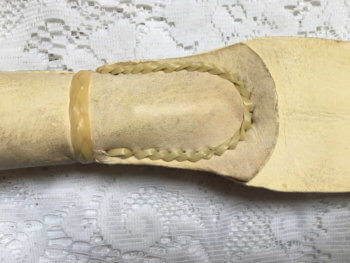
 White Rebenque 23" long, flap is 12", white leather with rawhide/sinew stitching and decorations, slight yellowing from age. Beautiful hand-made white leather rebenque 50+ years old. It has decorative rawhide work on the handle and on the strap, using two colors of rawhide. The handle is textured by wrapping a wet cord around it, leaving an imprint on the leather. Rebenque is the name in Brazilian Portuguese for a type of whip used by gauchos in South America. Especially in Argentina, it is the traditional riding, fighting, and punishing whip of the gaucho. It consists of a rawhide wrapped wooden handle with a thong made of a leather strap a little longer than the handle. The wide strap made the rebenque an instrument less severe on the horse than the European riding crop. As the gaucho was never far from the horse, the rebenque was always on him. When not in use, he made a knot with the strap and held the rebenque lazily by the wrist strap with the middle fingers of his hand, or hung it from the handle of his facón knife (as he used the large knife almost horizontally at his back, held by the belt or waistband, the handle protruded from his right side). The rebenque was used also for fighting, as a weapon by itself, when the fight did not merit a knife, or with the strap rolled on his left hand and the handle hanging, as a secondary weapon to the knife in his right hand. Of course, it was also used for domestic punishments, and for quasi-judicial chastisement. A couple of lashes with the rebenque on the bare legs were widely used as a punishment for children, even in the urban areas.
White Rebenque 23" long, flap is 12", white leather with rawhide/sinew stitching and decorations, slight yellowing from age. Beautiful hand-made white leather rebenque 50+ years old. It has decorative rawhide work on the handle and on the strap, using two colors of rawhide. The handle is textured by wrapping a wet cord around it, leaving an imprint on the leather. Rebenque is the name in Brazilian Portuguese for a type of whip used by gauchos in South America. Especially in Argentina, it is the traditional riding, fighting, and punishing whip of the gaucho. It consists of a rawhide wrapped wooden handle with a thong made of a leather strap a little longer than the handle. The wide strap made the rebenque an instrument less severe on the horse than the European riding crop. As the gaucho was never far from the horse, the rebenque was always on him. When not in use, he made a knot with the strap and held the rebenque lazily by the wrist strap with the middle fingers of his hand, or hung it from the handle of his facón knife (as he used the large knife almost horizontally at his back, held by the belt or waistband, the handle protruded from his right side). The rebenque was used also for fighting, as a weapon by itself, when the fight did not merit a knife, or with the strap rolled on his left hand and the handle hanging, as a secondary weapon to the knife in his right hand. Of course, it was also used for domestic punishments, and for quasi-judicial chastisement. A couple of lashes with the rebenque on the bare legs were widely used as a punishment for children, even in the urban areas. -
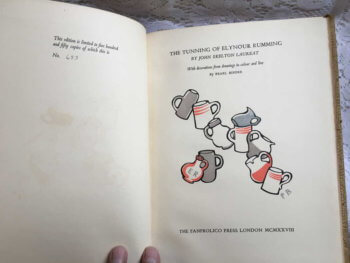
 The Tunning of Elynour Rumming, by John Skelton Laureat, "with decorations from the drawings in colour and line by Pearl Binder" (Fanfrolico Press, London, 1928, #433/550 hand written limitation) 7.75" x 11.25", 47pp, hardbound, coarse fiber on boards (burlap?), hand laid paper, artfully done, in good plus condition for age and for the unconventional binding materials The Tunning of Elynour Rummyng is a long raucous poem written by English poet John Skelton(1463-1529). The poem was first printed by Richard Lant sometime in 1550 and presents what many would consider disgusting images of rural drinking and drunkenness. For all its gritty description, Skelton has modeled the poem on Church liturgy of that time. The verse form itself closely resembles a liturgical chant. Elynour is a character in the poem who runs a "public house," or pub. Many pubs in England had the look of a home both inside and out. In the early 16th century, the male or female owner of the pub not only sold the ale, but also probably brewed it. Elynour easily acquires all her ingredients for quite acceptable ale from the local farmers in southern England where her pub was apparently located. Nevertheless, the kind of hard language which is found in the poem, is not uncommon as "bar talk." Today, much like in the 16th century, many brands of beer have been derisively referred to as "pig piss" perhaps because of beer's pale yellowish color and its bland and very slightly bitter taste. The poet says that chickens roost over Elynour's fermentation tank and drop their excrement into the froth. The yeast will sometimes form a white cap on the fermenting beer. Alcoholic beverages are also often associated with sex and indeed will sometimes reduce the inhibitions of men and women. However, Elynour advises her female customers that the ale will make them more desirable to their husbands, in part because she has the chicken excrement in the ale. Fanfrolico Press, Australia’s first ‘private press’ in the arts-and-craft tradition, was founded by Jack Lindsay, P. R. Stephensen and John Kirtley, originally in North Sydney in 1923. The press specialized in printings artful, limited editions of classics and forgotten works that were suited to the extravagant style of artist like his father, artist, sculptor and author Norman Lindsay who illustrated many of their books. Fanfrolico was scornful of modernism and with its florid style determinedly backward-looking. They did surprisingly well, despite the lack of business expertise of their young, ambitious "bohemian" owners, eking out a living despite the risky move to London in 1926 and upheavals in ownership that saw the departure in 1927 of Kirtley, and then Stephenson in 1929. Sometime in 1930 they published their last book.
The Tunning of Elynour Rumming, by John Skelton Laureat, "with decorations from the drawings in colour and line by Pearl Binder" (Fanfrolico Press, London, 1928, #433/550 hand written limitation) 7.75" x 11.25", 47pp, hardbound, coarse fiber on boards (burlap?), hand laid paper, artfully done, in good plus condition for age and for the unconventional binding materials The Tunning of Elynour Rummyng is a long raucous poem written by English poet John Skelton(1463-1529). The poem was first printed by Richard Lant sometime in 1550 and presents what many would consider disgusting images of rural drinking and drunkenness. For all its gritty description, Skelton has modeled the poem on Church liturgy of that time. The verse form itself closely resembles a liturgical chant. Elynour is a character in the poem who runs a "public house," or pub. Many pubs in England had the look of a home both inside and out. In the early 16th century, the male or female owner of the pub not only sold the ale, but also probably brewed it. Elynour easily acquires all her ingredients for quite acceptable ale from the local farmers in southern England where her pub was apparently located. Nevertheless, the kind of hard language which is found in the poem, is not uncommon as "bar talk." Today, much like in the 16th century, many brands of beer have been derisively referred to as "pig piss" perhaps because of beer's pale yellowish color and its bland and very slightly bitter taste. The poet says that chickens roost over Elynour's fermentation tank and drop their excrement into the froth. The yeast will sometimes form a white cap on the fermenting beer. Alcoholic beverages are also often associated with sex and indeed will sometimes reduce the inhibitions of men and women. However, Elynour advises her female customers that the ale will make them more desirable to their husbands, in part because she has the chicken excrement in the ale. Fanfrolico Press, Australia’s first ‘private press’ in the arts-and-craft tradition, was founded by Jack Lindsay, P. R. Stephensen and John Kirtley, originally in North Sydney in 1923. The press specialized in printings artful, limited editions of classics and forgotten works that were suited to the extravagant style of artist like his father, artist, sculptor and author Norman Lindsay who illustrated many of their books. Fanfrolico was scornful of modernism and with its florid style determinedly backward-looking. They did surprisingly well, despite the lack of business expertise of their young, ambitious "bohemian" owners, eking out a living despite the risky move to London in 1926 and upheavals in ownership that saw the departure in 1927 of Kirtley, and then Stephenson in 1929. Sometime in 1930 they published their last book. -
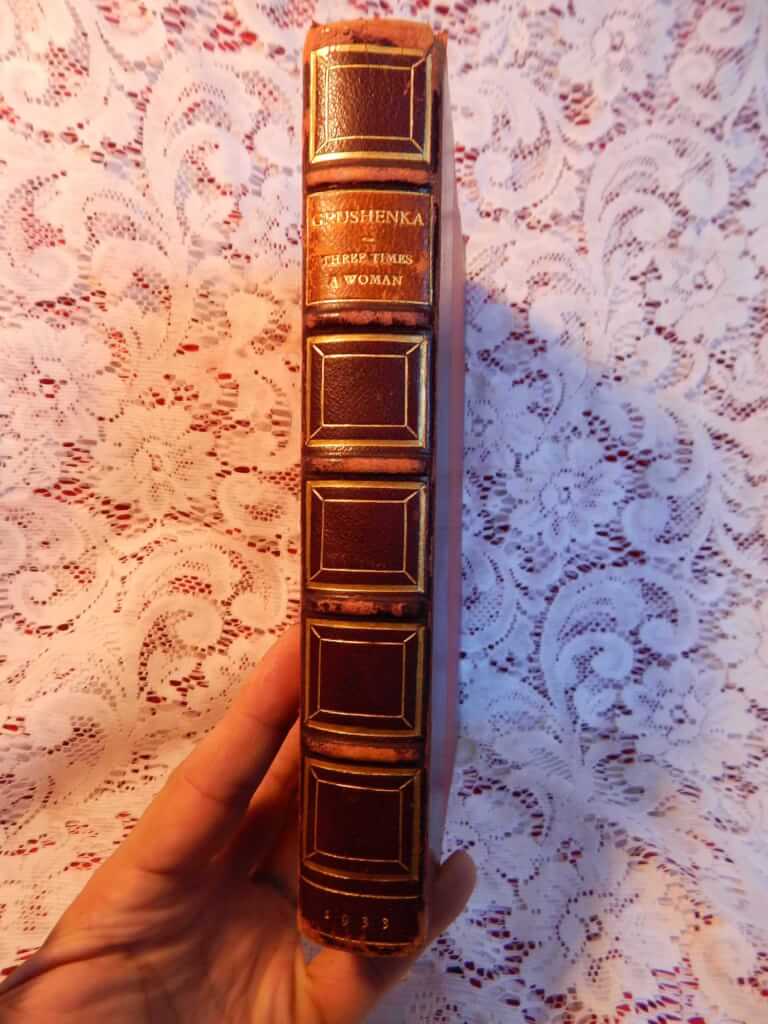
 Three Times a Woman, Grushenka, anonymous [possibly Val Lewton?], illus. "a young Russian residing in Paris, who unfortunately must remain anonymous" (Privately Printed, Paris [New York], 1933) 7.25"x9", 252pp, the original "french wraps" bound into hardcover, half red morocco over red boards, gilt titles and decorations on spine, 5 raised bands, gilt boarders on leather covers, top edge gilt, other edges deckled, frontispiece in color (rare), other illustrations not present, binding split at 18/19 to 30/31pp otherwise good condition, rubbing and bumping to boards Title page reads: "The Story of a Russian Serf Girl Compiled from Contemporary Documents in the Russian Police Files and Private Archives of Russian Libraries" Originally published at New York in 1933 with a false Paris imprint. Val Lewton, the supposed author, was a well known film producer, responsible for a series of good low-budget horror movies in the 1940's by such directors as Robert Wise, Mark Robson and Jacques Tourneur. The book purports to be a flaggelation story written by a Russian living in Paris and then translated to english. The story takes place c. 1728, "shortly after the death of Peter the Great". The main character is Grushenka Pavlovsk.
Three Times a Woman, Grushenka, anonymous [possibly Val Lewton?], illus. "a young Russian residing in Paris, who unfortunately must remain anonymous" (Privately Printed, Paris [New York], 1933) 7.25"x9", 252pp, the original "french wraps" bound into hardcover, half red morocco over red boards, gilt titles and decorations on spine, 5 raised bands, gilt boarders on leather covers, top edge gilt, other edges deckled, frontispiece in color (rare), other illustrations not present, binding split at 18/19 to 30/31pp otherwise good condition, rubbing and bumping to boards Title page reads: "The Story of a Russian Serf Girl Compiled from Contemporary Documents in the Russian Police Files and Private Archives of Russian Libraries" Originally published at New York in 1933 with a false Paris imprint. Val Lewton, the supposed author, was a well known film producer, responsible for a series of good low-budget horror movies in the 1940's by such directors as Robert Wise, Mark Robson and Jacques Tourneur. The book purports to be a flaggelation story written by a Russian living in Paris and then translated to english. The story takes place c. 1728, "shortly after the death of Peter the Great". The main character is Grushenka Pavlovsk. -

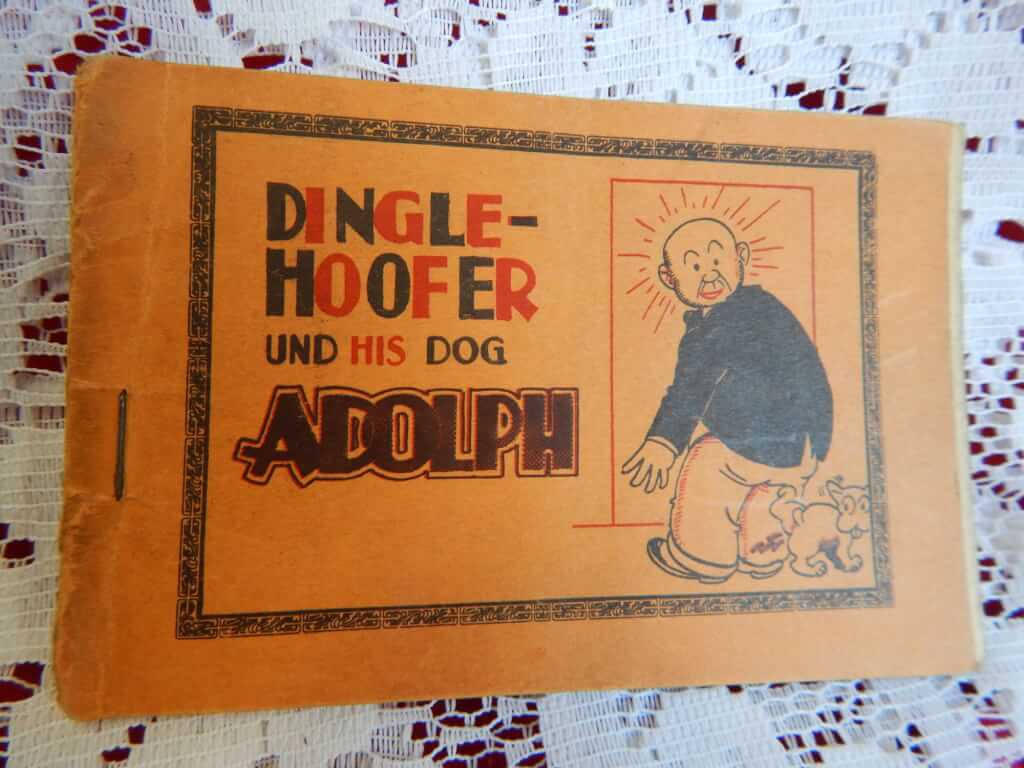 Dingle-Hoofer und his dog Adolph, (np. nd.) 4.5" x 3", 8pp. pamphlet, stapled Tijuana bibles (also known as eight-pagers, bluesies, gray-backs, Jiggs-and-Maggie books, jo-jo books, Tillie-and-Mac books, and two-by-fours) were little pornographic comic books produced in the United States from the 1920s to the early 1960s.
Dingle-Hoofer und his dog Adolph, (np. nd.) 4.5" x 3", 8pp. pamphlet, stapled Tijuana bibles (also known as eight-pagers, bluesies, gray-backs, Jiggs-and-Maggie books, jo-jo books, Tillie-and-Mac books, and two-by-fours) were little pornographic comic books produced in the United States from the 1920s to the early 1960s. -
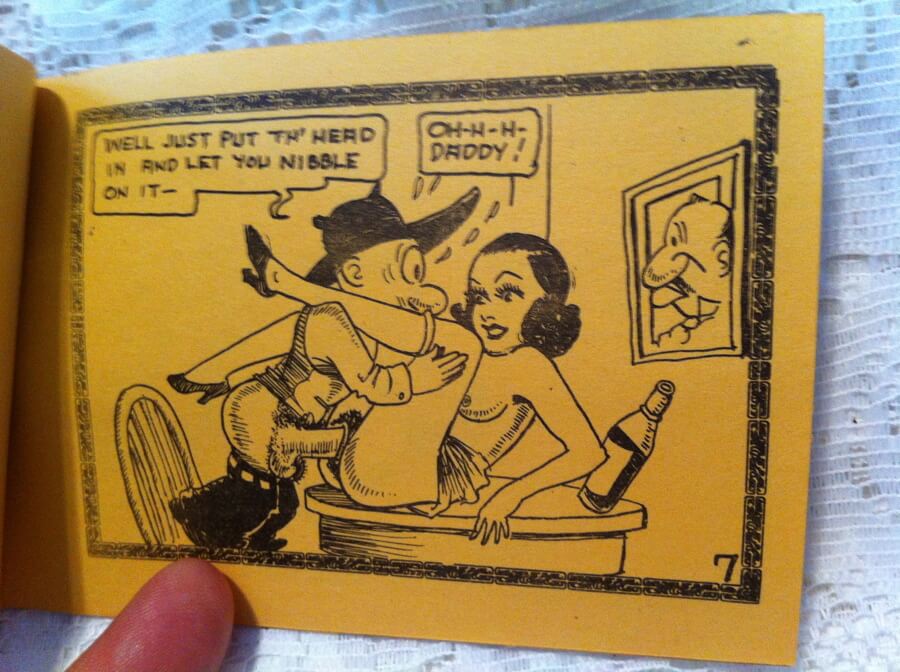
 The Great Big Man from South, Staring Barney Google, (n.p. n.d.) 4.5" x 3", 8pp. pamphlet, stapled Tijuana bibles (also known as eight-pagers, bluesies, gray-backs, Jiggs-and-Maggie books, jo-jo books, Tillie-and-Mac books, and two-by-fours) were little pornographic comic books produced in the United States from the 1920s to the early 1960s. This parodies "Barney Google and Snuffy Smith" an widely read (even today) comic strip that has been around since 1919. This booklet features an unrelated erotic illustration on the back.
The Great Big Man from South, Staring Barney Google, (n.p. n.d.) 4.5" x 3", 8pp. pamphlet, stapled Tijuana bibles (also known as eight-pagers, bluesies, gray-backs, Jiggs-and-Maggie books, jo-jo books, Tillie-and-Mac books, and two-by-fours) were little pornographic comic books produced in the United States from the 1920s to the early 1960s. This parodies "Barney Google and Snuffy Smith" an widely read (even today) comic strip that has been around since 1919. This booklet features an unrelated erotic illustration on the back. -

 Schnozzle, (n.p. n.d.) 4.5" x 3", 8pp. pamphlet, stapled Tijuana bibles (also known as eight-pagers, bluesies, gray-backs, Jiggs-and-Maggie books, jo-jo books, Tillie-and-Mac books, and two-by-fours) were little pornographic comic books produced in the United States from the 1920s to the early 1960s. Their popularity peaked during the Great Depression era. This book parodies Jimmy Durante.
Schnozzle, (n.p. n.d.) 4.5" x 3", 8pp. pamphlet, stapled Tijuana bibles (also known as eight-pagers, bluesies, gray-backs, Jiggs-and-Maggie books, jo-jo books, Tillie-and-Mac books, and two-by-fours) were little pornographic comic books produced in the United States from the 1920s to the early 1960s. Their popularity peaked during the Great Depression era. This book parodies Jimmy Durante. -
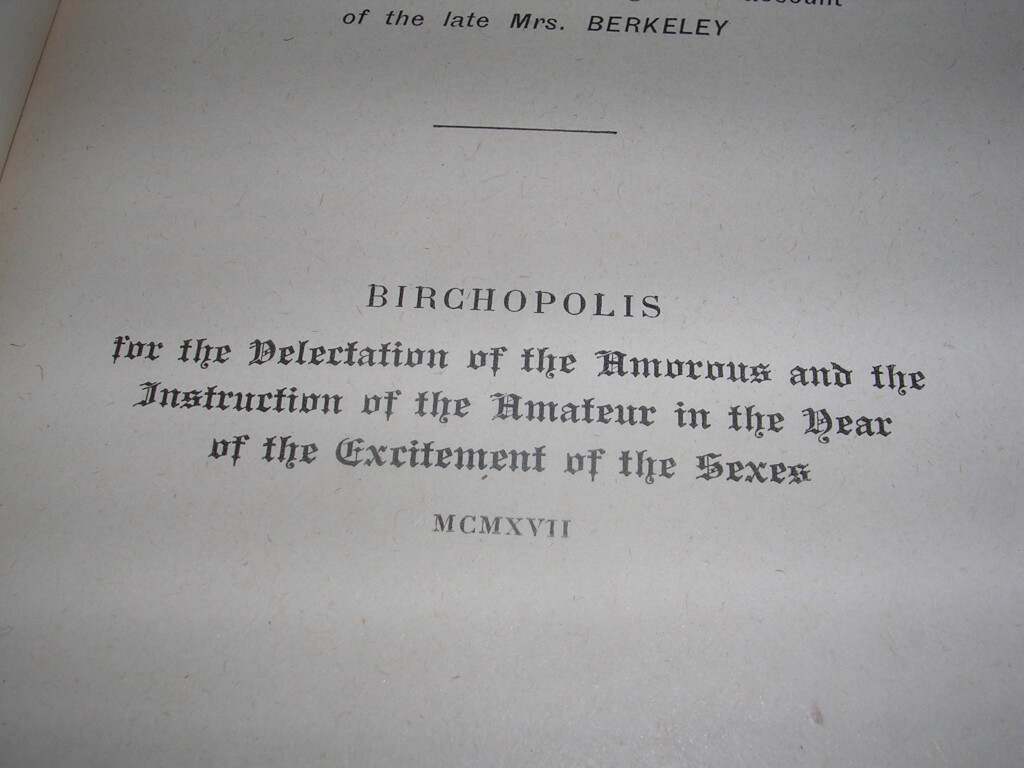
 Venus School-Mistress, or Birchen Sports, anonymous, Preface by Mary Wilson (Birchopolis for the Delectation of the Amorous and the Instruction of the Amateur in the Year of the Excitement of the Sexes. 1917 [this is most-likely a newly rebound facsimile reprint of said edition, np nd]) 6 3/4" X 4 5/8", 167pp, hardbound no DJ, half-leather, very good condition, owner's signature in blue ink. According to Ashbee, this work probably dates to 1808-10 (by R. Birch, Translator of Manon's Memoirs, printed for Philosemus). It also appears in 1820 and then in 1830, published by George Cannon. This seems to be a reprint of a 1927 version. This edition reads "best and only complete edition" and "Reprinted from the edition of 1788 with a Preface by Mary Wilson, containing some account of the late Mrs. Berkeley". Also contained in this edition are The Charm, The Night School, The Beautiful Jewess, The Butcher's Daughter, Moral Reflections, The Questions for Casuists, Betsy Thoughtless and an extensive appendix with many articles about flagellation.
Venus School-Mistress, or Birchen Sports, anonymous, Preface by Mary Wilson (Birchopolis for the Delectation of the Amorous and the Instruction of the Amateur in the Year of the Excitement of the Sexes. 1917 [this is most-likely a newly rebound facsimile reprint of said edition, np nd]) 6 3/4" X 4 5/8", 167pp, hardbound no DJ, half-leather, very good condition, owner's signature in blue ink. According to Ashbee, this work probably dates to 1808-10 (by R. Birch, Translator of Manon's Memoirs, printed for Philosemus). It also appears in 1820 and then in 1830, published by George Cannon. This seems to be a reprint of a 1927 version. This edition reads "best and only complete edition" and "Reprinted from the edition of 1788 with a Preface by Mary Wilson, containing some account of the late Mrs. Berkeley". Also contained in this edition are The Charm, The Night School, The Beautiful Jewess, The Butcher's Daughter, Moral Reflections, The Questions for Casuists, Betsy Thoughtless and an extensive appendix with many articles about flagellation. -

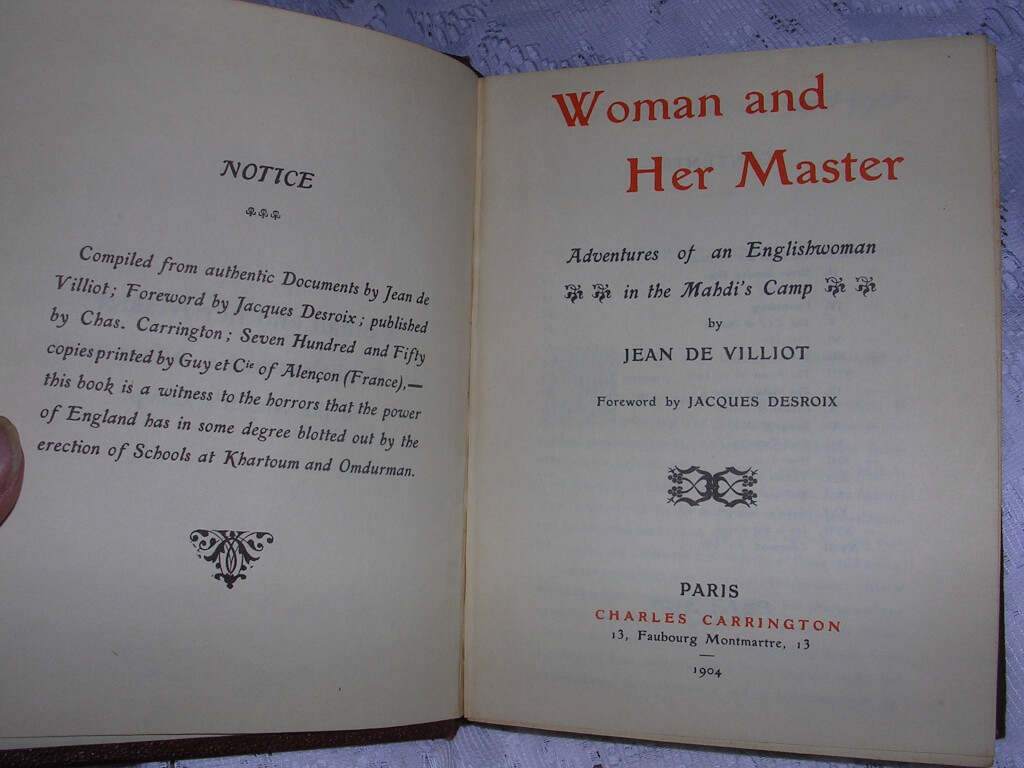 Woman and her Master; an Englishwoman's Adventures in the Madhi's Camp, Jean de Villiot [George Grassal (Hugues Rebell)] (Charles Carrington, Paris, 1904 [printed "Alençon, Imprimerie Veuve Félix Guy et Cie"] stated limited edition 750 copies) 6 3/8" X 5", 301pp, hardbound, red pebbled cloth boards, gilt title on front, no writing on spine, sewn signatures, good condition, some minor bumping and rubbing Jean de Villiot was a pseudonym used by several authors and compilers working for the publisher Charles Carrington writing novels and "studies" concerning flagellation, including Hugues Rebell (Georges Grassal), Hector France, Stéphane Arnoulin and Charles Carrington, himself. This novel is attributed to George Grassal (Hugues Rebell) originally written in French, in 1902, as "La Femme et son maître" (The Woman and her Master). In 1904 "Woman and her Master" was published in English by Charles Carrington. Often these editions were printed unbound and sent to the bookseller to bind to the specifications of their customers. "this book is a witness to the horrors that the power of England has in some degree blotted out by the erection of Schools at Khartoum and Omdurman."
Woman and her Master; an Englishwoman's Adventures in the Madhi's Camp, Jean de Villiot [George Grassal (Hugues Rebell)] (Charles Carrington, Paris, 1904 [printed "Alençon, Imprimerie Veuve Félix Guy et Cie"] stated limited edition 750 copies) 6 3/8" X 5", 301pp, hardbound, red pebbled cloth boards, gilt title on front, no writing on spine, sewn signatures, good condition, some minor bumping and rubbing Jean de Villiot was a pseudonym used by several authors and compilers working for the publisher Charles Carrington writing novels and "studies" concerning flagellation, including Hugues Rebell (Georges Grassal), Hector France, Stéphane Arnoulin and Charles Carrington, himself. This novel is attributed to George Grassal (Hugues Rebell) originally written in French, in 1902, as "La Femme et son maître" (The Woman and her Master). In 1904 "Woman and her Master" was published in English by Charles Carrington. Often these editions were printed unbound and sent to the bookseller to bind to the specifications of their customers. "this book is a witness to the horrors that the power of England has in some degree blotted out by the erection of Schools at Khartoum and Omdurman." -
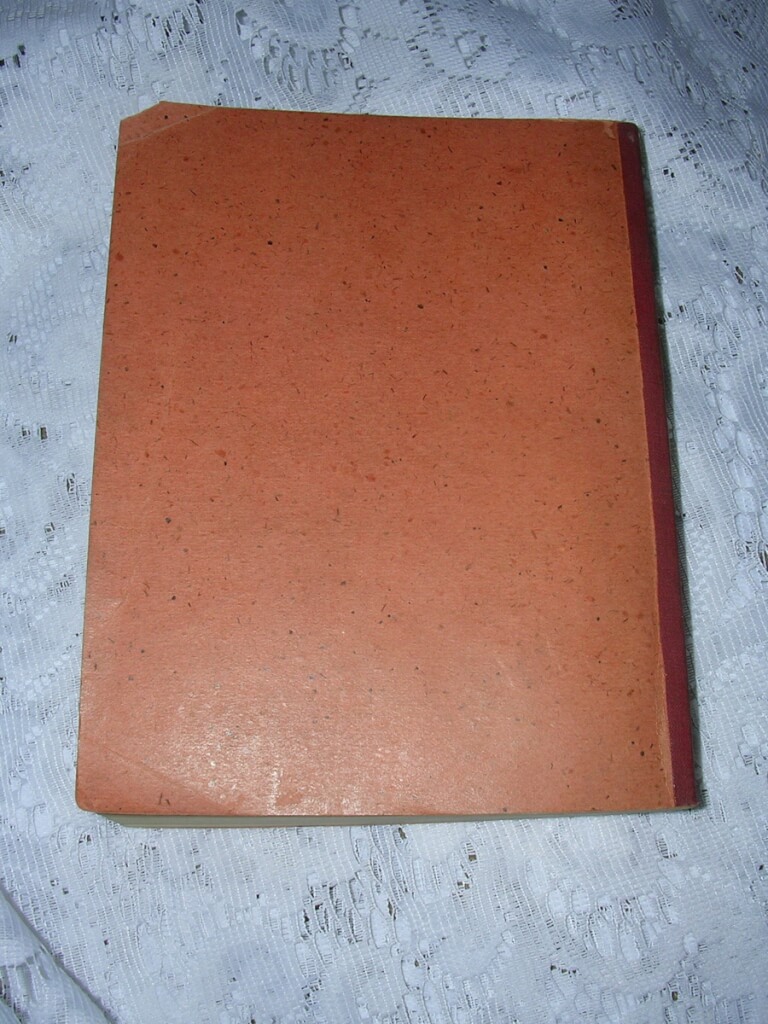
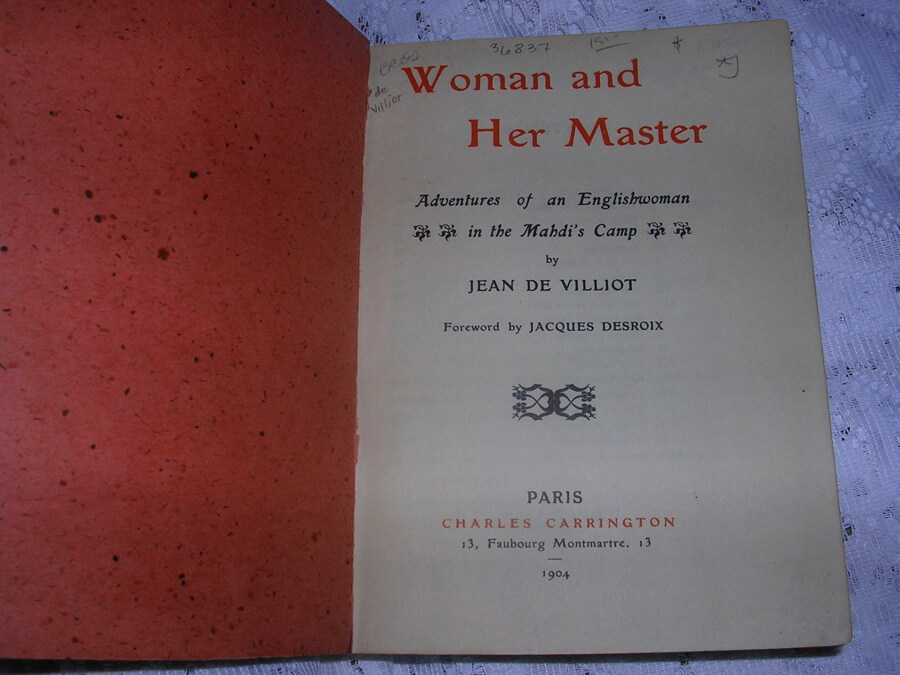 Jean de Villiot [George Grassal (Hugues Rebell)] (Charles Carrington, Paris, 1904 [printed "Alençon, Imprimerie Veuve Félix Guy et Cie"]) 6 3/8" X 5", 301pp, soft bound, red cloth spine with titling to paper label, orange paper covers, good condition, crease in lower corner of cover and inch tear along gutter's edge, slightly yellow pages
Jean de Villiot [George Grassal (Hugues Rebell)] (Charles Carrington, Paris, 1904 [printed "Alençon, Imprimerie Veuve Félix Guy et Cie"]) 6 3/8" X 5", 301pp, soft bound, red cloth spine with titling to paper label, orange paper covers, good condition, crease in lower corner of cover and inch tear along gutter's edge, slightly yellow pages -

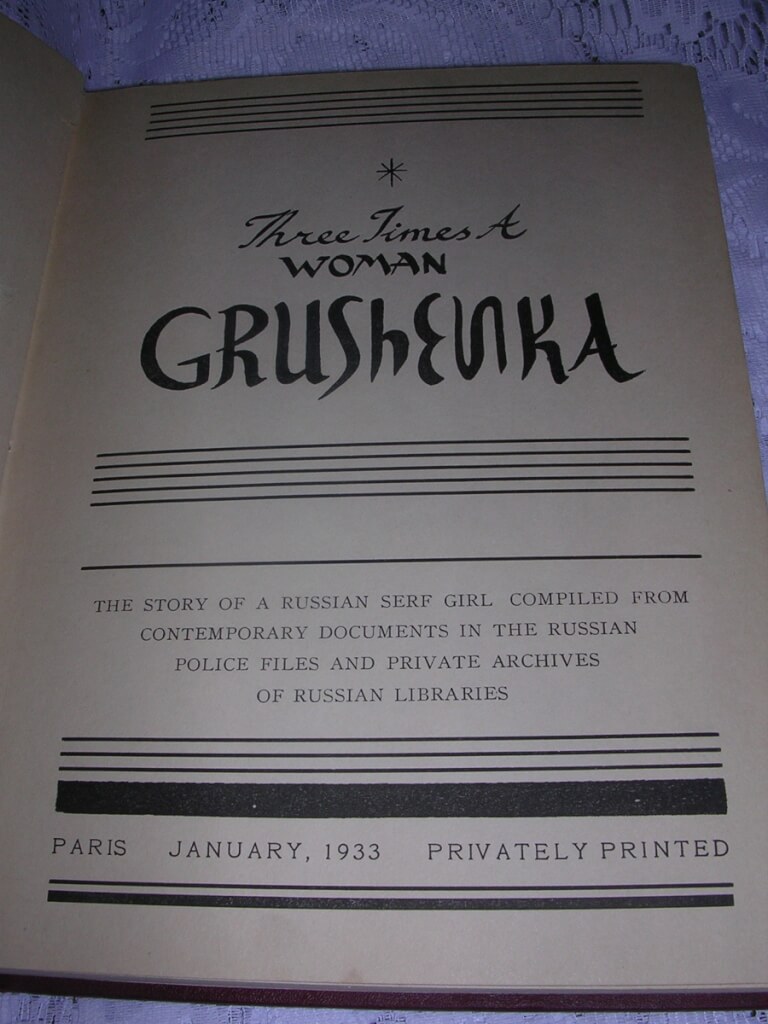 Three Times a Woman, Grushenka, anonymous [possibly Val Lewton?], illus. "a young Russain residing in Paris, who unfortunately must remain annonymous" (Privately Printed, London [New York], 1933 [probably a reprint as it does not have illustrations of the original]) 9 7/8" X 6 7/8", 252pp, hardbound no DJ, red boards with gilt title on spine, good condition, minor wear and bumps to cover, binding tight, bookplate of Erwin A. Weiss, D.D.S. Title page reads: "The Story of a Russian Serf Girl Compiled from Contemporary Documents in the Russian Police Files and Private Archives of Russian Libraries" Originally published at New York in 1933 with a false Paris imprint. Val Lewton, the supposed author, was a well known film producer, responsible for a series of good low-budget horror movies in the 1940's by such directors as Robert Wise, Mark Robson and Jacques Tourneur. The book purports to be a flaggelation story written by a Russian living in Paris and then translated to english. The story takes place c. 1728, "shortly after the death of Peter the Great". The main character is Grushenka Pavlovsk.
Three Times a Woman, Grushenka, anonymous [possibly Val Lewton?], illus. "a young Russain residing in Paris, who unfortunately must remain annonymous" (Privately Printed, London [New York], 1933 [probably a reprint as it does not have illustrations of the original]) 9 7/8" X 6 7/8", 252pp, hardbound no DJ, red boards with gilt title on spine, good condition, minor wear and bumps to cover, binding tight, bookplate of Erwin A. Weiss, D.D.S. Title page reads: "The Story of a Russian Serf Girl Compiled from Contemporary Documents in the Russian Police Files and Private Archives of Russian Libraries" Originally published at New York in 1933 with a false Paris imprint. Val Lewton, the supposed author, was a well known film producer, responsible for a series of good low-budget horror movies in the 1940's by such directors as Robert Wise, Mark Robson and Jacques Tourneur. The book purports to be a flaggelation story written by a Russian living in Paris and then translated to english. The story takes place c. 1728, "shortly after the death of Peter the Great". The main character is Grushenka Pavlovsk. -
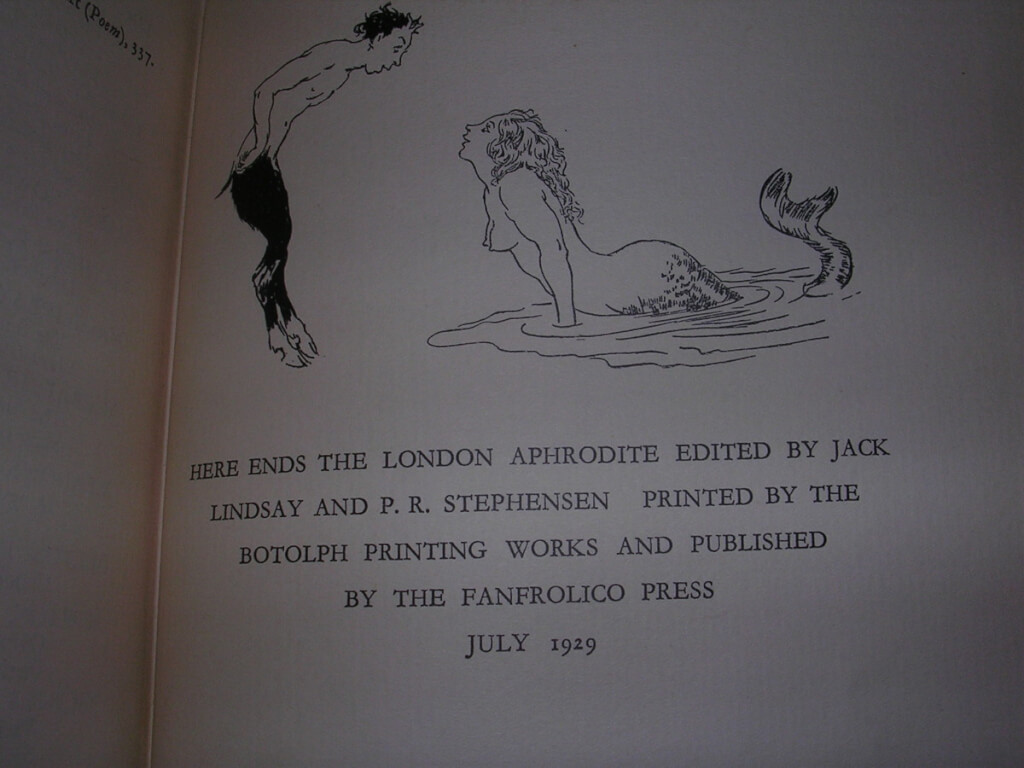
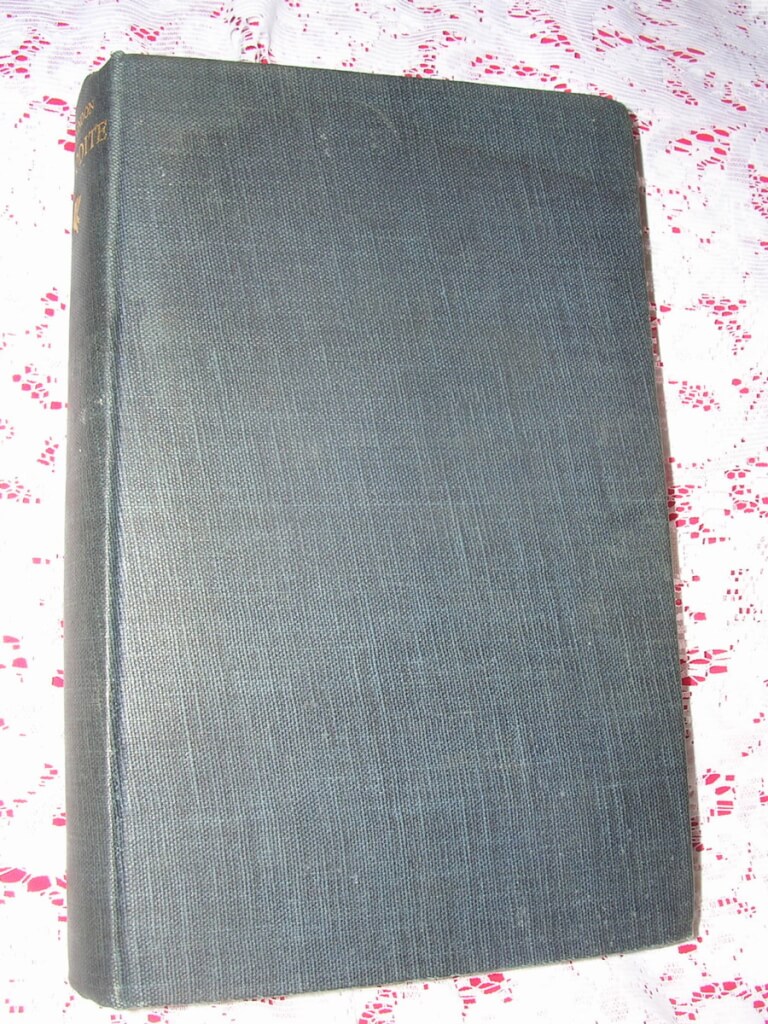 The London Aphrodite, ed. Jack Lindsay and P.R. Stephensen (Fanfrolico Press, "printed by the Botolph Printing Works", London, 1929) 9.75" X 6.24", 496pp plus index. hardcover no DJ, blue cloth boards, gilt title on spine, top edge gilt. Excellent condition. A periodical edited by Jack Lindsay and P.R. Stephensen and published in London by the Fanfrolico Press, ran for a planned six issues 1928-29. Self-described as "A Miscellany of Poems Stories and Essays by Various Hands Eminent or Rebellious." Named as a rebuttal of the conservatism of J.C. Squire's London Mercury, it was committed to the same aesthetic attitudes as Vision. Some prominent English authors, including Aldous Huxley, contributed, although the majority were Australian. Jack Lindsay, the dominant force, used the pseudonym 'Peter Meadows' for several articles. Other Australian contributors were Norman Lindsay, Hugh McCrae, Kenneth Slessor, Philip Lindsay, Brian Penton, P.R. Stephensen, Les Robinson, W.J. Turner, Bertram Higgins, E.J. Rupert Atkinson and Edith Hepburn ('Anna Wickham'). This is a compilation of those issues in book form, published by Fanfrolico Press.
The London Aphrodite, ed. Jack Lindsay and P.R. Stephensen (Fanfrolico Press, "printed by the Botolph Printing Works", London, 1929) 9.75" X 6.24", 496pp plus index. hardcover no DJ, blue cloth boards, gilt title on spine, top edge gilt. Excellent condition. A periodical edited by Jack Lindsay and P.R. Stephensen and published in London by the Fanfrolico Press, ran for a planned six issues 1928-29. Self-described as "A Miscellany of Poems Stories and Essays by Various Hands Eminent or Rebellious." Named as a rebuttal of the conservatism of J.C. Squire's London Mercury, it was committed to the same aesthetic attitudes as Vision. Some prominent English authors, including Aldous Huxley, contributed, although the majority were Australian. Jack Lindsay, the dominant force, used the pseudonym 'Peter Meadows' for several articles. Other Australian contributors were Norman Lindsay, Hugh McCrae, Kenneth Slessor, Philip Lindsay, Brian Penton, P.R. Stephensen, Les Robinson, W.J. Turner, Bertram Higgins, E.J. Rupert Atkinson and Edith Hepburn ('Anna Wickham'). This is a compilation of those issues in book form, published by Fanfrolico Press. -
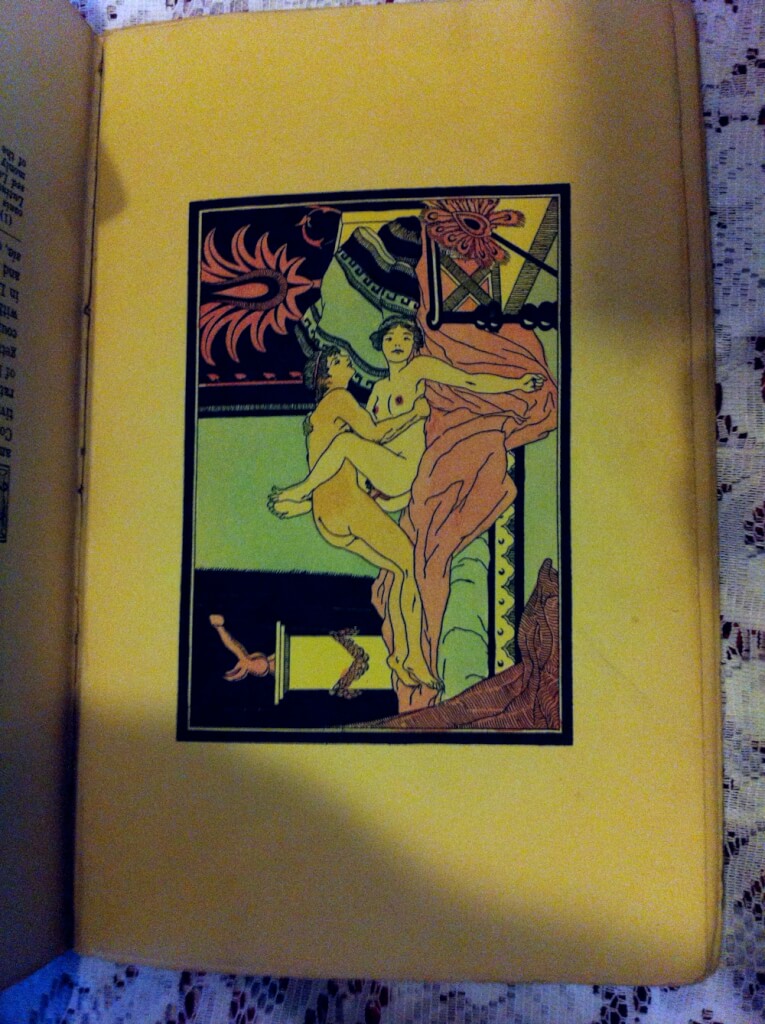
 the Dialogues of Luisa Sigea, Nicolas Chorier (Isadore Liseux, Paris 1890 [most likely an American pirated copy from the 1920-30's] illustrator unknown) 8.75" X 6", xx 296pp., bound in thin green boards and green tape on spine. Fair condition, binding is loose in places, part of first signature taped in place, rips in spine. Explicit color illustrations. Bookplate of Theodor Reich. In six dialogues, Tullia, who is 26, initiates her 15 year old cousin, Ottavia, in the art of sexual pleasure. The first four dialogues, which are fairly short, focus on tribadism and defloration. The longer fifth and six dialogues introduce flagellation, contractual submission, group sex, and anal sex. (I. The skirmish; II. Tribadicon; III. Fabric; IV. The duel; V. Pleasures; VI. Frolics and sports) Like many sexual fictions, The Dialogues of Luisa Sigea attempts to conceal the identity of its author: it purports to be based on a Latin manuscript translation of a work written originally in Spanish in the sixteenth-century by an erudite young woman, Luisa Sigea of Toledo and translated into latin by Jean Meursius of Holland. In fact, it was written c. 1660, in latin, by a Frenchman, Nicolas Chorier (1612-1692), a lawyer who wrote works on various historical and philosophical subjects. The first French translation, L\'Academie des dames, was issued in the 1680. It was first translated into English by Isidore Liseux and issued as a 3 volume set. (1. I-IV, 2. V, 3. VI). This book contains all 6 of the dialogues and some very pornographic colored illustrations.
the Dialogues of Luisa Sigea, Nicolas Chorier (Isadore Liseux, Paris 1890 [most likely an American pirated copy from the 1920-30's] illustrator unknown) 8.75" X 6", xx 296pp., bound in thin green boards and green tape on spine. Fair condition, binding is loose in places, part of first signature taped in place, rips in spine. Explicit color illustrations. Bookplate of Theodor Reich. In six dialogues, Tullia, who is 26, initiates her 15 year old cousin, Ottavia, in the art of sexual pleasure. The first four dialogues, which are fairly short, focus on tribadism and defloration. The longer fifth and six dialogues introduce flagellation, contractual submission, group sex, and anal sex. (I. The skirmish; II. Tribadicon; III. Fabric; IV. The duel; V. Pleasures; VI. Frolics and sports) Like many sexual fictions, The Dialogues of Luisa Sigea attempts to conceal the identity of its author: it purports to be based on a Latin manuscript translation of a work written originally in Spanish in the sixteenth-century by an erudite young woman, Luisa Sigea of Toledo and translated into latin by Jean Meursius of Holland. In fact, it was written c. 1660, in latin, by a Frenchman, Nicolas Chorier (1612-1692), a lawyer who wrote works on various historical and philosophical subjects. The first French translation, L\'Academie des dames, was issued in the 1680. It was first translated into English by Isidore Liseux and issued as a 3 volume set. (1. I-IV, 2. V, 3. VI). This book contains all 6 of the dialogues and some very pornographic colored illustrations. -

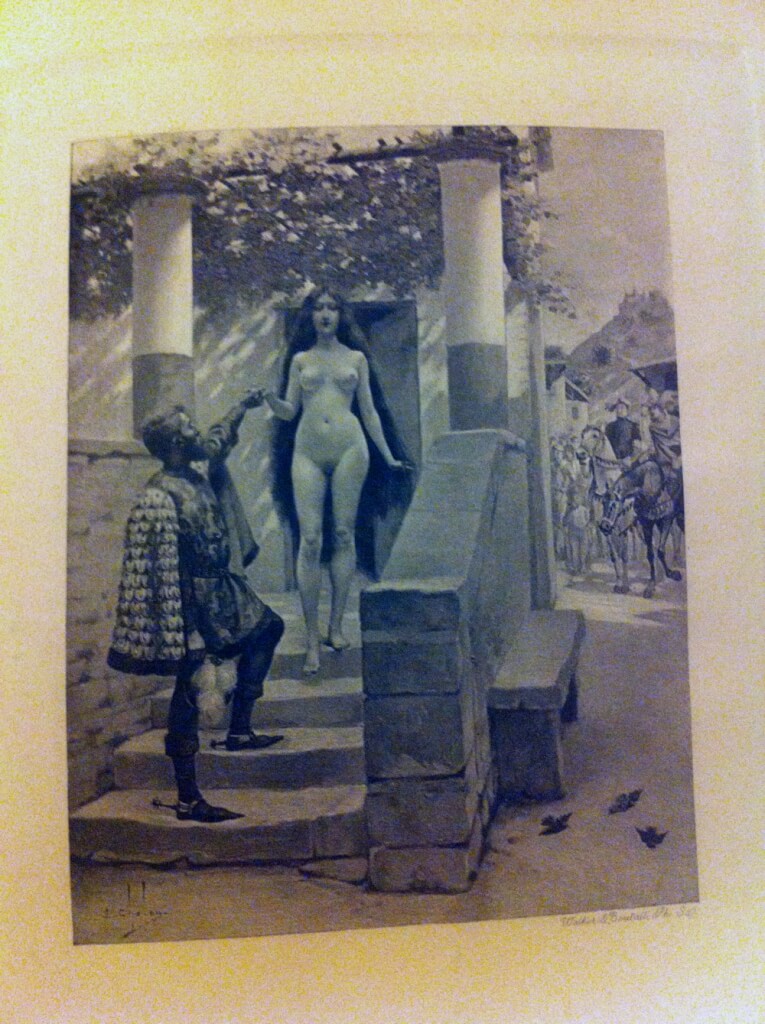 The Decameron of Giovanni Boccaccio, Giovanni Boccaccio, trans. John Payne, illust. Louis Chalon (Lawrence and Bullen, London, 1893, #638/1000) 11.25" X 7.5", 325pp 383pp, hardcover, olive green silk decorated boards with gilt decorations on cover and titles on spine. Numerous full-page B&W Illustrations, Good condition for age, some bumping to corners and slight wear, ribbons present but unattached. This is a beautifully bound and nicely illustrated edition of The Decameron from the late 1800s. The Decameron, (subtitled Prencipe Galeotto or Prince Galehaut), is a collection of novellas by the 14th-century Italian author Giovanni Boccaccio (1313–1375). The book is structured as a frame story containing 100 tales told by a group of seven young women and three young men sheltering in a secluded villa just outside Florence to escape the Black Death, which was afflicting the city. To make their exile more pleasant each of the ten tells the others one story every day. The Decameron records the narratives of ten days -- 100 stories. Boccaccio probably conceived of The Decameron after the epidemic of 1348, and completed it by 1353. These tales run the entire range of human emotion: grief, love, humor, anger, revenge. Many are based on oral folklore. Boccaccio's ten narrators thus retell already familiar stories about errant priests, rascally husbands, and mischievous wives. Variants of these stories are known in many cultures, but no one formulates them more cleverly or relates them more eloquently than does Boccaccio. In addition to its literary value and widespread influence, it provides a document of life at the time. Written in the vernacular of the Florentine language, it is considered a masterpiece of classical early Italian prose. Arthur Henry Bullen, often known as A. H. Bullen, (1857-1920) was an English editor and publisher, and a specialist in 16th and 17th century literature. His father George Bullen was librarian at the British Museum. A. H. Bullen's interest in Elizabethan dramatists and poets started at the City of London School, before he went to Worcester College, Oxford to study classics. His publishing career began with a scholarly edition of the Works of John Day in 1881 and continued with series of English Dramatists and a seven-volume set of Old English Plays, some of which he had discovered in manuscript and published for the first time. He was also the first person to publish some early lyric poems. Bullen wrote more than 150 articles for the Dictionary of National Biography, lectured on Elizabethan dramatists at Oxford University and taught at Toynbee Hall. In 1891 he and H. W. Lawrence went into partnership as the publishers Lawrence & Bullen. This lasted until 1900 when Bullen moved on to publish as A. H. Bullen. With Frank Sidgwick as partner, he then formed the Shakespeare Head Press for which he is most known.
The Decameron of Giovanni Boccaccio, Giovanni Boccaccio, trans. John Payne, illust. Louis Chalon (Lawrence and Bullen, London, 1893, #638/1000) 11.25" X 7.5", 325pp 383pp, hardcover, olive green silk decorated boards with gilt decorations on cover and titles on spine. Numerous full-page B&W Illustrations, Good condition for age, some bumping to corners and slight wear, ribbons present but unattached. This is a beautifully bound and nicely illustrated edition of The Decameron from the late 1800s. The Decameron, (subtitled Prencipe Galeotto or Prince Galehaut), is a collection of novellas by the 14th-century Italian author Giovanni Boccaccio (1313–1375). The book is structured as a frame story containing 100 tales told by a group of seven young women and three young men sheltering in a secluded villa just outside Florence to escape the Black Death, which was afflicting the city. To make their exile more pleasant each of the ten tells the others one story every day. The Decameron records the narratives of ten days -- 100 stories. Boccaccio probably conceived of The Decameron after the epidemic of 1348, and completed it by 1353. These tales run the entire range of human emotion: grief, love, humor, anger, revenge. Many are based on oral folklore. Boccaccio's ten narrators thus retell already familiar stories about errant priests, rascally husbands, and mischievous wives. Variants of these stories are known in many cultures, but no one formulates them more cleverly or relates them more eloquently than does Boccaccio. In addition to its literary value and widespread influence, it provides a document of life at the time. Written in the vernacular of the Florentine language, it is considered a masterpiece of classical early Italian prose. Arthur Henry Bullen, often known as A. H. Bullen, (1857-1920) was an English editor and publisher, and a specialist in 16th and 17th century literature. His father George Bullen was librarian at the British Museum. A. H. Bullen's interest in Elizabethan dramatists and poets started at the City of London School, before he went to Worcester College, Oxford to study classics. His publishing career began with a scholarly edition of the Works of John Day in 1881 and continued with series of English Dramatists and a seven-volume set of Old English Plays, some of which he had discovered in manuscript and published for the first time. He was also the first person to publish some early lyric poems. Bullen wrote more than 150 articles for the Dictionary of National Biography, lectured on Elizabethan dramatists at Oxford University and taught at Toynbee Hall. In 1891 he and H. W. Lawrence went into partnership as the publishers Lawrence & Bullen. This lasted until 1900 when Bullen moved on to publish as A. H. Bullen. With Frank Sidgwick as partner, he then formed the Shakespeare Head Press for which he is most known. -

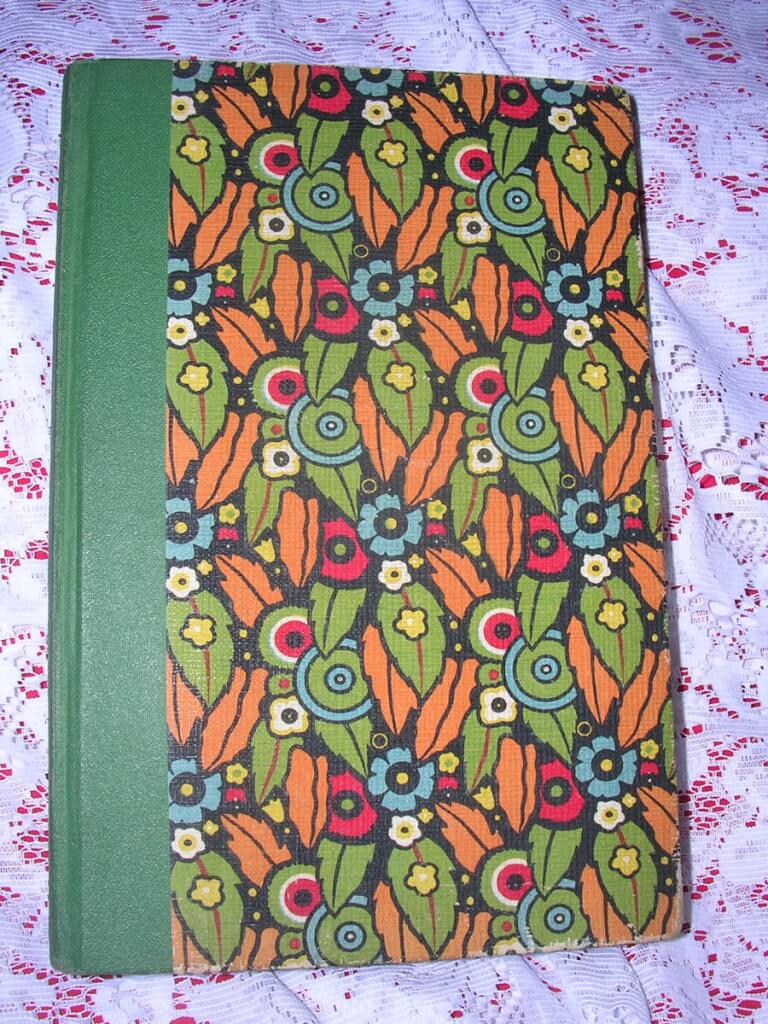 The Scented Garden: Anthropology of the Sex Life in the Levant , Bernhard Stern M.D., trans. David Berger M.A. (American Ethnological Press, New York, 1934, Printed for Subscribers, limited edition #387/600) 9 1/4" X 6 1/4", 443pp, hardbound half green cloth with floral boards, illustrated, top edge inked blue, good condition, corners worn, binding is tight Dr. Bernhard Stern spent 5 years in the Orient gathering data for this book. Conferring with famous oriental physicians, priests and students of folk-lore in the Turkish capital, and then on numerous distant journeys into the interior of the European and Asiatic Orient, all reports bearing on the contents of this book which were in any manner obtainable. This encyclopedic book details the sexual practices and perversions of peoples and cultures throughout the world. Topics include: love and love charms, rental marriages, the bridal night of a princess, the sexual lexicon, chastity and the feeling of shame, onanism and artificial instruments, public prostitution and the sex act.
The Scented Garden: Anthropology of the Sex Life in the Levant , Bernhard Stern M.D., trans. David Berger M.A. (American Ethnological Press, New York, 1934, Printed for Subscribers, limited edition #387/600) 9 1/4" X 6 1/4", 443pp, hardbound half green cloth with floral boards, illustrated, top edge inked blue, good condition, corners worn, binding is tight Dr. Bernhard Stern spent 5 years in the Orient gathering data for this book. Conferring with famous oriental physicians, priests and students of folk-lore in the Turkish capital, and then on numerous distant journeys into the interior of the European and Asiatic Orient, all reports bearing on the contents of this book which were in any manner obtainable. This encyclopedic book details the sexual practices and perversions of peoples and cultures throughout the world. Topics include: love and love charms, rental marriages, the bridal night of a princess, the sexual lexicon, chastity and the feeling of shame, onanism and artificial instruments, public prostitution and the sex act. -
 The Tales and Novels of Jean de La Fontaine | completely translated into English (Privately Printed, New York, 1929) 9.5"X6.25", xiii+250pp, x+329pp, hardbound with black boards and gilt titles on cover and spines, spine titles fading, top edge inked other edges deckled, good condition, illustrations throughout. Jean de La Fontaine (1621-1695) was a French fabulist and one of the most widely read French poets of the 17th century. After a long period of royal suspicion, he was admitted to the French Academy and his reputation in France has never faded since. Evidence of this is found in the many pictures and statues of the writer, as well as later depictions on medals, coins and postage stamps. The numerous works of La Fontaine fall into three traditional divisions: the Fables, the Tales and the miscellaneous (including dramatic) works. He is best known for the first of these, in which a tradition of fable collecting in French verse reaching back to the Middle Ages was brought to a peak. He published 245 fables, across twelve books between 1668 and 1694, exemplify the grace and wit of his age. Unlike many of his models, his fables function less as didactic tools and more as entertaining art. His beasts, humans, and plants are not merely moral-serving abstractions but rather lively actors in elegantly described escapades. Almost equally as popular in their time, his “tales”, Contes et nouvelles en vers (1665), is an anthology of various ribald short stories and novellas collected and versified from prose. They were particularly marked by their archly licentious tone. La Fontaine drew from several French and Italian works of the 15th and 16th centuries, among them The Decameron of Giovanni Boccaccio, Ludovico Ariosto’s Orlando Furioso, Antoine de la Sale’s collection Cent Nouvelles Nouvelles, and the work of Bonaventure des Périers.
The Tales and Novels of Jean de La Fontaine | completely translated into English (Privately Printed, New York, 1929) 9.5"X6.25", xiii+250pp, x+329pp, hardbound with black boards and gilt titles on cover and spines, spine titles fading, top edge inked other edges deckled, good condition, illustrations throughout. Jean de La Fontaine (1621-1695) was a French fabulist and one of the most widely read French poets of the 17th century. After a long period of royal suspicion, he was admitted to the French Academy and his reputation in France has never faded since. Evidence of this is found in the many pictures and statues of the writer, as well as later depictions on medals, coins and postage stamps. The numerous works of La Fontaine fall into three traditional divisions: the Fables, the Tales and the miscellaneous (including dramatic) works. He is best known for the first of these, in which a tradition of fable collecting in French verse reaching back to the Middle Ages was brought to a peak. He published 245 fables, across twelve books between 1668 and 1694, exemplify the grace and wit of his age. Unlike many of his models, his fables function less as didactic tools and more as entertaining art. His beasts, humans, and plants are not merely moral-serving abstractions but rather lively actors in elegantly described escapades. Almost equally as popular in their time, his “tales”, Contes et nouvelles en vers (1665), is an anthology of various ribald short stories and novellas collected and versified from prose. They were particularly marked by their archly licentious tone. La Fontaine drew from several French and Italian works of the 15th and 16th centuries, among them The Decameron of Giovanni Boccaccio, Ludovico Ariosto’s Orlando Furioso, Antoine de la Sale’s collection Cent Nouvelles Nouvelles, and the work of Bonaventure des Périers. -
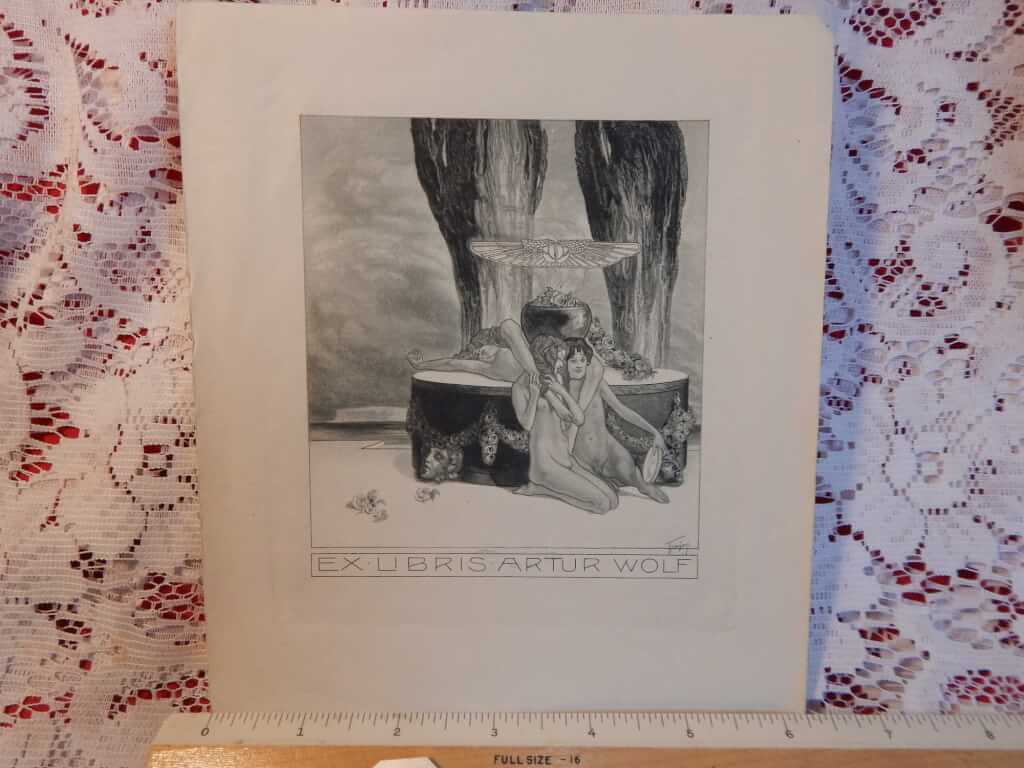 Ex Libris Artur Wolf, by Franz von Bayros paper size 6.25 x 7.25", print size 5 x 5.75", on hand laid paper three naked girls Franz von Bayros (1866 – 1924) was an Austrian commercial artist, illustrator, and painter, now he is best known for his erotic work. He belonged to the Decadent movement in art, often utilizing erotic themes and phantasmagoric imagery. At the age 17, Bayros passed the entrance exam for the Vienna Academy with Eduard von Engerth. Bayros mixed in elegant society and soon belonged to the circle of friends of Johann Straub, whose step daughter Alice he married on 1896. The next year, Bayros moved to Munich. In 1904, Bayros gave his first exhibition in Munich, which was a great success. From 1904 until 1908, Bayros traveled to Paris and Italy for his studies. Typically, for an artist dealing with such imagery, von Bayros produced work under several pseudonyms, most notably Choisy Le Conin, and was hounded by authorities for much of his life for his “indecent” art often very imaginative, and including such taboo subjects as sadomasochism and bestiality. He became equally well-known for his masterly drawn figures of elegant modestly nude and non-nude women.
Ex Libris Artur Wolf, by Franz von Bayros paper size 6.25 x 7.25", print size 5 x 5.75", on hand laid paper three naked girls Franz von Bayros (1866 – 1924) was an Austrian commercial artist, illustrator, and painter, now he is best known for his erotic work. He belonged to the Decadent movement in art, often utilizing erotic themes and phantasmagoric imagery. At the age 17, Bayros passed the entrance exam for the Vienna Academy with Eduard von Engerth. Bayros mixed in elegant society and soon belonged to the circle of friends of Johann Straub, whose step daughter Alice he married on 1896. The next year, Bayros moved to Munich. In 1904, Bayros gave his first exhibition in Munich, which was a great success. From 1904 until 1908, Bayros traveled to Paris and Italy for his studies. Typically, for an artist dealing with such imagery, von Bayros produced work under several pseudonyms, most notably Choisy Le Conin, and was hounded by authorities for much of his life for his “indecent” art often very imaginative, and including such taboo subjects as sadomasochism and bestiality. He became equally well-known for his masterly drawn figures of elegant modestly nude and non-nude women. -
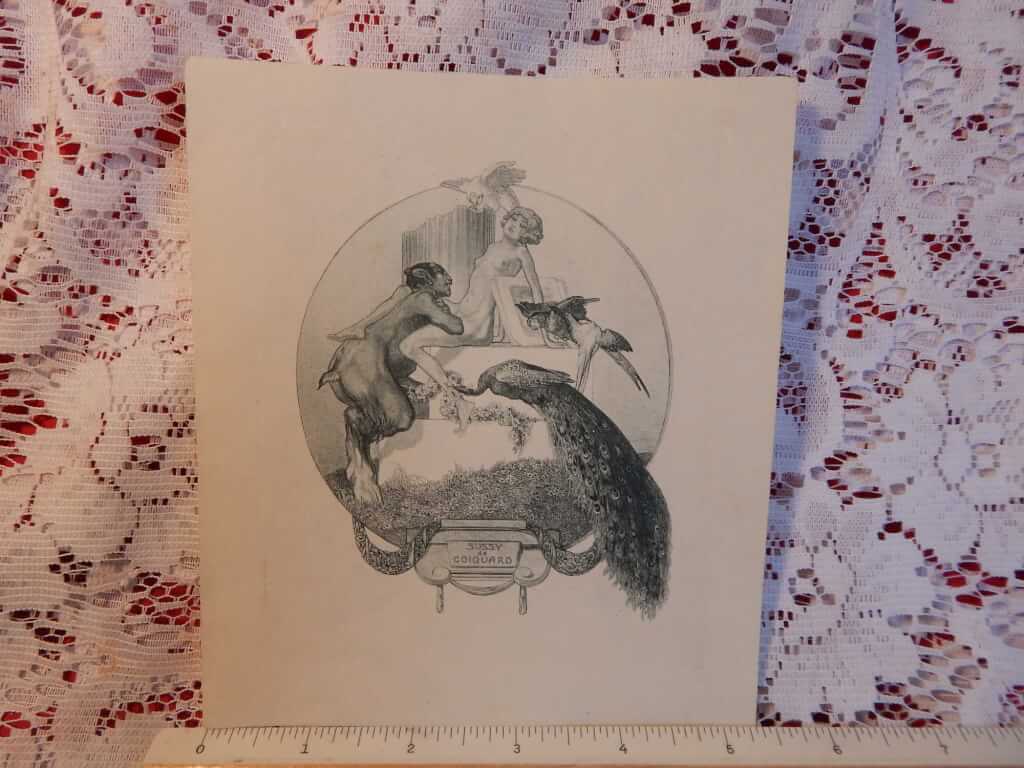 Ex libris Sussy de Coiquard, by Franz von Bayros paper size 5.5 x 6.25", print size 4.25 x 5.25" naked girl entertaining Pan(?), with peacock and other birds Franz von Bayros (1866 – 1924) was an Austrian commercial artist, illustrator, and painter, now he is best known for his erotic work. He belonged to the Decadent movement in art, often utilizing erotic themes and phantasmagoric imagery. At the age 17, Bayros passed the entrance exam for the Vienna Academy with Eduard von Engerth. Bayros mixed in elegant society and soon belonged to the circle of friends of Johann Straub, whose step daughter Alice he married on 1896. The next year, Bayros moved to Munich. In 1904, Bayros gave his first exhibition in Munich, which was a great success. From 1904 until 1908, Bayros traveled to Paris and Italy for his studies. Typically, for an artist dealing with such imagery, von Bayros produced work under several pseudonyms, most notably Choisy Le Conin, and was hounded by authorities for much of his life for his “indecent” art often very imaginative, and including such taboo subjects as sadomasochism and bestiality. He became equally well-known for his masterly drawn figures of elegant modestly nude and non-nude women.
Ex libris Sussy de Coiquard, by Franz von Bayros paper size 5.5 x 6.25", print size 4.25 x 5.25" naked girl entertaining Pan(?), with peacock and other birds Franz von Bayros (1866 – 1924) was an Austrian commercial artist, illustrator, and painter, now he is best known for his erotic work. He belonged to the Decadent movement in art, often utilizing erotic themes and phantasmagoric imagery. At the age 17, Bayros passed the entrance exam for the Vienna Academy with Eduard von Engerth. Bayros mixed in elegant society and soon belonged to the circle of friends of Johann Straub, whose step daughter Alice he married on 1896. The next year, Bayros moved to Munich. In 1904, Bayros gave his first exhibition in Munich, which was a great success. From 1904 until 1908, Bayros traveled to Paris and Italy for his studies. Typically, for an artist dealing with such imagery, von Bayros produced work under several pseudonyms, most notably Choisy Le Conin, and was hounded by authorities for much of his life for his “indecent” art often very imaginative, and including such taboo subjects as sadomasochism and bestiality. He became equally well-known for his masterly drawn figures of elegant modestly nude and non-nude women. -
Out of stock

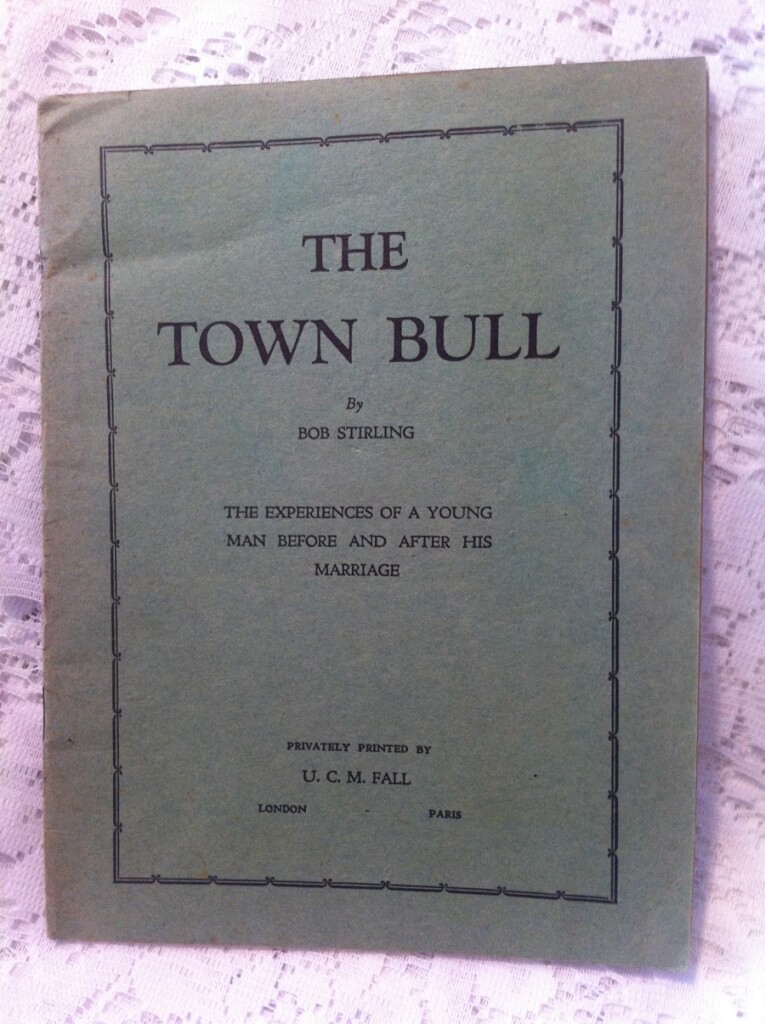 The Town Bull: the experiences of a young man before and after his marriage Bob Stirling, (Privately Printed by U. C. M. Fall, London, Paris,nd [false imprint. this is a pamphlet, not the book]) 7.25" x 5.5", 32pp., pamphlet, good condition, some fading Erotic story, no illustrations
The Town Bull: the experiences of a young man before and after his marriage Bob Stirling, (Privately Printed by U. C. M. Fall, London, Paris,nd [false imprint. this is a pamphlet, not the book]) 7.25" x 5.5", 32pp., pamphlet, good condition, some fading Erotic story, no illustrations -

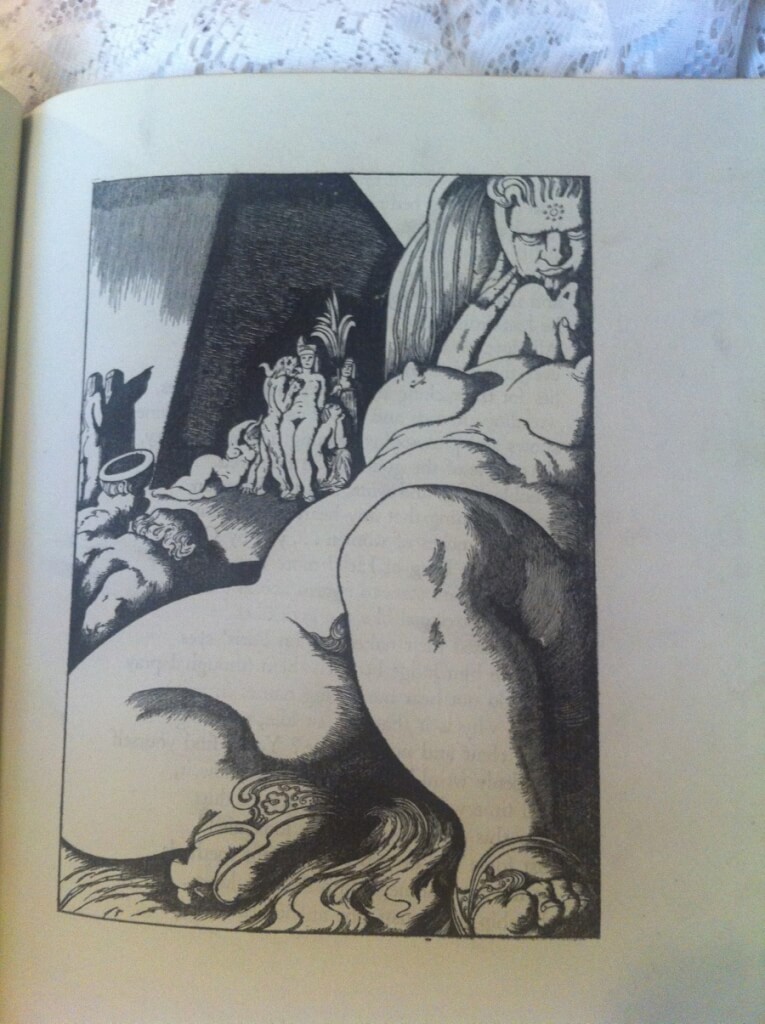 The Mimiambs of Herondas, Herodas, Translated by Jack Lindsay, Decorated by Alan Odle, with a Foreword by Brian Penton. (The Fanfrolico Press, London, nd [c. 1929], #351/375 [first edition, and first Fanfrolico to be printed in London]) 11 7/8" X 9 3/8", unpaginated 72pp, hardbound no DJ, original buckram-backed decorated Japanese paper boards with plain green cloth spine and gilt lettering, top edge gilt, other edges deckle, poor condition, boards show major wear, spine worn off, binding still good, boards still attached, interior pages are fine, Cloister types on Van Gelder Antique handmade paper Herodas was a Greek poet and the author of short humorous dramatic scenes in verse, written under the Alexandrian empire in the 3rd century BC. Mimes were scenes in popular life in South Italy and Sicily, written in the language of the people, vigorous with racy proverbs such as we get in other reflections of that region. The Mimes of Herodas have been known to us only since the discovery and publication of the "Kenyon", M. S. Buck, by the British Museum in 1891 (from a parchment containing 7 legible mimes half of the 8th and a fragment of the 9th). This was Fanfrolico's first London book. It was published "for subscribers to The Franfrolico Press". This new translation of Mimiambs of Herondas was translated by Jack Lindsay and beautifully illustrated by Alan Odle whose grotesque and subversive style was a precursor of surrealism. This is a beautiful printed book in great condition and quite rare. Fanfrolico Press, Australia’s first ‘private press’ in the arts-and-craft tradition, was founded by Jack Lindsay, P. R. Stephensen and John Kirtley, originally in North Sydney in 1923. The press specialized in printings artful, limited editions of classics and forgotten works that were suited to the extravagant style of artist like his father, artist, sculptor and author Norman Lindsay who illustrated many of their books. Fanfrolico was scornful of modernism and with its florid style determinedly backward-looking. They did surprisingly well, despite the lack of business expertise of their young, ambitious "bohemian" owners, eking out a living despite the risky move to London in 1926 and upheavals in ownership that saw the departure in 1927 of Kirtley, and then Stephenson in 1929. Sometime in 1930 they published their last book.
The Mimiambs of Herondas, Herodas, Translated by Jack Lindsay, Decorated by Alan Odle, with a Foreword by Brian Penton. (The Fanfrolico Press, London, nd [c. 1929], #351/375 [first edition, and first Fanfrolico to be printed in London]) 11 7/8" X 9 3/8", unpaginated 72pp, hardbound no DJ, original buckram-backed decorated Japanese paper boards with plain green cloth spine and gilt lettering, top edge gilt, other edges deckle, poor condition, boards show major wear, spine worn off, binding still good, boards still attached, interior pages are fine, Cloister types on Van Gelder Antique handmade paper Herodas was a Greek poet and the author of short humorous dramatic scenes in verse, written under the Alexandrian empire in the 3rd century BC. Mimes were scenes in popular life in South Italy and Sicily, written in the language of the people, vigorous with racy proverbs such as we get in other reflections of that region. The Mimes of Herodas have been known to us only since the discovery and publication of the "Kenyon", M. S. Buck, by the British Museum in 1891 (from a parchment containing 7 legible mimes half of the 8th and a fragment of the 9th). This was Fanfrolico's first London book. It was published "for subscribers to The Franfrolico Press". This new translation of Mimiambs of Herondas was translated by Jack Lindsay and beautifully illustrated by Alan Odle whose grotesque and subversive style was a precursor of surrealism. This is a beautiful printed book in great condition and quite rare. Fanfrolico Press, Australia’s first ‘private press’ in the arts-and-craft tradition, was founded by Jack Lindsay, P. R. Stephensen and John Kirtley, originally in North Sydney in 1923. The press specialized in printings artful, limited editions of classics and forgotten works that were suited to the extravagant style of artist like his father, artist, sculptor and author Norman Lindsay who illustrated many of their books. Fanfrolico was scornful of modernism and with its florid style determinedly backward-looking. They did surprisingly well, despite the lack of business expertise of their young, ambitious "bohemian" owners, eking out a living despite the risky move to London in 1926 and upheavals in ownership that saw the departure in 1927 of Kirtley, and then Stephenson in 1929. Sometime in 1930 they published their last book. -

 My Secret Life, anonymous (Grove Press, Inc., New York, 1966 [first edition thus, first printing]) 9 1/4" X 6 1/4", 2 vol. 1291pp 1069pp [2nd vol. numbered 1291-2359], hardbound with dust jackets (with protector) and slip case, very good condition, very slight sunning on slip case, Ex Libris Robert Kintzler My Secret Life, by "Walter", is the memoir of a Victorian gentleman's sexual development and experiences. Between approximately 1883 and 1895, someone, presumably an Englishman of means, had printed on the Continent an eleven-volume sexual autobiography limited, so he thought, to just six copies. Who the printer or publisher was has not been established with certainty but the most likely possibility is Auguste Brancart, a prolific publisher of erotica who began his career in the early 1880's in Bruxelles and toward the end of the decade moved to Amsterdam. Interestingly, the original title page of My Secret Life has 'Amsterdam. Not for Publication' on it but in the sub rosa world of erotica publishing such indications are to be taken with a pinch of salt. The scarcity of the first edition of My Secret Life has been overstated; it certainly is a rare book. More than six copies, as ordered, were undoubtedly run off. From the number that have reliably been reported to exist, the number appears to have been in the region of twenty to twenty-five sets. Aleister Crowley was supposed to have had one, as well as the silent film comedian Harold Lloyd and Joseph von Sternberg, Marlene Dietrich's director and one-time lover. Charles Reginald Dawes, the last great English collector of erotica, had two sets, one of which was destroyed the the British Customs and the other going eventually to the British Library in 1964. Lord Louis Mountbatten's brother, the 2nd marquess of Milford Haven, certainly possessed a copy for it exists currently in a fine London collection and contains his bookplate. There is a copy in Geneva, another in Hamburg and at least two in New York. Two attempts to publish a reprint in the United States in the 1930's failed due to police action. The first, which began about 1932, followed the original edition as to title and imprint and got as far as volume three before the project was shut down. A copy with 100 original water colors by Clara Tice was auctioned by Parke-Bernet at New York in 1971. A second attempt took place about two years later, with a single volume called Marital Frolics (London [New York or Philadelphia]: For Distribution by Subscription Only [c. 1934]). This constituted an abridgment of volume 5, and was illustrated with ten plates by 'Malay.' A copy was likewise auctioned by Parke-Bernet in the same sale. The Grove Press reprint of 1966 is the first complete edition to be openly available. It was prepared from an eleven-volume typescript made directly from the copy in Hamburg referred to above. All subsequent reprints stem, legally or otherwise, from this. Gershon Legman's Introduction to the Grove Press reprint is a mine of fascinating information, and includes a closely argued case for My Secret Life having been written by Henry Spencer Ashbee, the famous Victorian bibliographer and collector of erotica. The present compiler is unable to share this view, but thinks it likely that Ashbee was involved in seeing it through the press on behalf of somebody else. This book is often wrongly attributed to Frank Harris, through confusion with My Life and Loves, which is a similar (although not as explicit) account of Harris' life. A number of reprints followed the Grove Press edition, including one published by Brandon House of North Hollywood and Pendulum Books of Atlanta, Georgia and a complete French translation.
My Secret Life, anonymous (Grove Press, Inc., New York, 1966 [first edition thus, first printing]) 9 1/4" X 6 1/4", 2 vol. 1291pp 1069pp [2nd vol. numbered 1291-2359], hardbound with dust jackets (with protector) and slip case, very good condition, very slight sunning on slip case, Ex Libris Robert Kintzler My Secret Life, by "Walter", is the memoir of a Victorian gentleman's sexual development and experiences. Between approximately 1883 and 1895, someone, presumably an Englishman of means, had printed on the Continent an eleven-volume sexual autobiography limited, so he thought, to just six copies. Who the printer or publisher was has not been established with certainty but the most likely possibility is Auguste Brancart, a prolific publisher of erotica who began his career in the early 1880's in Bruxelles and toward the end of the decade moved to Amsterdam. Interestingly, the original title page of My Secret Life has 'Amsterdam. Not for Publication' on it but in the sub rosa world of erotica publishing such indications are to be taken with a pinch of salt. The scarcity of the first edition of My Secret Life has been overstated; it certainly is a rare book. More than six copies, as ordered, were undoubtedly run off. From the number that have reliably been reported to exist, the number appears to have been in the region of twenty to twenty-five sets. Aleister Crowley was supposed to have had one, as well as the silent film comedian Harold Lloyd and Joseph von Sternberg, Marlene Dietrich's director and one-time lover. Charles Reginald Dawes, the last great English collector of erotica, had two sets, one of which was destroyed the the British Customs and the other going eventually to the British Library in 1964. Lord Louis Mountbatten's brother, the 2nd marquess of Milford Haven, certainly possessed a copy for it exists currently in a fine London collection and contains his bookplate. There is a copy in Geneva, another in Hamburg and at least two in New York. Two attempts to publish a reprint in the United States in the 1930's failed due to police action. The first, which began about 1932, followed the original edition as to title and imprint and got as far as volume three before the project was shut down. A copy with 100 original water colors by Clara Tice was auctioned by Parke-Bernet at New York in 1971. A second attempt took place about two years later, with a single volume called Marital Frolics (London [New York or Philadelphia]: For Distribution by Subscription Only [c. 1934]). This constituted an abridgment of volume 5, and was illustrated with ten plates by 'Malay.' A copy was likewise auctioned by Parke-Bernet in the same sale. The Grove Press reprint of 1966 is the first complete edition to be openly available. It was prepared from an eleven-volume typescript made directly from the copy in Hamburg referred to above. All subsequent reprints stem, legally or otherwise, from this. Gershon Legman's Introduction to the Grove Press reprint is a mine of fascinating information, and includes a closely argued case for My Secret Life having been written by Henry Spencer Ashbee, the famous Victorian bibliographer and collector of erotica. The present compiler is unable to share this view, but thinks it likely that Ashbee was involved in seeing it through the press on behalf of somebody else. This book is often wrongly attributed to Frank Harris, through confusion with My Life and Loves, which is a similar (although not as explicit) account of Harris' life. A number of reprints followed the Grove Press edition, including one published by Brandon House of North Hollywood and Pendulum Books of Atlanta, Georgia and a complete French translation. -
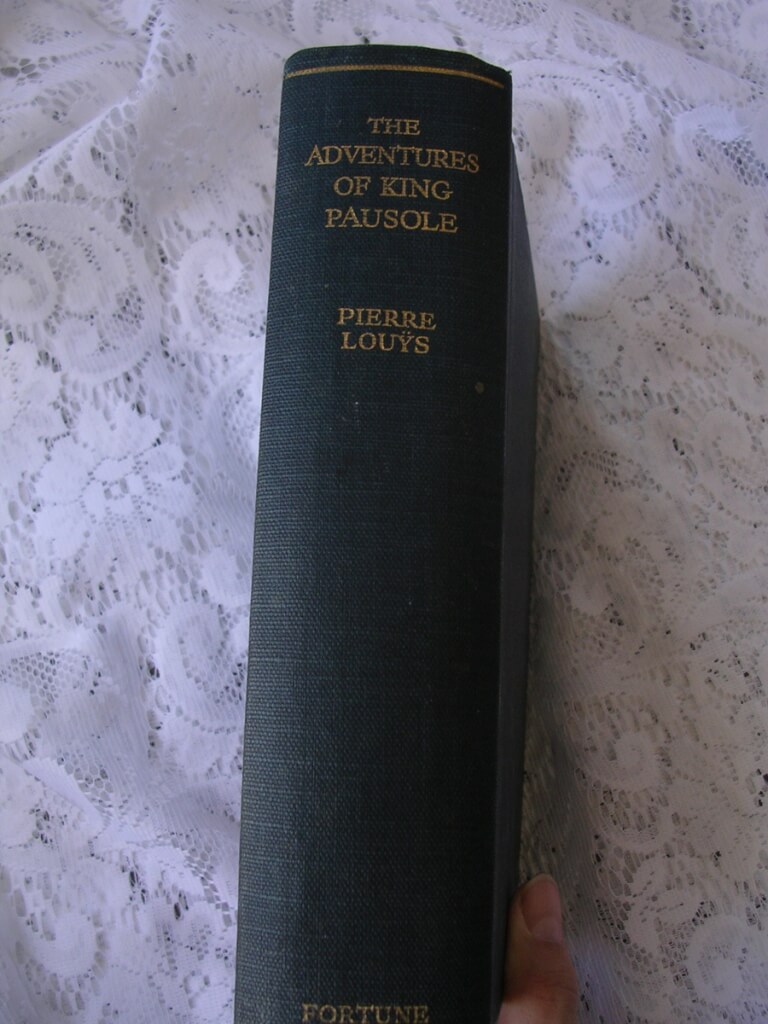
 The Adventures of King Pausole, Pierre Louys, trans. Charles Hope Lumley, illustrated by Beresford Egan (The Fortune Press, London, 1929, #333/1200, "printed at Leige by the Imprimerie Vaillant-Carmanne - M. C. M. XXIX") 9 1/4" X 7", 312pp, hardbound no DJ, quarter cloth, marbled boards, gilt lettering on spine, printed on "batchelor hand-made paper", top edge gilted other edges deckle, in good condition, corners are bumped, some pages remain uncut, spine slightly cocked, some light rubbing to tail some pages remain unread/uncut Pierre Louys (1870 - 1925) was a French poet and writer, most renowned for lesbian and classical themes in some of his writings. He is known as a writer who "expressed pagan sensuality with stylistic perfection." This book is a humorous and risqué "libertine" story about a king with many wives (one for each day of the year). As part of the story, King Pausole had two laws "1. hurt no man. 2. Then do as you please." This law has been embraced many including pagan/wiccan community when Aleister Crowley introduced this as his "First Law". First English edition, 6 full page colour plates by Beresford.
The Adventures of King Pausole, Pierre Louys, trans. Charles Hope Lumley, illustrated by Beresford Egan (The Fortune Press, London, 1929, #333/1200, "printed at Leige by the Imprimerie Vaillant-Carmanne - M. C. M. XXIX") 9 1/4" X 7", 312pp, hardbound no DJ, quarter cloth, marbled boards, gilt lettering on spine, printed on "batchelor hand-made paper", top edge gilted other edges deckle, in good condition, corners are bumped, some pages remain uncut, spine slightly cocked, some light rubbing to tail some pages remain unread/uncut Pierre Louys (1870 - 1925) was a French poet and writer, most renowned for lesbian and classical themes in some of his writings. He is known as a writer who "expressed pagan sensuality with stylistic perfection." This book is a humorous and risqué "libertine" story about a king with many wives (one for each day of the year). As part of the story, King Pausole had two laws "1. hurt no man. 2. Then do as you please." This law has been embraced many including pagan/wiccan community when Aleister Crowley introduced this as his "First Law". First English edition, 6 full page colour plates by Beresford. -
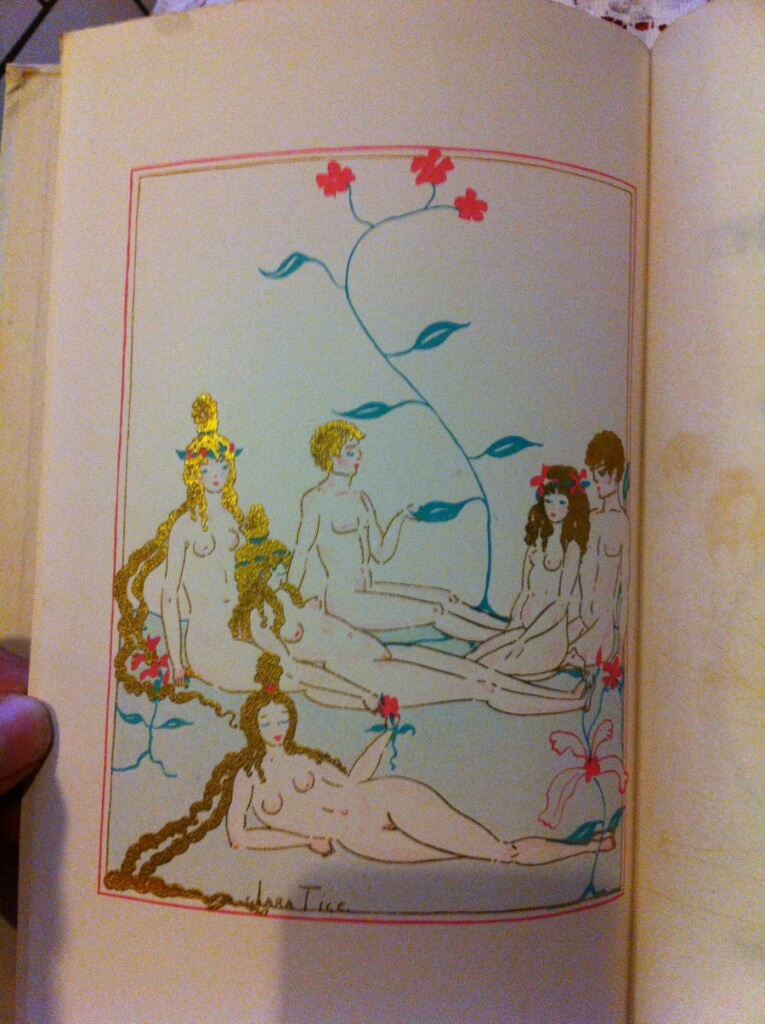
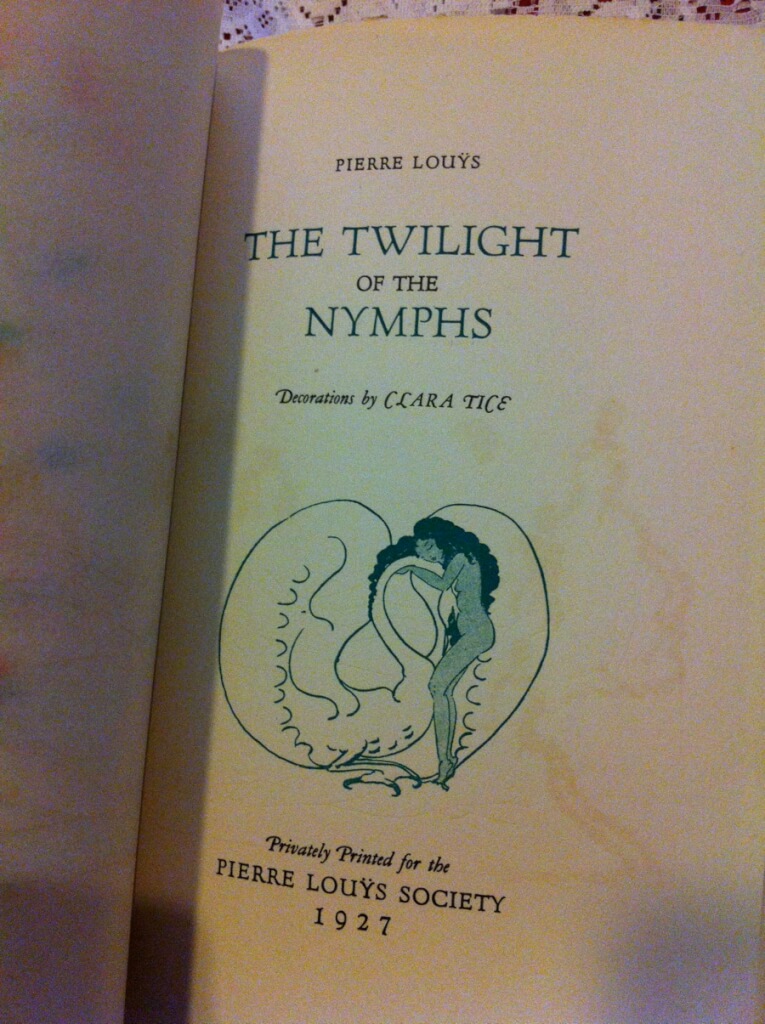 The Twilight of the Nymphs, Pierre Louys, illustrated by Clara Tice, "designed and supervised by Harry Cunningham" (The Pierre Louys Society, US, 1927, #682/990) 9.75" x 6.5", 235pp, white boards with silver gilt decorations on cover and spine, no dustjacket, fair condition, back boards loose but holding, pages clean. Pierre Louys (1870 - 1925) was a French poet and writer, most renowned for lesbian and classical themes in some of his writings. He is known as a writer who "expressed pagan sensuality with stylistic perfection." A collection of seven mildly erotic fables based on mythology. "This Edition Limited to 1250 copies of which 990 are for America, No. 682". 28 beautiful color illustrations by Clara Tice, all with tissue overlay and enhanced with gilt and silver.
The Twilight of the Nymphs, Pierre Louys, illustrated by Clara Tice, "designed and supervised by Harry Cunningham" (The Pierre Louys Society, US, 1927, #682/990) 9.75" x 6.5", 235pp, white boards with silver gilt decorations on cover and spine, no dustjacket, fair condition, back boards loose but holding, pages clean. Pierre Louys (1870 - 1925) was a French poet and writer, most renowned for lesbian and classical themes in some of his writings. He is known as a writer who "expressed pagan sensuality with stylistic perfection." A collection of seven mildly erotic fables based on mythology. "This Edition Limited to 1250 copies of which 990 are for America, No. 682". 28 beautiful color illustrations by Clara Tice, all with tissue overlay and enhanced with gilt and silver. -
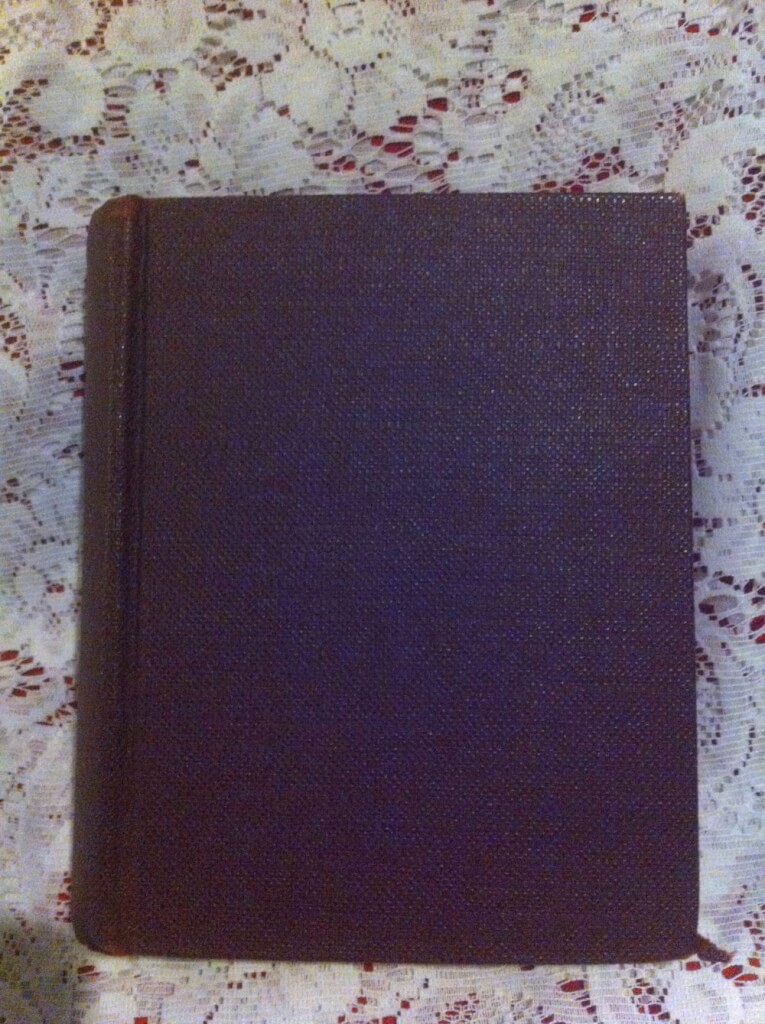
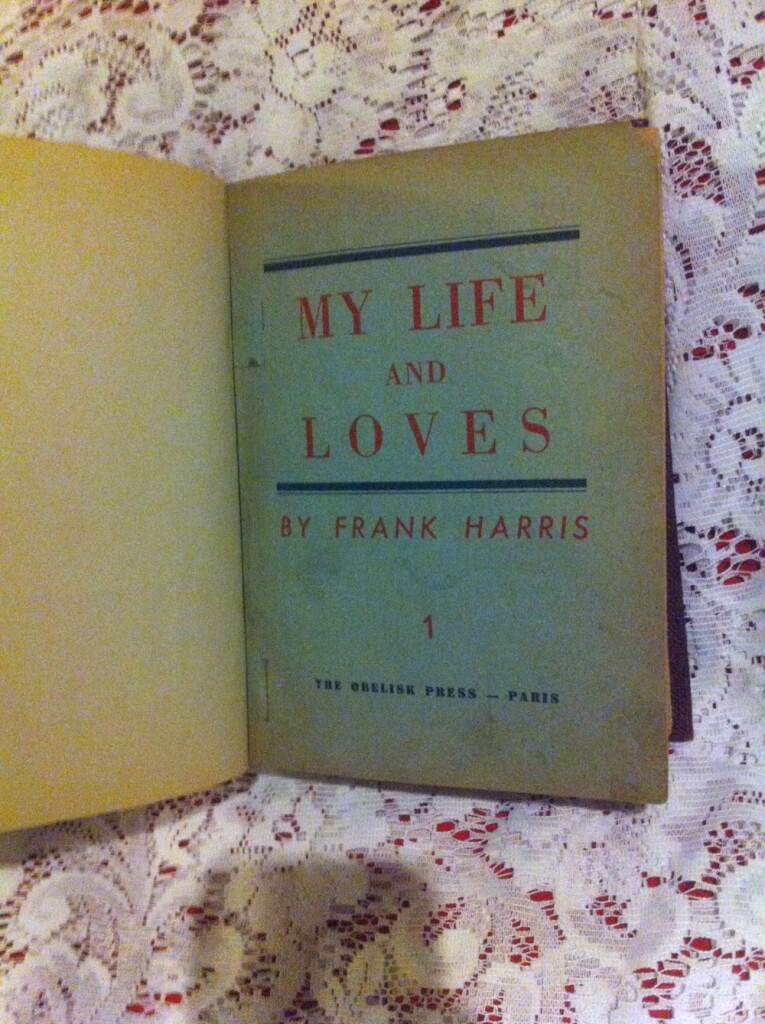 My Life and Loves, Frank Harris (Obelisk Press Books, Paris, 1945) 7" X 5.5", 233pp, 302pp, 176pp, 178pp., 4 vols hardbound in one book, red cloth boards, very good condition for age, pages yellowing no titles on spine or boards. Autobiography of the Ireland-born, naturalized-American writer and editor Frank Harris (1856_1931). Published privately by Harris between 1922 and 1927, and by Jack Kahane's Obelisk Press in 1931, the work consisted of four volumes (with a 5th promised but never delivered). The book gives a graphic account of Harris' sexual adventures and relates gossip about the sexual activities of celebrities of his day. Printed on somewhat cheap paper, these volumes are often in rough shape. This book presents the volumes preserved as best as can be expected for their age.
My Life and Loves, Frank Harris (Obelisk Press Books, Paris, 1945) 7" X 5.5", 233pp, 302pp, 176pp, 178pp., 4 vols hardbound in one book, red cloth boards, very good condition for age, pages yellowing no titles on spine or boards. Autobiography of the Ireland-born, naturalized-American writer and editor Frank Harris (1856_1931). Published privately by Harris between 1922 and 1927, and by Jack Kahane's Obelisk Press in 1931, the work consisted of four volumes (with a 5th promised but never delivered). The book gives a graphic account of Harris' sexual adventures and relates gossip about the sexual activities of celebrities of his day. Printed on somewhat cheap paper, these volumes are often in rough shape. This book presents the volumes preserved as best as can be expected for their age. -

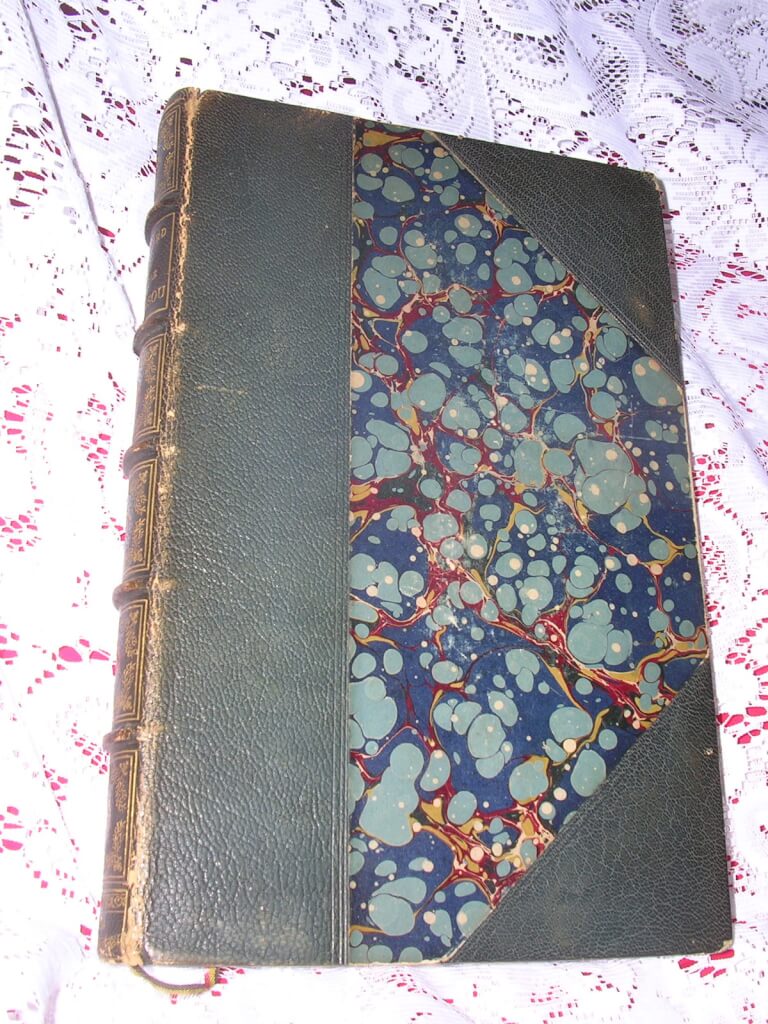 Mon Oncle Barbassou, Mario Uchard, illust. Paul Avril (J. Lemonnyer, Paris, 1884 [#394/1000, one of only 225 printed on Holland Paper]) 10" X 6.5", 311pp., hardbound in 3/4 dark blue morocco leather with gilt titles and decorations on spine with 5 raised bands, marbled endpapers, top edge gilt others deckled. First Illustrated Edition with many beautiful engravings by Paul Avril throughout. Some very slight wear to leather and boards, otherwise a very good+ copy overall clean, bright and structurally sound. #394/1000, one of only 275 in Holland Paper. Originally published in 4 parts in 1876, My Uncle Barbassou is a story of a man who inherits his uncle's estate which includes a newly purchased harem of 3 young girls. This novel is a prime example of the French "Orientalists" of the late 1800's. Scandalous for the age, but mild by today's standards, this book is in the original french. This is a beautifully bound copy of the First Illustrated Edition with plates by Paul Avril. Édouard-Henri Avril (1849-1928) used the pseudonym "Paul Avril" for his erotic work. He was a French painter and commercial artist. His career saw collaboration with influential people like Octave Uzanne, Henry Spencer Ashbee and Friedrich Karl Forberg. He is one of the most celebrated erotic artists of his age. Avril was a soldier before starting his career in art. He was awarded with the Legion of Honour for his actions in the Franco-Prussian War.
Mon Oncle Barbassou, Mario Uchard, illust. Paul Avril (J. Lemonnyer, Paris, 1884 [#394/1000, one of only 225 printed on Holland Paper]) 10" X 6.5", 311pp., hardbound in 3/4 dark blue morocco leather with gilt titles and decorations on spine with 5 raised bands, marbled endpapers, top edge gilt others deckled. First Illustrated Edition with many beautiful engravings by Paul Avril throughout. Some very slight wear to leather and boards, otherwise a very good+ copy overall clean, bright and structurally sound. #394/1000, one of only 275 in Holland Paper. Originally published in 4 parts in 1876, My Uncle Barbassou is a story of a man who inherits his uncle's estate which includes a newly purchased harem of 3 young girls. This novel is a prime example of the French "Orientalists" of the late 1800's. Scandalous for the age, but mild by today's standards, this book is in the original french. This is a beautifully bound copy of the First Illustrated Edition with plates by Paul Avril. Édouard-Henri Avril (1849-1928) used the pseudonym "Paul Avril" for his erotic work. He was a French painter and commercial artist. His career saw collaboration with influential people like Octave Uzanne, Henry Spencer Ashbee and Friedrich Karl Forberg. He is one of the most celebrated erotic artists of his age. Avril was a soldier before starting his career in art. He was awarded with the Legion of Honour for his actions in the Franco-Prussian War. -
 Julie, ou J'ai sauvé ma rose, Madame de C*** [Félicité Choiseul-Meuse] (Se trouve chez tous les Libraires Anglais, 1882) 8" x 5.25", 2 vol. bound together, 166pp 183pp, half calf on marbled boards, original wraps bound within, red label with gilt titles on spine, just good condition, boards intact, binding good, ribbon intact, major scuffing and bumping to the spine and rubbing to the boards. Felicite de Choiseul-Meuse wrote approximately twenty-seven novels from 1797 to 1824. Writings are sometimes identified by pseudonyms and acronyms: LFDLC; Emilia P ***, Madame de C *** , etc.. Her 1807 novel "Julie, ou j'ai sauvé ma rose" [Julie, or I saved my rose] is widely considered the first erotic novel written by a woman. It is more appropriately translated as "how I kept my cherry" for it tells the tale of a young woman who lets her lovers fondle her all they want, but will not allow penetration until she finds the right man and marries him. The work was condemned as obscene and its destruction ordered by the Cour royale de Paris on August 5, 1828. Excerpt: "I tasted in his arms unspeakable pleasures. Deadened by pleasure, then revived by an even more delirious pleasure, I made the object of happiness almost as happy as I was myself; and yet, true to my system, I made sure that he did not harvest the rose."
Julie, ou J'ai sauvé ma rose, Madame de C*** [Félicité Choiseul-Meuse] (Se trouve chez tous les Libraires Anglais, 1882) 8" x 5.25", 2 vol. bound together, 166pp 183pp, half calf on marbled boards, original wraps bound within, red label with gilt titles on spine, just good condition, boards intact, binding good, ribbon intact, major scuffing and bumping to the spine and rubbing to the boards. Felicite de Choiseul-Meuse wrote approximately twenty-seven novels from 1797 to 1824. Writings are sometimes identified by pseudonyms and acronyms: LFDLC; Emilia P ***, Madame de C *** , etc.. Her 1807 novel "Julie, ou j'ai sauvé ma rose" [Julie, or I saved my rose] is widely considered the first erotic novel written by a woman. It is more appropriately translated as "how I kept my cherry" for it tells the tale of a young woman who lets her lovers fondle her all they want, but will not allow penetration until she finds the right man and marries him. The work was condemned as obscene and its destruction ordered by the Cour royale de Paris on August 5, 1828. Excerpt: "I tasted in his arms unspeakable pleasures. Deadened by pleasure, then revived by an even more delirious pleasure, I made the object of happiness almost as happy as I was myself; and yet, true to my system, I made sure that he did not harvest the rose." -
 Julie, ou J'ai sauvé ma rose, Madame de C*** [Félicité Choiseul-Meuse] (J.-J. Gay, Bruxelles, 1882) 8" x 5.25", 2 vol. 169pp 188pp, full mottled calf, marbled endpapers. Gilt lettering and decorations on spine, 5 raised bands. 2 frontispiece engravings. just Fair condition, interior good, exterior in poor shape, Vol. 1 boards loose, Vol. 2 boards detached. Felicite de Choiseul-Meuse wrote approximately twenty-seven novels from 1797 to 1824. Writings are sometimes identified by pseudonyms and acronyms: LFDLC; Emilia P ***, Madame de C *** , etc.. Her 1807 novel "Julie, ou j'ai sauvé ma rose" [Julie, or I saved my rose] is widely considered the first erotic novel written by a woman. It is more appropriately translated as "how I kept my cherry" for it tells the tale of a young woman who lets her lovers fondle her all they want, but will not allow penetration until she finds the right man and marries him. The work was condemned as obscene and its destruction ordered by the Cour royale de Paris on August 5, 1828. Excerpt: "I tasted in his arms unspeakable pleasures. Deadened by pleasure, then revived by an even more delirious pleasure, I made the object of happiness almost as happy as I was myself; and yet, true to my system, I made sure that he did not harvest the rose."
Julie, ou J'ai sauvé ma rose, Madame de C*** [Félicité Choiseul-Meuse] (J.-J. Gay, Bruxelles, 1882) 8" x 5.25", 2 vol. 169pp 188pp, full mottled calf, marbled endpapers. Gilt lettering and decorations on spine, 5 raised bands. 2 frontispiece engravings. just Fair condition, interior good, exterior in poor shape, Vol. 1 boards loose, Vol. 2 boards detached. Felicite de Choiseul-Meuse wrote approximately twenty-seven novels from 1797 to 1824. Writings are sometimes identified by pseudonyms and acronyms: LFDLC; Emilia P ***, Madame de C *** , etc.. Her 1807 novel "Julie, ou j'ai sauvé ma rose" [Julie, or I saved my rose] is widely considered the first erotic novel written by a woman. It is more appropriately translated as "how I kept my cherry" for it tells the tale of a young woman who lets her lovers fondle her all they want, but will not allow penetration until she finds the right man and marries him. The work was condemned as obscene and its destruction ordered by the Cour royale de Paris on August 5, 1828. Excerpt: "I tasted in his arms unspeakable pleasures. Deadened by pleasure, then revived by an even more delirious pleasure, I made the object of happiness almost as happy as I was myself; and yet, true to my system, I made sure that he did not harvest the rose." -
 The Dialogues of Luisa Sigea, Nicolas Chorier, translation by Isadore Liseux (Isadore Liseux, Paris, 1890, first edition, first English translation, printed by Ch. Unsinger) 8.75" X 5.75", 2nd and 3rd books of a 3 vol set, 132pp, 98+2pp, 3/4 crimson morocco over red boards, gilt decorations and titles on spine, top edge gilt, others deckled. Excellent condition for age, very minor bumping on corners and top and bottom of spine. In six dialogues (I. The skirmish; II. Tribadicon; III. Fabric; IV. The duel; V. Pleasures; VI. Frolics and sports) Tullia, who is 26, initiates her 15 year old cousin, Ottavia, in the art of sexual pleasure. The first four dialogues (not present), are fairly short, focus on tribadism and defloration. The longer fifth and six dialogues introduce flagellation, contractual submission, group sex, and anal sex. Like many sexual fictions, The Dialogues of Luisa Sigea (originally written in latin "Aloisiae Sigeae Satyra Sotadica de arcanis Amoris et Veneris") attempts to conceal the identity of its author: it purports to be based on a Latin manuscript translation of a work written originally in Spanish in the sixteenth century by an erudite young woman, Luisa Sigea of Toledo and translated into latin by Jean Meursius of Holland. In fact, it was written c. 1660, in latin, by a Frenchman, Nicolas Chorier (1612-1692), a lawyer who wrote works on various historical and philosophical subjects. The first first French translation, L’Academie des dames, was issued in the 1680. This 1890 edition was for the first time translated into English by Isidore Liseux and issued as a 3 volume set. (1. I-IV, 2. V, 3. VI). Vol 1 is missing from this set. Isidore Liseux (1835-1894) was a French bibliophile and publisher of erotica and curiosa. His publications were mostly rare texts of 16th to 18th century authors, hard to find and little known books which were usually translated and annotated by his friend and associate Alcide Bonneau or by Liseux himself. Liseux and Bonneau, both ex-priests, knew each other since seminary. His books were published in small numbers, on high quality paper, and with excellent typography. His usual printers were Claude Motteroz, Antoine Bécus, and later Charles Unsinger. Liseux's books were published openly as the climate was more permissive in Paris at the time. His books were so well regarded that pirates of his books and even unrelated books bearing his imprint with a false date were published clandestinely into the 20th century. French poet, Guillaume Apollinaire wrote: "The publications of Liseux are more and more sought after because they are correct, beautiful and rare." (Le flaneur des deux rives, 1918).
The Dialogues of Luisa Sigea, Nicolas Chorier, translation by Isadore Liseux (Isadore Liseux, Paris, 1890, first edition, first English translation, printed by Ch. Unsinger) 8.75" X 5.75", 2nd and 3rd books of a 3 vol set, 132pp, 98+2pp, 3/4 crimson morocco over red boards, gilt decorations and titles on spine, top edge gilt, others deckled. Excellent condition for age, very minor bumping on corners and top and bottom of spine. In six dialogues (I. The skirmish; II. Tribadicon; III. Fabric; IV. The duel; V. Pleasures; VI. Frolics and sports) Tullia, who is 26, initiates her 15 year old cousin, Ottavia, in the art of sexual pleasure. The first four dialogues (not present), are fairly short, focus on tribadism and defloration. The longer fifth and six dialogues introduce flagellation, contractual submission, group sex, and anal sex. Like many sexual fictions, The Dialogues of Luisa Sigea (originally written in latin "Aloisiae Sigeae Satyra Sotadica de arcanis Amoris et Veneris") attempts to conceal the identity of its author: it purports to be based on a Latin manuscript translation of a work written originally in Spanish in the sixteenth century by an erudite young woman, Luisa Sigea of Toledo and translated into latin by Jean Meursius of Holland. In fact, it was written c. 1660, in latin, by a Frenchman, Nicolas Chorier (1612-1692), a lawyer who wrote works on various historical and philosophical subjects. The first first French translation, L’Academie des dames, was issued in the 1680. This 1890 edition was for the first time translated into English by Isidore Liseux and issued as a 3 volume set. (1. I-IV, 2. V, 3. VI). Vol 1 is missing from this set. Isidore Liseux (1835-1894) was a French bibliophile and publisher of erotica and curiosa. His publications were mostly rare texts of 16th to 18th century authors, hard to find and little known books which were usually translated and annotated by his friend and associate Alcide Bonneau or by Liseux himself. Liseux and Bonneau, both ex-priests, knew each other since seminary. His books were published in small numbers, on high quality paper, and with excellent typography. His usual printers were Claude Motteroz, Antoine Bécus, and later Charles Unsinger. Liseux's books were published openly as the climate was more permissive in Paris at the time. His books were so well regarded that pirates of his books and even unrelated books bearing his imprint with a false date were published clandestinely into the 20th century. French poet, Guillaume Apollinaire wrote: "The publications of Liseux are more and more sought after because they are correct, beautiful and rare." (Le flaneur des deux rives, 1918). -
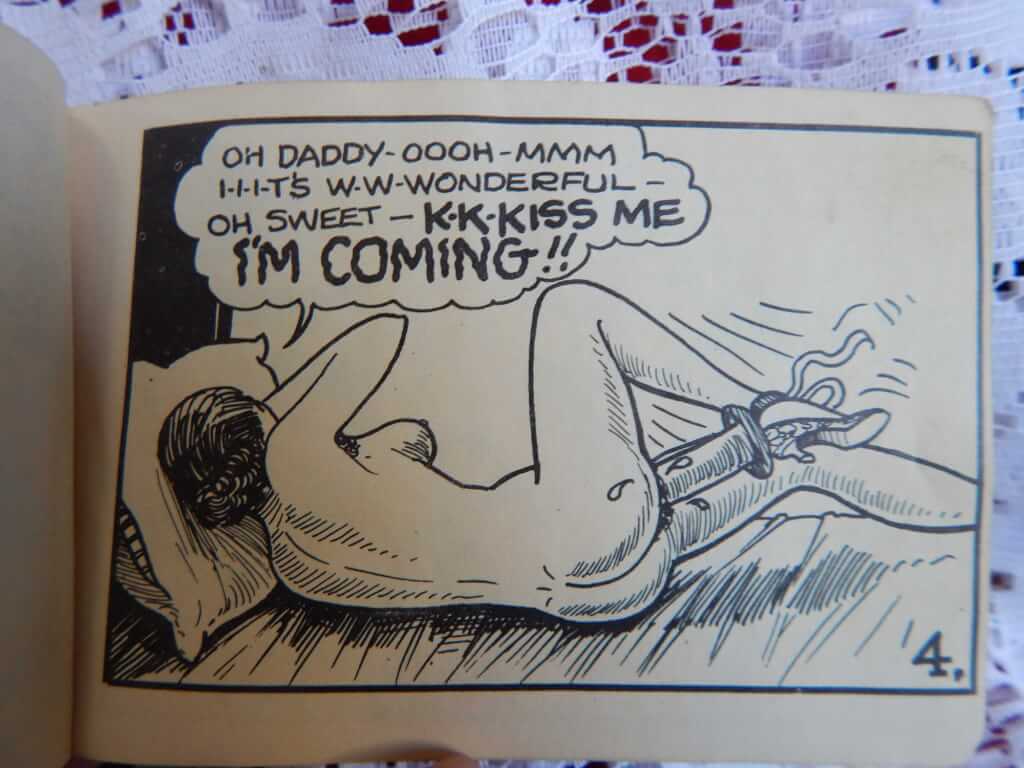
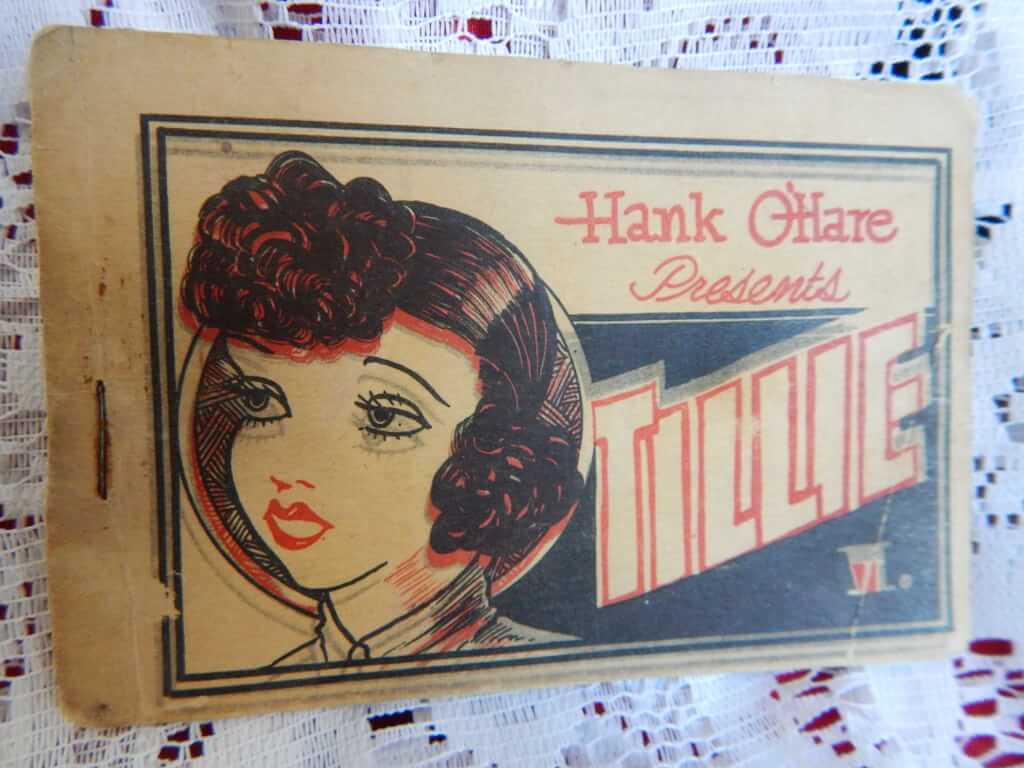 Hank O'Hare presents Tillie, (np. nd.) 4.5" x 3", 8pp., pamphlet, stapled and taped Tijuana bibles (also known as eight-pagers, bluesies, gray-backs, Jiggs-and-Maggie books, jo-jo books, Tillie-and-Mac books, and two-by-fours) were little pornographic comic books produced in the United States from the 1920s to the early 1960s.
Hank O'Hare presents Tillie, (np. nd.) 4.5" x 3", 8pp., pamphlet, stapled and taped Tijuana bibles (also known as eight-pagers, bluesies, gray-backs, Jiggs-and-Maggie books, jo-jo books, Tillie-and-Mac books, and two-by-fours) were little pornographic comic books produced in the United States from the 1920s to the early 1960s. -
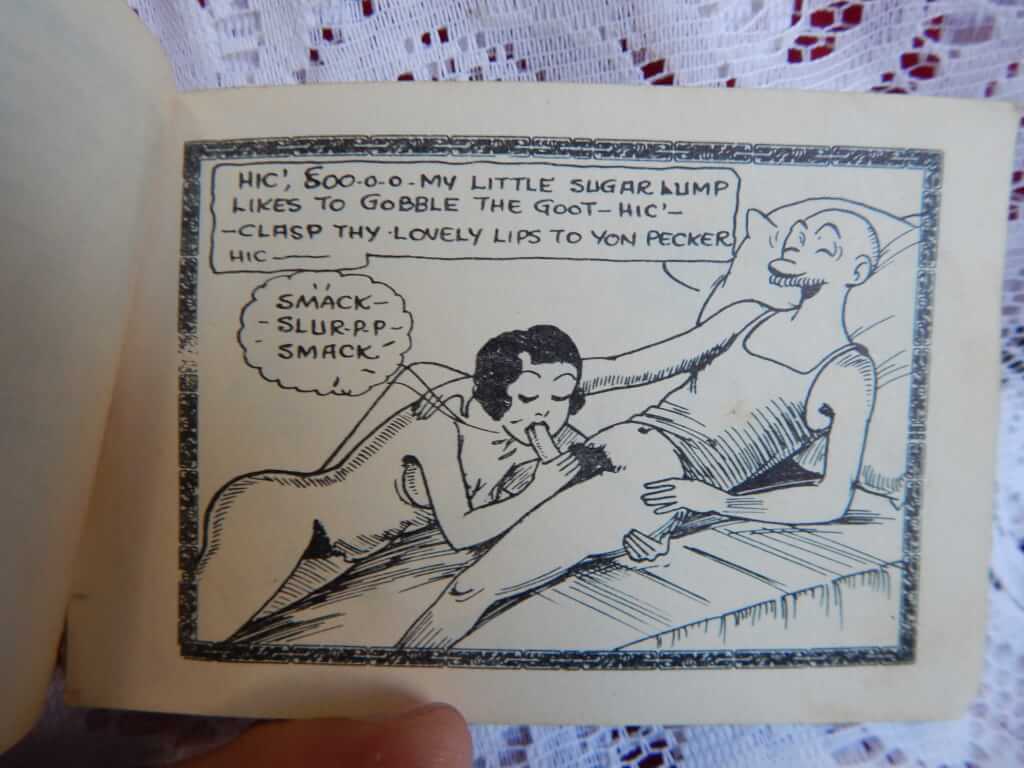
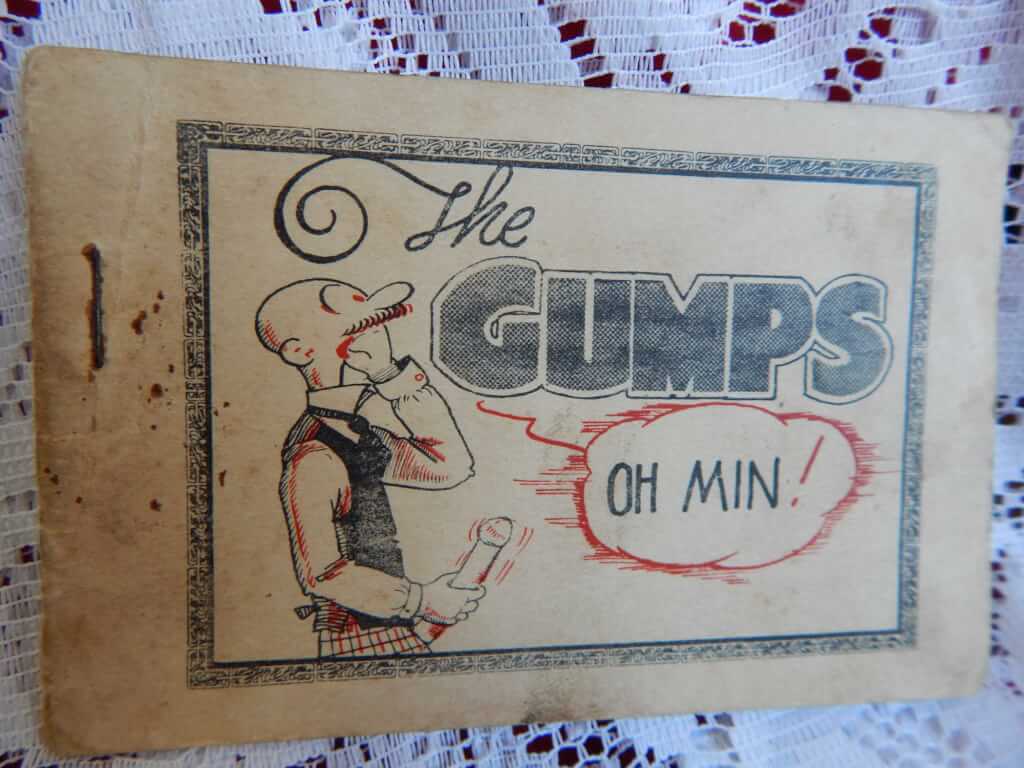 The Gumps - Oh Min!, (np. nd.) 4.5" x 3", 8pp. pamphlet, stapled Tijuana bibles (also known as eight-pagers, bluesies, gray-backs, Jiggs-and-Maggie books, jo-jo books, Tillie-and-Mac books, and two-by-fours) were little pornographic comic books produced in the United States from the 1920s to the early 1960s.
The Gumps - Oh Min!, (np. nd.) 4.5" x 3", 8pp. pamphlet, stapled Tijuana bibles (also known as eight-pagers, bluesies, gray-backs, Jiggs-and-Maggie books, jo-jo books, Tillie-and-Mac books, and two-by-fours) were little pornographic comic books produced in the United States from the 1920s to the early 1960s. -

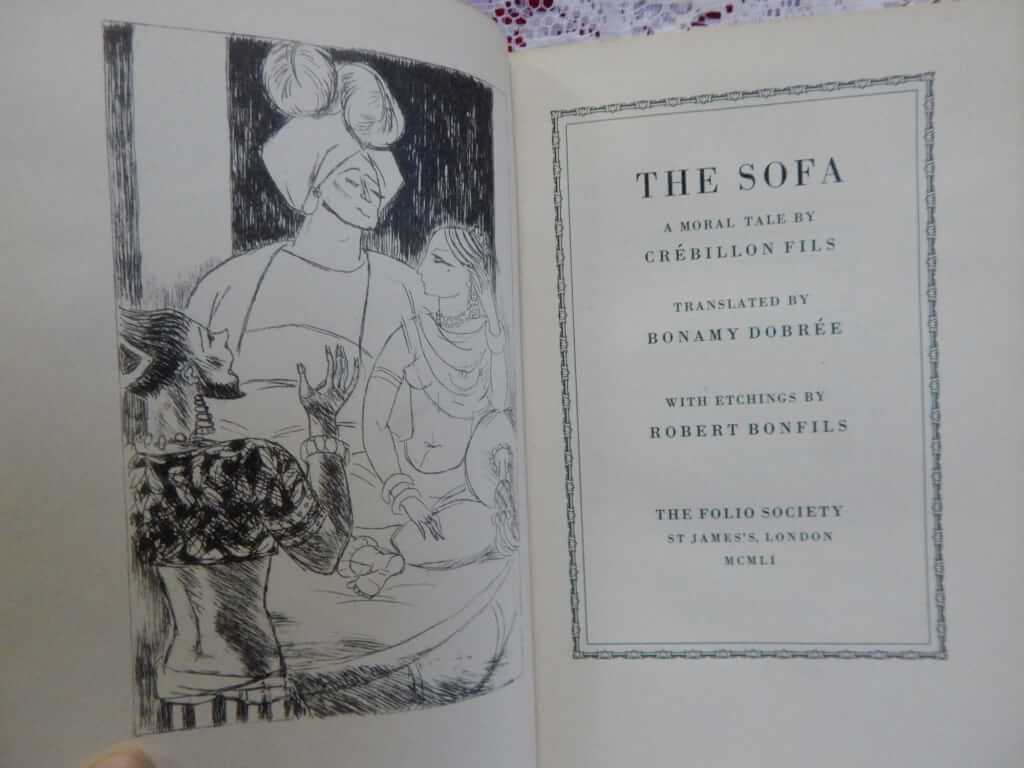 The Sofa, a moral tale by Crébillon fils, trans. Bonamy Dobrée, illus. Robert Bonfils (The Folio Society, St. James's, London, 1951) 6.75"x9.25", v+256, red boards with silver gilt decorations on spine, spine only slightly sunned, slipcase The Sofa: A Moral Tale (French: Le Sopha, conte moral) is a 1742 libertine novel by Claude Prosper Jolyot de Crébillon (Crebillon fils). It was first translated into English in the spring of 1742. The story concerns a young courtier, Amanzéï, whose soul in a previous life was condemned by Brahma to inhabit a series of sofas, and not to be reincarnated in a human body until two virgin lovers had consummated their passion for him. The novel is structured as a frame story in an oriental setting, explicitly evocative of the Arabian Nights, in which Amanzéï recounts the adventures of seven couples, which he witnessed in his sofa form, to the bored sultan Shah Baham (grandson of Shehryār and Scheherazade). The longest episode, that of Zulica, takes up nine chapters; the final episode concerns the teenage Zéïnis et Phéléas. Amanzéï, witnessing their innocent pleasure, is edified and freed through the experience of virtuous love. Many of the characters in the novel are satirical portraits of influential and powerful Parisians of Crébillon’s time; the author takes the opportunity to ridicule hypocrisy in its different forms (worldly respectability, virtue, religious devotion). Although the book was published anonymously and with a false imprint, Crébillon was discovered to be the author and was exiled to a distance of thirty leagues from Paris on April 7, 1742. He was able to return on July 22, after claiming that the work had been commissioned by Frederick II of Prussia and that it had been published against his will. Robert Bonfils started his illustration career in Chicago in the mid fifties, doing various commercial art assignments such as advertisements, lunch box decorations, catalog illustrations, magazine covers, interior story illustrations, record jacket covers, and book covers. He is best known for his covers for erotic, pulp fiction paperbacks.
The Sofa, a moral tale by Crébillon fils, trans. Bonamy Dobrée, illus. Robert Bonfils (The Folio Society, St. James's, London, 1951) 6.75"x9.25", v+256, red boards with silver gilt decorations on spine, spine only slightly sunned, slipcase The Sofa: A Moral Tale (French: Le Sopha, conte moral) is a 1742 libertine novel by Claude Prosper Jolyot de Crébillon (Crebillon fils). It was first translated into English in the spring of 1742. The story concerns a young courtier, Amanzéï, whose soul in a previous life was condemned by Brahma to inhabit a series of sofas, and not to be reincarnated in a human body until two virgin lovers had consummated their passion for him. The novel is structured as a frame story in an oriental setting, explicitly evocative of the Arabian Nights, in which Amanzéï recounts the adventures of seven couples, which he witnessed in his sofa form, to the bored sultan Shah Baham (grandson of Shehryār and Scheherazade). The longest episode, that of Zulica, takes up nine chapters; the final episode concerns the teenage Zéïnis et Phéléas. Amanzéï, witnessing their innocent pleasure, is edified and freed through the experience of virtuous love. Many of the characters in the novel are satirical portraits of influential and powerful Parisians of Crébillon’s time; the author takes the opportunity to ridicule hypocrisy in its different forms (worldly respectability, virtue, religious devotion). Although the book was published anonymously and with a false imprint, Crébillon was discovered to be the author and was exiled to a distance of thirty leagues from Paris on April 7, 1742. He was able to return on July 22, after claiming that the work had been commissioned by Frederick II of Prussia and that it had been published against his will. Robert Bonfils started his illustration career in Chicago in the mid fifties, doing various commercial art assignments such as advertisements, lunch box decorations, catalog illustrations, magazine covers, interior story illustrations, record jacket covers, and book covers. He is best known for his covers for erotic, pulp fiction paperbacks. -

 The Photographer, (n.p. n.d.) 4.5" x 3", 8pp. pamphlet, stapled Tijuana bibles (also known as eight-pagers, bluesies, gray-backs, Jiggs-and-Maggie books, jo-jo books, Tillie-and-Mac books, and two-by-fours) were little pornographic comic books produced in the United States from the 1920s to the early 1960s.
The Photographer, (n.p. n.d.) 4.5" x 3", 8pp. pamphlet, stapled Tijuana bibles (also known as eight-pagers, bluesies, gray-backs, Jiggs-and-Maggie books, jo-jo books, Tillie-and-Mac books, and two-by-fours) were little pornographic comic books produced in the United States from the 1920s to the early 1960s. -
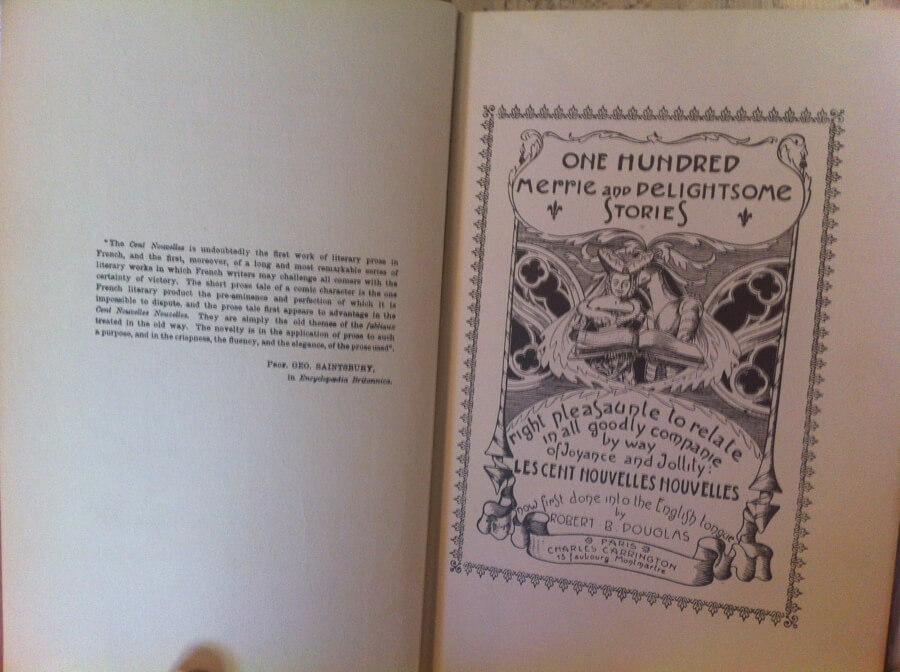
 One Hundred Merrie and Delightsome Stories, ed. by Antoine de La Sale, trans. Robert B. Douglas (Charles Carrington, Paris, 1899 [pirated facimile reprint, probably New York, c.1930 states "privately printed from the Charles Carrington Paris 1899 edition] #294/1250) 8" X 5.75", two volumes, xxx+532pp, pagination continuous. Fifty-two b&w plates by Léon Lebègue, marbled boards, gilt on spine, top edge gilt, other edges deckled, very good condition, minor bumping, some stains on front cover of vol. 2 Charles Carrington was the first to have this translated into English. This is a pirated copy, but still very nicely printed on good paper, the illustrations are in B&W. Purported a collection of short stories narrated by various persons at the court of Philippe le Bon, and collected together by Antoine de la Sale, the nouvelles are, according to the authority on French Literature—Professor George Saintsbury "undoubtedly the first work of literary prose in French ... The short prose tale of a comic character is the one French literary product the pre-eminence and perfection of which it is impossible to dispute, and the prose tale first appears to advantage in the Cent Nouvelles Nouvelles." The stories give a curious glimpses of life in the 15th century, providing a genuine view of the social condition of the nobility and the middle classes. M. Lenient, a French critic, says: "Generally the incidents and personages belong to the bourgeoisée; there is nothing chivalric, nothing wonderful; no dreamy lovers, romantic dames, fairies, or enchanters. Noble dames, bourgeois, nuns, knights, merchants, monks, and peasants mutually dupe each other. The lord deceives the miller's wife by imposing on her simplicity, and the miller retaliates in much the same manner. The shepherd marries the knight's sister, and the nobleman is not over scandalized. The vices of the monks are depicted in half a score tales, and the seducers are punished with a severity not always in proportion to the offence." For four centuries 10 of the stories were credited to Louis XI. Modern scholars have since ascribed them to either Philippe le Bel or Comte de Charolais. In all, some thirty-two noblemen or squires contributed the stories, with some 14 or 15 taken from Giovanni Boccaccio, and as many more from Gian Francesco Poggio Bracciolini or other Italian writers, or French fabliaux, but about 70 of them appear to be original.
One Hundred Merrie and Delightsome Stories, ed. by Antoine de La Sale, trans. Robert B. Douglas (Charles Carrington, Paris, 1899 [pirated facimile reprint, probably New York, c.1930 states "privately printed from the Charles Carrington Paris 1899 edition] #294/1250) 8" X 5.75", two volumes, xxx+532pp, pagination continuous. Fifty-two b&w plates by Léon Lebègue, marbled boards, gilt on spine, top edge gilt, other edges deckled, very good condition, minor bumping, some stains on front cover of vol. 2 Charles Carrington was the first to have this translated into English. This is a pirated copy, but still very nicely printed on good paper, the illustrations are in B&W. Purported a collection of short stories narrated by various persons at the court of Philippe le Bon, and collected together by Antoine de la Sale, the nouvelles are, according to the authority on French Literature—Professor George Saintsbury "undoubtedly the first work of literary prose in French ... The short prose tale of a comic character is the one French literary product the pre-eminence and perfection of which it is impossible to dispute, and the prose tale first appears to advantage in the Cent Nouvelles Nouvelles." The stories give a curious glimpses of life in the 15th century, providing a genuine view of the social condition of the nobility and the middle classes. M. Lenient, a French critic, says: "Generally the incidents and personages belong to the bourgeoisée; there is nothing chivalric, nothing wonderful; no dreamy lovers, romantic dames, fairies, or enchanters. Noble dames, bourgeois, nuns, knights, merchants, monks, and peasants mutually dupe each other. The lord deceives the miller's wife by imposing on her simplicity, and the miller retaliates in much the same manner. The shepherd marries the knight's sister, and the nobleman is not over scandalized. The vices of the monks are depicted in half a score tales, and the seducers are punished with a severity not always in proportion to the offence." For four centuries 10 of the stories were credited to Louis XI. Modern scholars have since ascribed them to either Philippe le Bel or Comte de Charolais. In all, some thirty-two noblemen or squires contributed the stories, with some 14 or 15 taken from Giovanni Boccaccio, and as many more from Gian Francesco Poggio Bracciolini or other Italian writers, or French fabliaux, but about 70 of them appear to be original. -

 Experiences of Flagellation: A Series of Remarkable Instances of Whipping Inflicted on Both Sexes, With Curious Anecdotes of Ladies Fond of Administering Birch Discipline., "compiled by An Amateur Flagallant" (Printed for Private Circulation, London, 1885, first edition) 5.25"x 8", 80pp, hardbound no DJ, tan boards with blue spine, fair condition for age, some bumping to boards, binding fragile but holding, split between first and second signature, page 15/16 detached. A great read! Forward asserts God ordained pain and punishment, even animals fear it, it is his police department, not to punish is to keep a boy out of God's school. The rod should be used ceremoniously. Even girls up to 18 have often ben greatly improved for life by "Dr. Spankster's" cure wisely administered. Sections include: Flogging Girls, Wife Beating, A Conjugal Scene, Lady Preparing for Birching, and many more.
Experiences of Flagellation: A Series of Remarkable Instances of Whipping Inflicted on Both Sexes, With Curious Anecdotes of Ladies Fond of Administering Birch Discipline., "compiled by An Amateur Flagallant" (Printed for Private Circulation, London, 1885, first edition) 5.25"x 8", 80pp, hardbound no DJ, tan boards with blue spine, fair condition for age, some bumping to boards, binding fragile but holding, split between first and second signature, page 15/16 detached. A great read! Forward asserts God ordained pain and punishment, even animals fear it, it is his police department, not to punish is to keep a boy out of God's school. The rod should be used ceremoniously. Even girls up to 18 have often ben greatly improved for life by "Dr. Spankster's" cure wisely administered. Sections include: Flogging Girls, Wife Beating, A Conjugal Scene, Lady Preparing for Birching, and many more. -
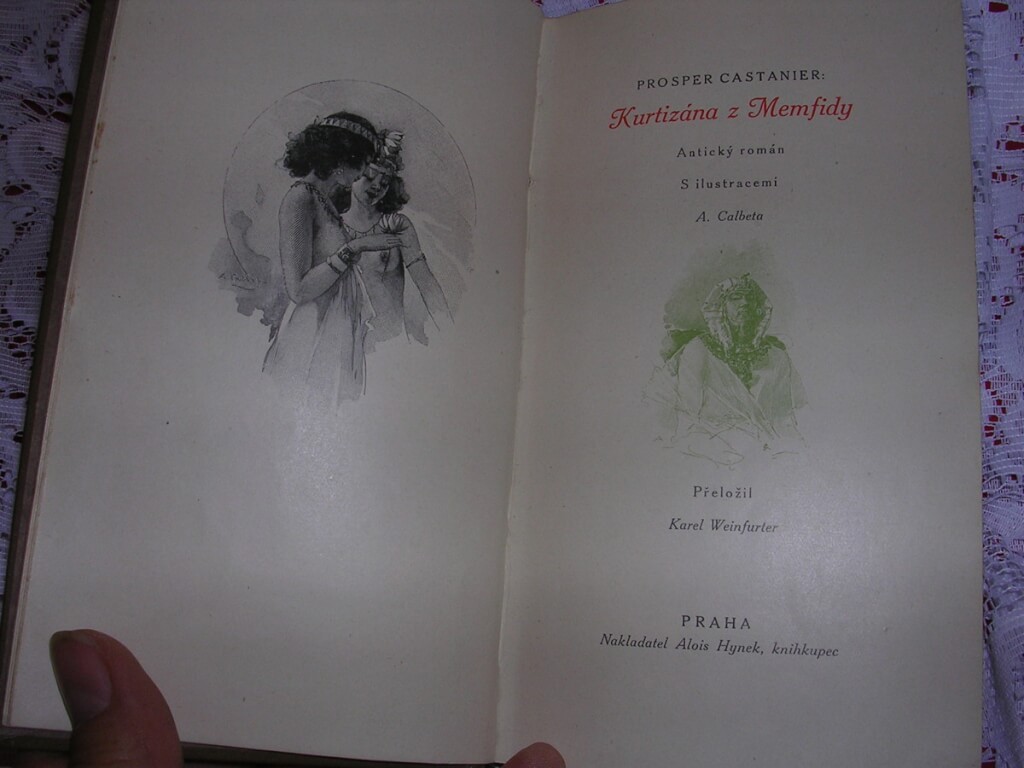
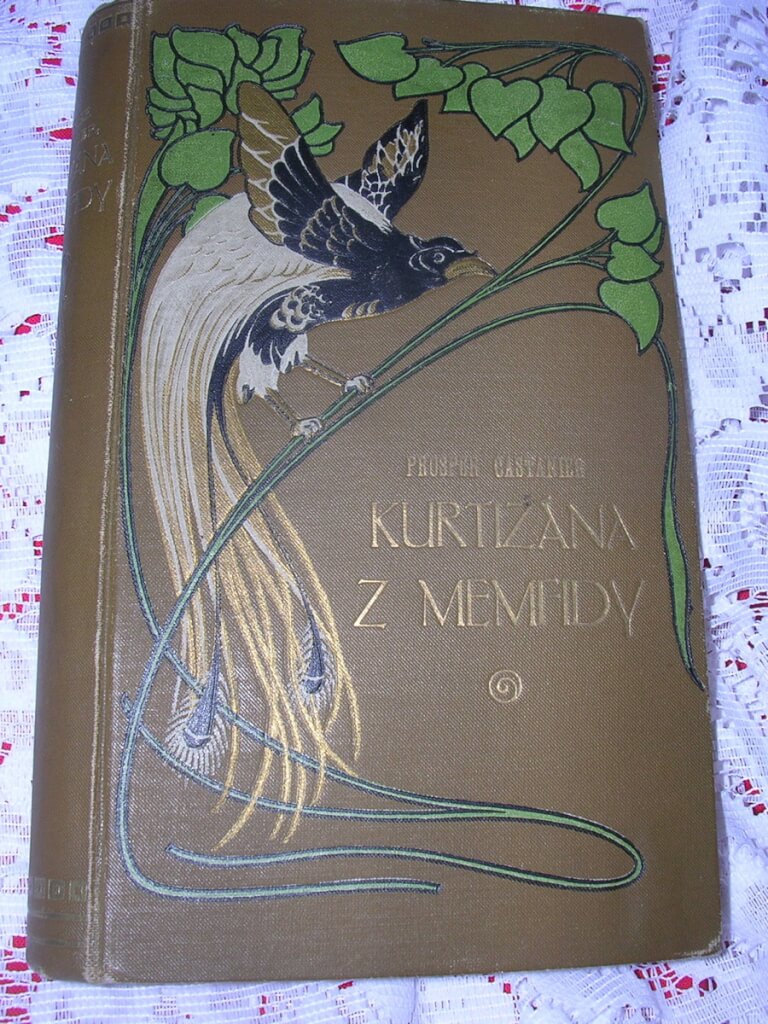 Kurtizána z Memfidy: Anticky román [Czech], Prosper Castanier, trans. Karel Weinfurter, illus. A. Calbeta (Alois Hynek, Praha [Prague], nd [c. 1901], printed by J. Rokyta, Praha) 7" x 4.5", 312pp, hardbound brown decorated cloth boards with gilt and other colors, gilt lettering and design on spine. Top edge gilt. Illustrated throughout with 4 choice illustrations duplicated in alternating red and green before title page. Great condition of a very rare book. This is a rare Czech translation of The Courtesan of Memphis, Czech Memfidy (Memphis) book, also in the rare publisher's original cloth-binding. The publisher, Alois Hynek, translated this and many of Castanier's books into German. These books had similiarly decorated covers. Most of the Hynek's Czech translations one finds are softcover. This is a rare hardcover translation into Czech. It is beautifully illustrated The French author, poet, novelist and historian Prosper Castanier (1865-19??) was born in Saint-Ambroix (Gard). He was the editor-in-chief of the "Progrès du midi". He had made a specialty of novels set in antiquity. (Particularly after the success of Aphrodite by Pierre Louès, published in 1896)
Kurtizána z Memfidy: Anticky román [Czech], Prosper Castanier, trans. Karel Weinfurter, illus. A. Calbeta (Alois Hynek, Praha [Prague], nd [c. 1901], printed by J. Rokyta, Praha) 7" x 4.5", 312pp, hardbound brown decorated cloth boards with gilt and other colors, gilt lettering and design on spine. Top edge gilt. Illustrated throughout with 4 choice illustrations duplicated in alternating red and green before title page. Great condition of a very rare book. This is a rare Czech translation of The Courtesan of Memphis, Czech Memfidy (Memphis) book, also in the rare publisher's original cloth-binding. The publisher, Alois Hynek, translated this and many of Castanier's books into German. These books had similiarly decorated covers. Most of the Hynek's Czech translations one finds are softcover. This is a rare hardcover translation into Czech. It is beautifully illustrated The French author, poet, novelist and historian Prosper Castanier (1865-19??) was born in Saint-Ambroix (Gard). He was the editor-in-chief of the "Progrès du midi". He had made a specialty of novels set in antiquity. (Particularly after the success of Aphrodite by Pierre Louès, published in 1896) -
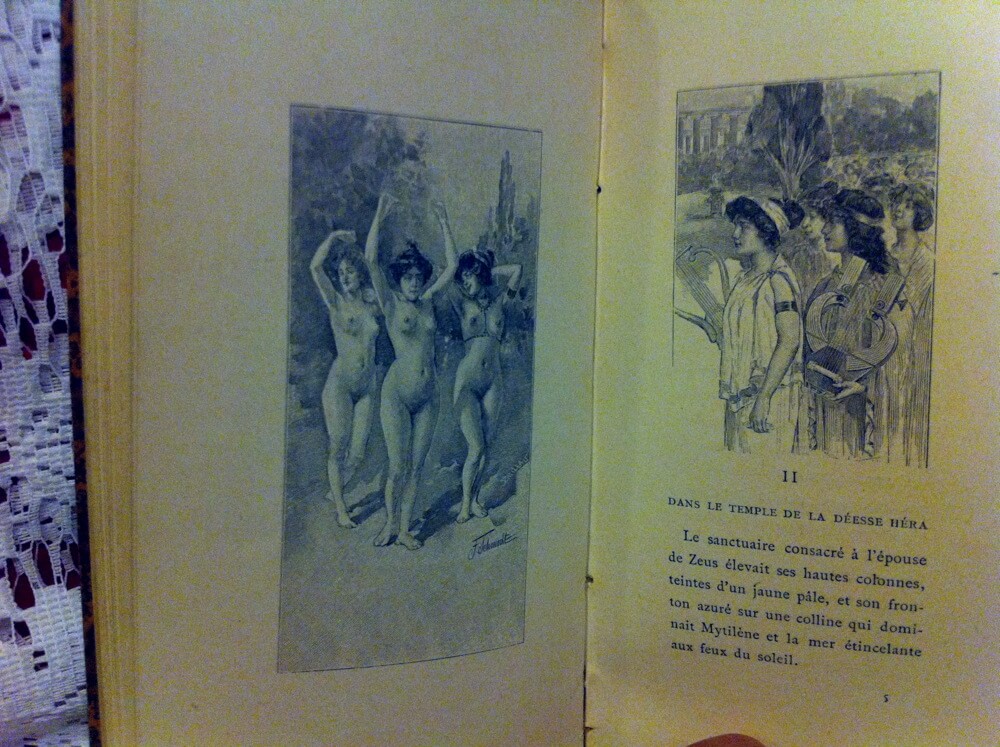
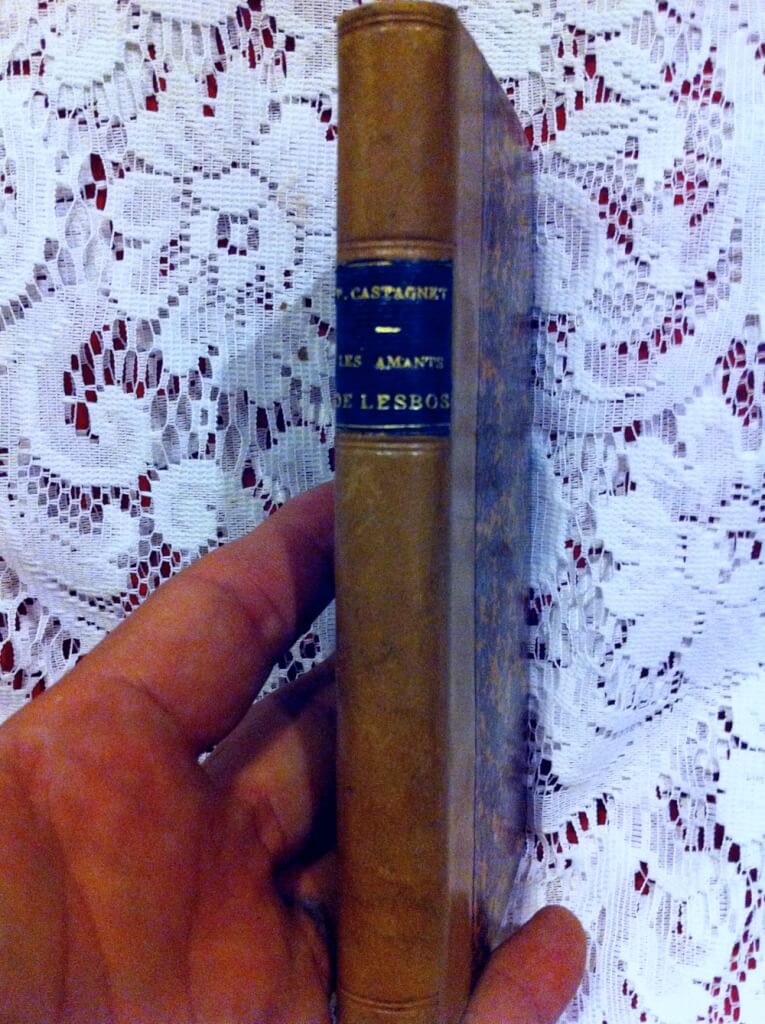 Les Amants de Lesbos, Prosper Castanier, illus. Franz Schmidt (Librairie L. Borel, Paris, 1900) 6" X 3.25", 116pp, Hardbound in 1/4 tan leather over marbled boards, marbled end-papers, glassine protective tissue for title page with gold emblem stamped on it. Very good condition. An imagination of the life and loves of the poet Sappho and her fight against the tyrant of Mytilene. The French author, poet, novelist and historian Prosper Castanier (1865-19??) was born in Saint-Ambroix (Gard). He was the editor-in-chief of the "Progrès du midi". He had made a specialty of novels set in antiquity. (Particularly after the success of Aphrodite by Pierre Louès, published in 1896)
Les Amants de Lesbos, Prosper Castanier, illus. Franz Schmidt (Librairie L. Borel, Paris, 1900) 6" X 3.25", 116pp, Hardbound in 1/4 tan leather over marbled boards, marbled end-papers, glassine protective tissue for title page with gold emblem stamped on it. Very good condition. An imagination of the life and loves of the poet Sappho and her fight against the tyrant of Mytilene. The French author, poet, novelist and historian Prosper Castanier (1865-19??) was born in Saint-Ambroix (Gard). He was the editor-in-chief of the "Progrès du midi". He had made a specialty of novels set in antiquity. (Particularly after the success of Aphrodite by Pierre Louès, published in 1896) -
 Marriage Ceremonies and Priapic Rites in India and the East, "by a member of the Royal Asiatic Society" (Printed for Private Circulation Only, 1909) 9" X 7.25", 107pp., hardbound, blue cloth boards, gilt and red titles on spine, top edge gilt. Very good condition, binding good hinges good. From forward: "The sentiments of Hindu Sages that follow have been chosen mostly from well-known books. They are instructive in many respects, and pretend to be nothing but a collection of notes made by the author while seeking a solution to his own doubts and difficulties... So this monograph--the subject of which is the one most intimately bound up with the life of every man and woman--will be found useful and interesting, both to the Aryans of the East, and to the Aryans of the West, and further needs no apology for its appearance."
Marriage Ceremonies and Priapic Rites in India and the East, "by a member of the Royal Asiatic Society" (Printed for Private Circulation Only, 1909) 9" X 7.25", 107pp., hardbound, blue cloth boards, gilt and red titles on spine, top edge gilt. Very good condition, binding good hinges good. From forward: "The sentiments of Hindu Sages that follow have been chosen mostly from well-known books. They are instructive in many respects, and pretend to be nothing but a collection of notes made by the author while seeking a solution to his own doubts and difficulties... So this monograph--the subject of which is the one most intimately bound up with the life of every man and woman--will be found useful and interesting, both to the Aryans of the East, and to the Aryans of the West, and further needs no apology for its appearance." -
 1601 A Tudor Fireside Conversation As Written by the Ingenuous, Virtuous and learned Mark Twain, wit., Embellished by the worthy Alan Odle, Mark Twain, illustrations Alan Odle (Land's End Press, USA, 1969, stated "At London, Printed for Subscribers Only and are to be sold at ye beare Back-Side in Maiden Lane") 8.75"x11.25", 24pp (unpaginated), hardbound with mylar-protected dust jacket, red boards with gilt titles [Date: 1601.] Conversation, as it was the Social Fireside, in the Time of the Tudors is the title of a humorous work by Mark Twain, first published anonymously in 1880. Edward Wagenknecht once referred to it as "the most famous piece of pornography in American literature." Its content is irreverent and vulgar rather than obscene, and its purpose seems to be comedic shock rather than erotic arousal. It would thus qualify as ribaldry rather than pornography. Twain wrote 1601 during the summer of 1876 (between writing Tom Sawyer and Huckleberry Finn), for the amusement of his closest friend, Reverend Joseph Twichell, 1601 was later first published by another friend, John Hay, who later became Secretary of State. The work circulated among printers (due to it's often archaic type font) and many small batches were printed, however the authorship of the work remained unverified until Twain finally acknowledged he wrote it in 1906.
1601 A Tudor Fireside Conversation As Written by the Ingenuous, Virtuous and learned Mark Twain, wit., Embellished by the worthy Alan Odle, Mark Twain, illustrations Alan Odle (Land's End Press, USA, 1969, stated "At London, Printed for Subscribers Only and are to be sold at ye beare Back-Side in Maiden Lane") 8.75"x11.25", 24pp (unpaginated), hardbound with mylar-protected dust jacket, red boards with gilt titles [Date: 1601.] Conversation, as it was the Social Fireside, in the Time of the Tudors is the title of a humorous work by Mark Twain, first published anonymously in 1880. Edward Wagenknecht once referred to it as "the most famous piece of pornography in American literature." Its content is irreverent and vulgar rather than obscene, and its purpose seems to be comedic shock rather than erotic arousal. It would thus qualify as ribaldry rather than pornography. Twain wrote 1601 during the summer of 1876 (between writing Tom Sawyer and Huckleberry Finn), for the amusement of his closest friend, Reverend Joseph Twichell, 1601 was later first published by another friend, John Hay, who later became Secretary of State. The work circulated among printers (due to it's often archaic type font) and many small batches were printed, however the authorship of the work remained unverified until Twain finally acknowledged he wrote it in 1906. -
 Sex Mythology | including an account of the | Masculine Cross, anonymous, Sha Rocco [Abisha S. Hudson] (Privately Printed, London, 1898, one of 200 copies unnumbered) 8.25" X 6", 64pp, quarter white cloth over grey boards, good condition, some bumping to corners, bookplate of Virginia & Edwin Irwin, bookseller stamp of George T. Juckes, London. An account of primitive symbolism and ancient phallic worship including Yoni, Shaga, Hebrew phallicism, Bacchic festivals, sexual rites, religious prostitution, and the mysteries of the ancient faiths. "The phallus and the sexual vocabulary of the Bible are explained within for the first time." The work is anonymous but much of the text comes from the writer of the preface, Sha Rocco, a pseudonym for Abisha S. Hudson. Abisha was born Abisha Shumway Hudson (1819-1905) was born in Oxford, Massachusetts one half of a pair of twins: his twin brother, Abijah T. Hudson, was never far from Abisha; the two trained as physicians together, lived together, and doctored together, in the midwest and on the west coast, even after they married. In April of 1855, Abisha radicalized, ordering a copy of Robert Taylor's infamous Diegesis from the bookstore of the Boston Investigator to hone his arguments as an anti-Christian free-thinker: the subtext for Sha Rocco's Masculine Cross. In 1874, The Masculine Cross and Ancient Sex Worship is published, by Asa K. Butts, a free-thought publisher in New York. Other published editions followed and he contributed to the present book published in London. Abisha was a public Spiritualist and the author of at least one other work "Tree and Serpent Worship" published around 1894, this time using his own name.
Sex Mythology | including an account of the | Masculine Cross, anonymous, Sha Rocco [Abisha S. Hudson] (Privately Printed, London, 1898, one of 200 copies unnumbered) 8.25" X 6", 64pp, quarter white cloth over grey boards, good condition, some bumping to corners, bookplate of Virginia & Edwin Irwin, bookseller stamp of George T. Juckes, London. An account of primitive symbolism and ancient phallic worship including Yoni, Shaga, Hebrew phallicism, Bacchic festivals, sexual rites, religious prostitution, and the mysteries of the ancient faiths. "The phallus and the sexual vocabulary of the Bible are explained within for the first time." The work is anonymous but much of the text comes from the writer of the preface, Sha Rocco, a pseudonym for Abisha S. Hudson. Abisha was born Abisha Shumway Hudson (1819-1905) was born in Oxford, Massachusetts one half of a pair of twins: his twin brother, Abijah T. Hudson, was never far from Abisha; the two trained as physicians together, lived together, and doctored together, in the midwest and on the west coast, even after they married. In April of 1855, Abisha radicalized, ordering a copy of Robert Taylor's infamous Diegesis from the bookstore of the Boston Investigator to hone his arguments as an anti-Christian free-thinker: the subtext for Sha Rocco's Masculine Cross. In 1874, The Masculine Cross and Ancient Sex Worship is published, by Asa K. Butts, a free-thought publisher in New York. Other published editions followed and he contributed to the present book published in London. Abisha was a public Spiritualist and the author of at least one other work "Tree and Serpent Worship" published around 1894, this time using his own name. -
 Ninety-Five Limericks | A Contribution to the Folk Lore of our Time | Collected and Edited by John Falmouth (The Limerick Press, Suffern, NY, 1932) 5"x7.25", unpaginated, protected DJ over tan cloth boards with red lettering and decorations, tears and soiling to DJ, some soiling on boards, interior good, previous owner added a limerick about a young man from Calcutta in the end pages. Mr. Falmouth has a 6 page forward where he discusses the phallic nature of the limerick (with diagrams). A fun little book even though the profanity is exed out.
Ninety-Five Limericks | A Contribution to the Folk Lore of our Time | Collected and Edited by John Falmouth (The Limerick Press, Suffern, NY, 1932) 5"x7.25", unpaginated, protected DJ over tan cloth boards with red lettering and decorations, tears and soiling to DJ, some soiling on boards, interior good, previous owner added a limerick about a young man from Calcutta in the end pages. Mr. Falmouth has a 6 page forward where he discusses the phallic nature of the limerick (with diagrams). A fun little book even though the profanity is exed out.












